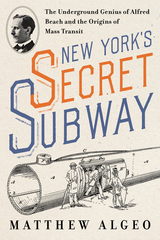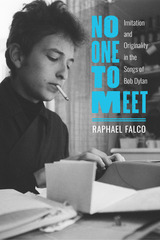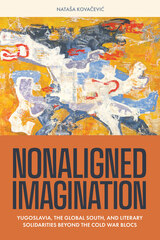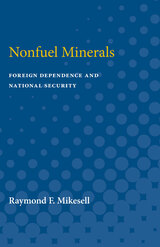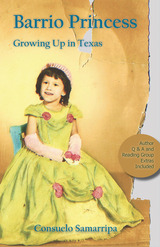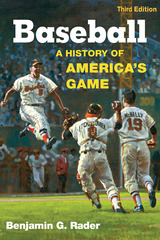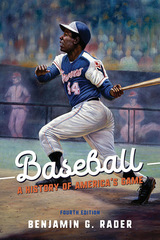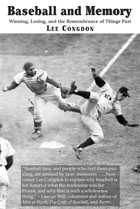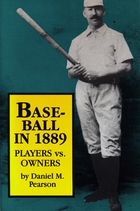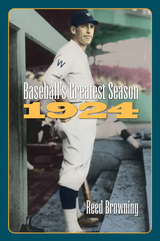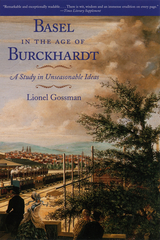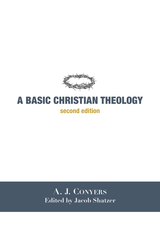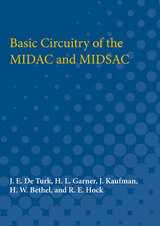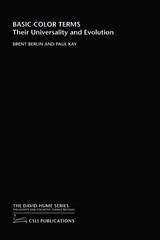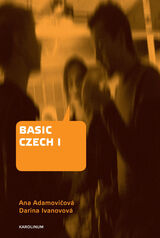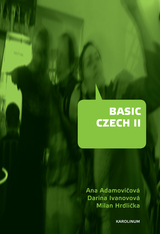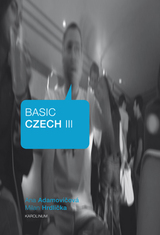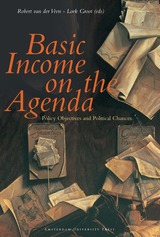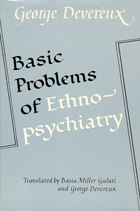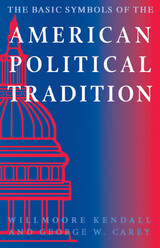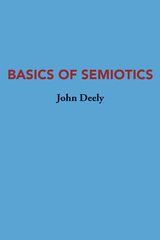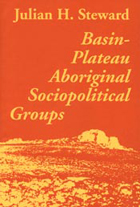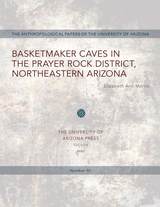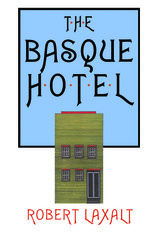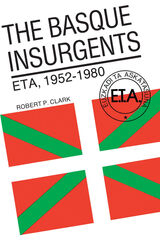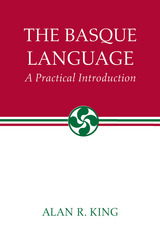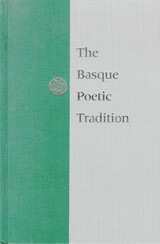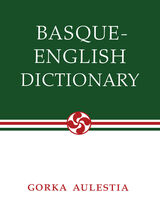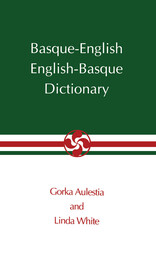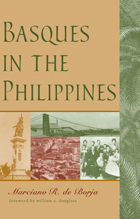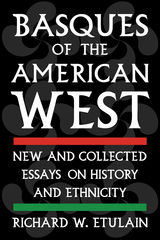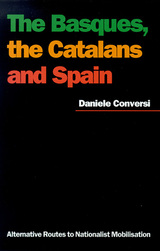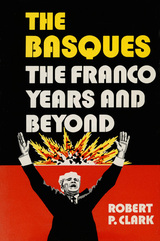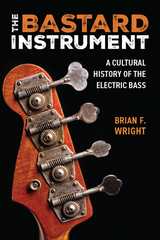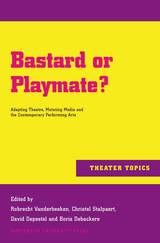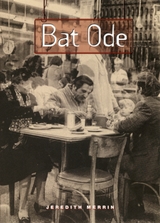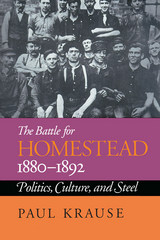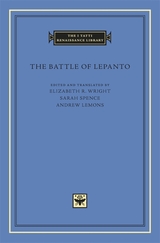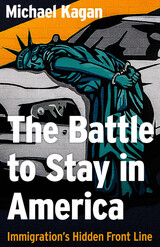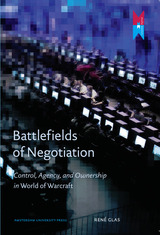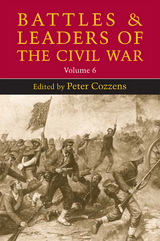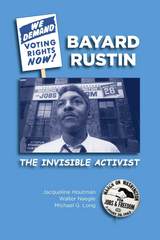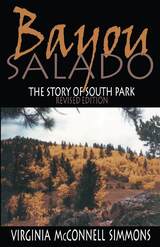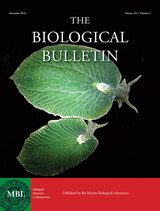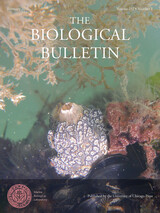Barrio Boy
Ernesto Galarza
University of Notre Dame Press, 1991 This is the true story of a Mexican boy who, with his family, made the journey from his mountain village in Mexico to the "barrio" of Sacramento. Once there, new experiences and influences shaped his outlook and widened his horizons. Contact with American life and education challenges Ernie to become aware of his own role in the life and movements of his new country.
----------
" ... an illuminating record of the forebodings of ordinary rural Mexicans at the beginning of the revolution." -The New York Review of Books
"Galarza's proud and moving book is a testament to who he is, where he came from, and to the country which received him and in which he has devoted his life fighting for both la justicia and justice." -Social Education Journal
 Barrio Boy: 40th Anniversary Edition
Ernesto Galarza
University of Notre Dame Press, 2011
About the Book
Since it was first published in 1971, Galarza's classic workhas been assigned in high school and undergraduate classrooms across the country, profoundly affecting thousands of students who read this true story of acculturation into American life.
To celebrate the 40th anniversary of the publication of Barrio Boy, the University of Notre Dame Press is proud to reissue this best-selling book with a new text design and cover, as well an introduction--by Ilan Stavans, the distinguished cultural critic and editor of the Norton Anthology of Latino Literature--which places Ernesto Galarza and Barrio Boyin historical context.
About the Author
Ernesto Galarza (1905-1984) was a labor organizer, historian, professor, and community activist. When he was eight, he migrated from Jalcocotan, Nayarit, Mexico, to Sacramento, California, where he worked as a farm laborer. He received a Ph.D. in history from Columbia University. In addition to Barrio Boy, he is the author of a number of books, including Strangers in Our Fields (1956), Merchants of Labor (1964), and Spiders in the House and Workers in the Fields (1970). In 1979, Dr. Galarza was nominated for the Nobel Prize in Literature.
"Unlike people who are born in hospitals, in an ambulance, or in a taxicab I showed up in an adobe cottage with a thatched roof that stood at one end of the only street of Jalcocotan, which everybody called Jalco for short. Like many other small villages in the wild, majestic mountains of the Sierra Madre de Nayarit, my pueblo was a hideaway. Even though you lived there, arriving in Jalco was always a surprise." --from Chapter 1
Reviews of the original edition:
". . . An illuminating record of the forebodings of ordinary rural Mexicans at the beginning of the revolution." -- The New York Review of Books
"With its suspense, humor, and occasional sadness, Barrio Boy is splendid reading." -- American Anthropologist
"Galarza's proud and moving book is a testament to who he is, where he came from, and to the country which received him and in which he has devoted his life fighting for both la justicia and justice." -- Social Education Journal
Barrio Boyis the remarkable story of one boy's journey from a Mexican village so small its main street didn't have a name, to the barrio of Sacramento, California, bustling and thriving in the early decades of the twentieth century. With vivid imagery and a rare gift for re-creating a child's sense of time and place, Ernesto Galarza gives an account of the early experiences of his extraordinary life--from revolution in Mexico to segregation in the United States--that will continue to delight readers for generations to come.
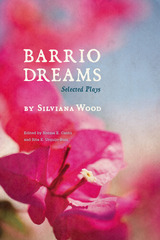 Barrio Dreams: Selected Plays
Silviana Wood; Edited by Norma E. Cantú and Rita E. Urquijo-Ruiz
University of Arizona Press, 2016 During the advent of Chicano teatro, dozens of groups sprang up across the country in Chicano/a communities. Since then, teatristas have been leading voices in the creation and production of plays touching minds and hearts that galvanize audiences to action.
Barrio Dreams is the first book to collect the work of one of Arizona’s foremost teatristas, playwright Silviana Wood. During her decades-long involvement in theater, Wood forged a reputation as a playwright, actor, director, and activist. Her works form a testimonio of Chicana life, steeped in art, politics, and the borderlands. Wood’s plays challenge, question, and incite women to consider their lot in life. She ruptures stereotypes and raises awareness of social issues via humor and with an emphasis on the use of the physical body on stage.
The play Una vez, en un barrio de sueños . . . offers a glimpse into familiar terrain—the barrio and its dwellers—in three actos. In Amor de hija, a fraught mother-daughter relationship in contemporary working-class Arizona is dealt an additional blow as the family faces Alzheimer’s disease. In the tragedy A Drunkard’s Tale of Melted Wings and Memories, and in the trilingual (Spanish, English, and Yaqui) tragicomedy Yo, Casimiro Flores, characters love, live, die, travel through time and space, and visit the afterlife. And in Anhelos por Oaxaca, a grandfather travels back in time through flashbacks, as he and his grandson travel through homelands from Arizona to Oaxaca.
Part of Wood’s genius is the way she portrays life in what Gloria Anzaldúa called “el mundo zurdo,” that space inhabited by the people of color, the poor, the female, and the outsiders. It is a place for the atravesados, the odd, the different, those who do not fit the mainstream. The people who inhabit Wood’s plays are common folk—janitors, mothers, grandmothers, and teenagers—hardworking people who, in one way or another, have made their way in life and who embody life in the barrio.
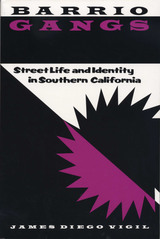 Barrio Gangs: Street Life and Identity in Southern California
By James Diego Vigil
University of Texas Press, 1988 Within the Mexican American barrios of Los Angeles, gang activity, including crime and violent acts, has grown and flourished. In the past, community leaders and law enforcement officials have approached the problem, not as something that needs to be understood, but only as something to be gotten rid of. Rejecting that approach, James D. Vigil asserts that only by understanding the complex factors that give birth and persistence to gangs can gang violence be ended. Drawing on many years of experience in the barrios as a youth worker, high school teacher, and researcher, Vigil identifies the elements from which gangs spring: isolation from the dominant culture, poverty, family stress and crowded households, peer pressure, and the adolescent struggle for self-identity. Using interviews with actual gang members, he reveals how the gang often functions as parent, school, and law enforcement in the absence of other role models in the gang members' lives. And he accounts for the longevity of gangs, sometimes over decades, by showing how they offer barrio youth a sense of identity and belonging nowhere else available.
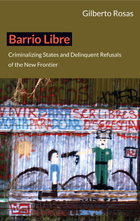 Barrio Libre: Criminalizing States and Delinquent Refusals of the New Frontier
Gilberto Rosas
Duke University Press, 2012 The city of Nogales straddles the border running between Arizona and Sonora, Mexico. On the Mexican side, marginalized youths calling themselves Barrio Libre (Free 'Hood) employ violence, theft, and bribery to survive, often preying on undocumented migrants who navigate the city's sewer system to cross the US-Mexico border. In this book, Gilberto Rosas draws on his in-depth ethnographic research among the members of Barrio Libre to understand why they have embraced criminality and how neoliberalism and security policies on both sides of the border have affected the youths' descent into Barrio Libre. Rosas argues that although these youths participate in the victimization of others, they should not be demonized. They are complexly and adversely situated. The effects of NAFTA have forced many of them, as well as other Mexicans, to migrate to Nogales. Moving fluidly with the youths through the spaces that they inhabit and control, he shows how the militarization of the border actually destabilized the region and led Barrio Libre to turn to increasingly violent activities, including drug trafficking. By focusing on these youths and their delinquency, Rosas demonstrates how capitalism and criminality shape perceptions and experiences of race, sovereignty, and resistance along the US-Mexico border.
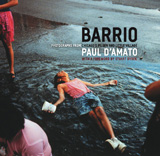 Barrio: Photographs from Chicago's Pilsen and Little Village
Paul D'Amato
University of Chicago Press, 2006 In 1988 photographer Paul D’Amato was driving around Chicago with his camera when he decided to follow Halsted Street into Pilsen, the city’s largest Mexican neighborhood. Intrigued by the barrio and neighboring Little Village, he began to take photographs and would continue to do so off and on for the next fourteen years. D’Amato started with the public life of the neighborhood: women and children in the streets, open fire hydrants, and graffiti. But later—after he got to know the area’s Mexican residents better—he was allowed to take more intimate photos of people at work, families at weddings and parties, and even gang members.
Barrio collects ninety of these striking color images along with D’Amato’s fascinating account of his time photographing Mexican Chicago and his acceptance—often grudging, after threatened violence—into the heart of the city’s Mexican community. Some of the photos here are beautifully composed and startling—visual narratives that are surreal and dreamlike, haunting and mythic. Others, like those D’Amato took while shadowing graffiti artists in the subway, are far more immediate and improvisational. With a foreword by author Stuart Dybek that places D’Amato’s work in the context of the Pilsen and Little Village that Dybek has elsewhere captured so memorably, this book offers a penetrating, evocative, and overall streetwise portrait of two iconic and enduring Hispanic neighborhoods.
Barrio Princess: Growing Up in Texas
Consuelo Samarripa
Parkhurst Brothers, Inc., 2014 "Made in Mexico, born in America," Barrio Princess shares heartwarming family stories, cultural tradition stories, learning English by total immersion, socialization as a minority, education, stories of her mother as a single parent, and women’s stories from a minority point of view.
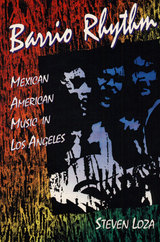 Barrio Rhythm: Mexican American Music in Los Angeles
Steven Loza
University of Illinois Press, 1993 The hit movie La Bamba (based on the life of Richie Valens), the versatile singer Linda Ronstadt, and the popular rock group Los Lobos all have roots in the dynamic music of the Mexican American community in East Los Angeles. The "Eastside Renaissance" in the region gave barrio music a symbolic power throughout the Southwest, yet its story has remained undocumented and virtually untold. In Barrio Rhythm, Steven Loza brings this hidden history to life, demonstrating the music's essential role in the cultural development of East Los Angeles and its influence on mainstream popular culture. Drawing from oral histories and other primary sources, as well as from appropriate representative songs, Loza provides a historical overview of the music from the nineteenth century to the present and offers in-depth profiles of nine Mexican American artists, groups, and entrepreneurs in Southern California from the post-World War II era to the present. His interviews with many of today's most influential barrio musicians, including members of Los Lobos, chronicle the cultural forces active in this complex urban community.
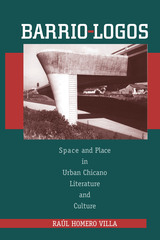 Barrio-Logos: Space and Place in Urban Chicano Literature and Culture
By Raúl Homero Villa
University of Texas Press, 2000 Struggles over space and resistance to geographic displacement gave birth to much of Chicano history and culture. In this pathfinding book, Raúl Villa explores how California Chicano/a activists, journalists, writers, artists, and musicians have used expressive culture to oppose the community-destroying forces of urban renewal programs and massive freeway development and to create and defend a sense of Chicano place-identity. Villa opens with a historical overview that shows how Chicano communities and culture have grown in response to conflicts over space ever since the United States' annexation of Mexican territory in the 1840s. Then, turning to the work of contemporary members of the Chicano intelligentsia such as Helena Maria Viramontes, Ron Arias, and Lorna Dee Cervantes, Villa demonstrates how their expressive practices re-imagine and re-create the dominant urban space as a community enabling place. In doing so, he illuminates the endless interplay in which cultural texts and practices are shaped by and act upon their social and political contexts.
Barrios in Arms: Revolution in Santo Domingo
Jose A. Moreno
University of Pittsburgh Press, 1970 Sociologist José A. Moreno was doing fieldwork in Santo Domingo when the revolution broke out in April 1965. For four months he lived in the rebel zone of the city, where he helped with the organization of medical clinics and food distribution centers. His activities brought him into daily contact with top leaders of the rebel forces, members of political organizations, commando groups of young men from the barrios of Santo Domingo, and ordinary citizens in the neighborhood. His eye-witness account is augmented by his professional analysis of the rebels-their backgrounds, personalities, ideologies, and expectations. He also focuses on the social processes that brought cohesiveness to the divergent rebel groups as their faced a common enemy.
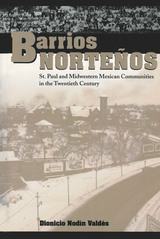 Barrios Norteños: St. Paul and Midwestern Mexican Communities in the Twentieth Century
By Dionicio Nodín Valdés
University of Texas Press, 2000 Mexican communities in the Midwestern United States have a history that extends back to the turn of the twentieth century, when a demand for workers in several mass industries brought Mexican agricultural laborers to jobs and homes in the cities. This book offers a comprehensive social, labor, and cultural history of these workers and their descendants, using the Mexican barrio of "San Pablo" (St. Paul) Minnesota as a window on the region. Through extensive archival research and numerous interviews, Dennis Valdés explores how Mexicans created ethnic spaces in Midwestern cities and how their lives and communities have changed over the course of the twentieth century. He examines the process of community building before World War II, the assimilation of Mexicans into the industrial working class after the war, the Chicano Movement of the 1960s and 1970s, and more recent changes resulting from industrial restructuring and unprecedented migration and population growth. Throughout, Valdés pays particular attention to Midwestern Mexicans' experiences of inequality and struggles against domination and compares them to Mexicans' experiences in other regions of the U.S.
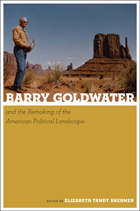 Barry Goldwater and the Remaking of the American Political Landscape
Edited by Elizabeth Tandy Shermer
University of Arizona Press, 2013 Nearly four million Americans worked on Barry Goldwater’s behalf in the presidential election of 1964. These citizens were as dedicated to their cause as those who fought for civil rights and against the Vietnam War. Arguably, the conservative agenda that began with Goldwater has had effects on American politics and society as profound and far reaching as the liberalism of the 1960s. According to the essays in this volume, it’s high time for a reconsideration of Barry Goldwater’s legacy.
Since Goldwater’s death in 1998, politicians, pundits, and academics have been assessing his achievements and his shortcomings. The twelve essays in this volume thoroughly examine the life, times, and impact of “Mr. Conservative.” Scrutinizing the transformation of a Phoenix department store owner into a politician, de facto political philosopher, and five-time US senator, contributors highlight the importance of power, showcasing the relationship between the nascent conservative movement’s cadre of elite businessmen, newsmen, and intellectuals and their followers at the grassroots—or sagebrush—level.
Goldwater, who was born in the Arizona Territory in 1909, was deeply influenced by his Western upbringing. With his appearance on the national stage in 1964, he not only articulated a new brand of conservatism but gave a voice to many Americans who were not enamored with the social and political changes of the era. He may have lost the battle for the presidency, but he energized a coalition of journalists, publishers, women’s groups, and Southerners to band together in a movement that reshaped the nation.
 Barry Le Va: The Aesthetic Aftermath
Michael Maizels
University of Minnesota Press, 2015 Of the conceptual artists who began their careers in the 1960s and 1970s—Bruce Nauman, Chris Burden, Vito Acconci, and Mel Bochner among them—Barry Le Va may be the most elusive. As this first study of his work reveals, his rigorously planned art was instigated to mask its creator’s intentions and methods, presenting itself as an “aftermath” of modernism’s claim to permanency and civil society’s preferred mode of monumentalism. For Michael Maizels, Le Va’s work constitutes a particularly productive subject of inquiry because it clearly articulates the interconnection between the avant-garde’s distrust of autonomous art objects, two decades of social unrest, the emergence of information theory, and lingering notions of scientific objectivity. Barry Le Va: The Aesthetic Aftermath explores how Le Va used such materials as shattered glass, spent bullets, sound recordings, scattered flour, and meat cleavers embedded in a floor to challenge the interlocking assumptions behind blind faith in lasting beauty, just government, and perfectible knowledge. Taking inspiration from popular crime novels as well as contemporary art theory, Le Va charged his viewers to attempt, like detectives at a crime scene, to decipher an order underlying the apparent chaos. Le Va’s installations were designed to erode not simply the presumed autonomy of the art object but also the economic and political authority of the art establishment. In his concluding chapter, Maizels looks at the more fixed work of the past two decades in which Le Va turned to architectural themes and cast concrete to probe the limits of dynamism and the idea of permanence.
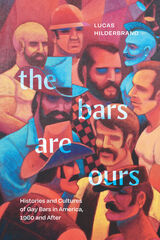 The Bars Are Ours: Histories and Cultures of Gay Bars in America,1960 and After
Lucas Hilderbrand
Duke University Press, 2024 Gay bars have operated as the most visible institutions of the LGBTQ+ community in the United States for the better part of a century, from before gay liberation until after their assumed obsolescence. In The Bars Are Ours Lucas Hilderbrand offers a panoramic history of gay bars, showing how they served as the medium for queer communities, politics, and cultures. Hilderbrand cruises from leather in Chicago and drag in Kansas City to activism against gentrification in Boston and racial discrimination in Atlanta; from New York City’s bathhouses, sex clubs, and discos and Houston’s legendary bar Mary’s to the alternative scenes that reimagined queer nightlife in San Francisco and Latinx venues in Los Angeles. The Bars Are Ours explores these local sites (with additional stops in Denver, Detroit, Seattle, Philadelphia, Minneapolis, and Orlando as well as Wisconsin, Pennsylvania, and Texas) to demonstrate the intoxicating---even world-making---roles that bars have played in queer public life across the country.
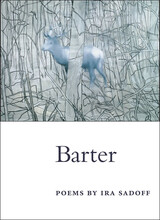 Barter: POEMS
Ira Sadoff
University of Illinois Press, 2003 Ira Sadoff’s new volume of poems opens with a quotation from Rilke: “But because truly being here is so much; because everything here / apparently needs us, the fleeting world, which in some strange way / keeps calling us. . . .” The poetry collected here is a response to this call.
Rooted firmly in the “fleeting world,” Sadoff’s poems find epiphanies of meaning in unexpected and even unpleasant experiences and emotions. The poems in Barter delve deeply into the past, the personal past of regret, travel, love, divorce, and bereavement, as well as the global past of Beethoven, Vietnam, and the fall of communism. Each poem is offered up by Sadoff as a barter, something to be traded for a little more time, a little more understanding.
The poems in Barter comment on the power of culture to interject itself into our desire for an idealized self, the way our inner and outer lives lack correspondence, harmony, and integration. They also talk about commerce, the trading of bodies, the way we as a nation “use” and exchange and appropriate -- and like Tolstoy’s Ivan Ilyich, try to bargain with and evade the urgency of our time on earth.
In the poem “Self-Portrait with a Critic,” Sadoff makes what could be a succinct statement of purpose: “And inside, let’s not make it pretty, / let’s save the off-rhyme and onomatopoeia / / for the concert hall, let’s go to the wormy place / where the problematic stirs inside his head.”
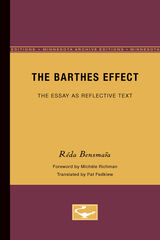 The Barthes Effect: The Essay as Reflective Text
Réda BensmaïaTranslated by Pat FedkiewForeword by Michèle H. Richman
University of Minnesota Press, 1987
The Barthes Effect was first published in 1987. Minnesota Archive Editions uses digital technology to make long-unavailable books once again accessible, and are published unaltered from the original University of Minnesota Press editions.
The author acknowledges the essay as an eccentric phenomenon in literary history, one that has long resisted entry into the taxonomy of genres, as it concentrates on four works by Roland Barthes: The Pleasure of the Text, A Lover's Discourse, Roland Barthes by Roland Barthes, and Camera Lucida. Maintains that with Barthes the essay achieves a status of its own, as reflective text.
". . . a study rigorously conscious of the critical maneuvers it executes and, more importantly, questions as critical practice . . . " Bensmaïa's strategy produces a successful investigation of the interstices and slippages of meaning which Barthes addressed in his work." SubStance
Reda Bensmaia is associate professor in the departments of French and comparative literature at the University of Minnesota, and translator Pat Fedkiew, a graduate student in French at Minnesota. Michele Richman is associate professor of French at the University of Pennsylvania and author of Reading Georges Bataille: Beyond the Gift.
 The Barthes Fantastic: Literature, Criticism, and the Practice of Language
John Lurz
University of Chicago Press, 2025 This study of the writing of Roland Barthes breaks down the divide between lived experience and the language of a literary work.
In The Barthes Fantastic, John Lurz explores the intersection of literature and everyday life—and confronts some habits of literary study—through a reading of the work of Roland Barthes. An influential French theorist, Barthes wrote prolifically on the place of language and the play of signs in the ways we produce cultural and aesthetic meaning. Ranging across the entire sweep of Barthes’s varied career, Lurz shows how Barthes’s insights into signification and literature involve particular intellectual activities that impart significance to the world. Doing so allows him to develop an expanded understanding of the fantastic as a conceptual category—a way of thinking—in which the texts we read come to inform the texture of our real lives. Ultimately, The Barthes Fantastic enlarges our sense of what we learn as students of literature and gives us a new picture of a writer we thought we knew.
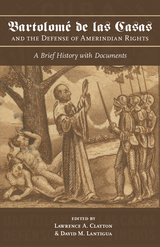 Bartolomé de las Casas and the Defense of Amerindian Rights: A Brief History with Documents
Edited by Lawrence A. Clayton and David M. Lantigua
University of Alabama Press, 2020 An accessible reader of both popular and largely unavailable writings of Bartolomé de las Casas
With the exception of Christopher Columbus, Bartolomé de las Casas is arguably the most notable figure of the Encounter Age. He is remembered principally as the creator of the Black Legend, as well as the protector of American Indians. He was one of the pioneers of the human rights movement, and a Christian activist who invoked law and Biblical scripture to challenge European colonialism in the great age of the Encounter. He was also one of the first and most thorough chroniclers of the conquest, and a biographer who saved the diary of Columbus’s first voyage for posterity by transcribing it in his History of the Indies before the diary was lost.
Bartolomé de las Casas and the Defense of Amerindian Rights: A Brief History with Documents provides the most wide-ranging and concise anthology of Las Casas’s writings, in translation, ever made available. It contains not only excerpts from his most well-known texts, but also his largely unavailable writings on political philosophy and law, and addresses the underappreciated aspects of his thought. Fifteen of the twenty-six documents are entirely new translations of Las Casas’s writings, a number of them appearing in English for the first time.
This volume focuses on his historical, political, and legal writings that address the deeply conflicted and violent sixteenth-century encounter between Europeans and indigenous peoples of the Americas. It also presents Las Casas as a more comprehensive and systematic philosophical and legal thinker than he is typically given credit for. The introduction by Lawrence A. Clayton and David M. Lantigua places these writings into a synthetic whole, tracing his advocacy for indigenous peoples throughout his career. By considering Las Casas’s ideas, actions, and even regrets in tandem, readers will understand the historical dynamics of Spanish imperialism more acutely within the social-political context of the times.
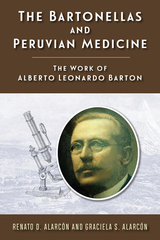 The Bartonellas and Peruvian Medicine: The Work of Alberto Leonardo Barton
Alarcón, Graciela S
Rutgers University Press, 2019 The Bartonellas and Peruvian Medicine explores the events surrounding the discovery of the etio-pathogenic agent of the Oroya Fever, also known as Peruvian Verruga or Carrión’s disease (an endemic infectious disease in South America’s Andean regions) by Dr. Alberto Leonardo Barton. Graciela S. Alarcón and Renato D. Alarcón recount Barton’s persistent work against skepticism, obstacles, and limitations imposed by members of Peru’s medical elites of the time, as well as his eventual successful scientific career and the delayed but well-deserved global recognition of his contributions.
The book is the result of intense bibliographic research and of original documents aimed not just at the examination of Barton’s life and work, but also the examination of today’s perspectives and future work in the field of infectious and “neglected” diseases. The authors address current scientific information on the relevant bacteria Bartonella bacilliformis, besides current research and clinical status of the other Bartonellas, making it a useful and practical text for those studying infectious diseases.
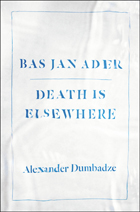 Bas Jan Ader: Death Is Elsewhere
Alexander Dumbadze
University of Chicago Press, 2013 On July 9, 1975, Dutch-born artist Bas Jan Ader set sail from Chatham, Massachusetts, on a thirteen-foot sailboat. He was bound for Falmouth, England, on the second leg of a three-part piece titled In Search of the Miraculous. The damaged boat was found south of the western tip of Ireland nearly a year later. Ader was never seen again. Since his untimely death, Ader has achieved mythic status in the art world as a figure literally willing to die for his art. Considering the artist’s legacy and concise oeuvre beyond the romantic and tragic associations that accompany his peculiar end, Alexander Dumbadze resituates Ader’s art and life within the conceptual art world of Los Angeles in the early 1970s and offers a nuanced argument about artistic subjectivity that explains Ader’s tremendous relevance to contemporary art. Bas Jan Ader blends biography, theoretical reflection, and archival research to draw a detailed picture of the world in which Ader’s work was rooted: a vibrant international art scene populated with peers such as Ger van Elk, William Leavitt, and Allen Ruppersberg. Dumbadze looks closely at Ader’s engagement with questions of free will and his ultimate success in creating art untainted by mediation. The first in-depth study of this enigmatic conceptual artist, Bas Jan Ader is a thoughtful reflection on the necessity of the creative act and its inescapable relation to death.
Baseball: A History of America's Game
Benjamin G. Rader
University of Illinois Press, 2007 In this third edition of his lively history of America's game--widely recognized as the best of its kind--Benjamin G. Rader expands his scope to include commentary on Major League Baseball through the 2006 season: record crowds and record income, construction of new ballparks, a change in the strike zone, a surge in recruiting Japanese players, and an emerging cadre of explosive long-ball hitters.
Baseball: A History of America's Game
Benjamin G. Rader
University of Illinois Press, 2018 In this fourth edition, Benjamin G. Rader updates the text with a portrait of baseball's new order. He charts an on-the-field game transformed by analytics, an influx of Latino and Asian players, and a generation of players groomed for brute power both on the mound and at the plate. He also analyzes the behind-the-scenes revolution that brought in billions of dollars from a synergy of marketing and branding prowess, visionary media development, and fan-friendly ballparks abuzz with nonstop entertainment. The result is an entertaining and comprehensive tour of a game that, whatever its changes, always reflects American society and culture.
Baseball: A HIstory of America's Game
Benjamin G. Rader
University of Illinois Press, 2025 Analytics, technology, and the most ambitious rewrite of the rulebook in fifty years have reshaped baseball. Benjamin G. Rader’s account of the American pastime moves from diamonds scratched out of commons and corn fields to the multimedia theme parks doubling as today’s baseball stadiums. The fifth edition follows the long arc of the game’s history into the third decade of the twenty-first century, an era rich in innovation but even richer from revenue streams undreamt-of by the plutocrats of old. Rader brings readers up to date with looks at the Astros cheating scandal, on-the-field changes from power pitchers to ghost runners, data-driven player development and career rebirth, and the one-of-a-kind Shohei Ohtani. Engrossing and complete, Baseball, Fifth Edition, offers a comprehensive tour of the game and its place within American society and culture.
Baseball and Country Music
Don Cusic
University of Wisconsin Press, 2003 The histories of baseball and country music ran in parallel tracks through most of the twentieth century. America’s sport and America’s music moved from the fringes to the mainstream, gaining exposure and building heroes, first via radio broadcasts and then on the television screen. Both evolved with American society through wartime, the Civil Rights movement, and into the age of multimillion dollar superstars. Don Cusic offers an engaging and insightful analysis that addresses race, gender, class, ethnicity, business practices and marketing, performance, media, and the cult of celebrity.
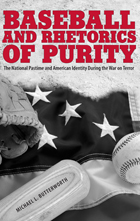 Baseball and Rhetorics of Purity: The National Pastime and American Identity During the War on Terror
Michael L. Butterworth
University of Alabama Press, 2010 An investigation into the culture and mythology of baseball, a study of its limits and failures, and an invitation to remake the game in a more democratic way. Baseball has long been considered America’s “national pastime,” touted variously as a healthy diversion, a symbol of national unity, and a model of democratic inclusion. But, according to Michael Butterworth, such favorable rhetoric belies baseball’s complicity in the rhetorical construction of a world defined by good and evil. Baseball and Rhetorics of Purity is an investigation into the culture and mythology of baseball, a study of its limits and failures, and an invitation to remake the game in a more democratic way. It pays special attention to baseball’s role in the reconstruction of American identity after September 11, 2001. This study is framed by a discussion that links the development of baseball to the discourses of innocence and purity in 19th-century America. From there, it examines ritual performances at baseball games; a traveling museum exhibit sponsored by the National Baseball Hall of Fame and Museum; the recent debate about the use of performance-enhancing drugs; the return of Major League Baseball to Washington, D.C., in 2005; and the advent of the World Baseball Classic in 2006. Butterworth argues that by promoting myths of citizenship and purity, post-9/11 discourse concerning baseball ironically threatens the health of the democratic system and that baseball cannot be viewed as an innocent diversion or escape. Instead, Butterworth highlights how the game on the field reflects a more complex and diverse worldview, and makes a plea for the game’s recovery, both as a national pastime and as a site for celebrating the best of who we are and who we can be.
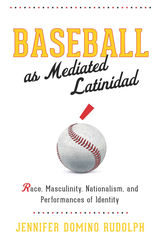 Baseball as Mediated Latinidad: Race, Masculinity, Nationalism, and Performances of Identity
Jennifer Domino Rudolph
Ohio State University Press, 2020 In her incisive study Baseball as Mediated Latinidad: Race, Masculinity, Nationalism, and Performances of Identity, Jennifer Domino Rudolph analyzes major league baseball’s Latin/o American players—who now make up more than twenty-five percent of MLB—as sites of undesirable surveillance due to the historical, political, and sociological weight placed on them via stereotypes around immigration, crime, masculinity, aggression, and violence. Rudolph examines the perception by media and fans of Latino baseball players and the consumption of these athletes as both social and political stand-ins for an entire culture, showing how these participants in the nationalist game of baseball exemplify tensions over race, nation, and language for some while simultaneously revealing baseball as a practice of latinidad, or pan-Latina/o/x identity, for others. By simultaneously exploring the ways in which Latino baseball players can appear both as threats to American values and the embodiment of the American Dream, and engaging with both archival research and new media representations of MLB players, Rudolph sheds new light on the current ambivalence of mainstream American media and fans towards Latin/o culture.
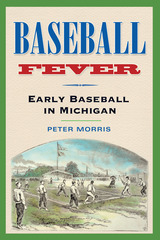 Baseball Fever: Early Baseball in Michigan
Peter Morris
University of Michigan Press, 2003 Baseball seems tailor-made for the historian, yet even today, after almost a century and a half of organized play, baseball's origins remain unclear. Most accounts focus on Eastern teams and the advent of professionals, but how the game spread across a predominantly rural America to become our national pastime is a question still largely unresolved. In this well-researched study of Michigan baseball from the 1830s to the 1870s, baseball scholar Peter Morris offers many answers. Drawing on such sources as personal memoirs, period photographs, and an extensive, often hilarious variety of newspaper accounts, he paints a vivid portrait of a game that was widely---if erratically---played well before the Civil War and gradually evolved from an informal amusement into an activity for local groups of young men and finally into a serious, organized sport. Baseball began with pick-up "raisin'" games---so called because they took place after rural roof-raisings---played purely for fun by any number of participants, with myriad local variations. The first amateur clubs appeared in the 1850s and were often ridiculed for playing a child's game---"baseball fever" was then a term of mockery---but as they persevered and issued challenges to other teams from nearby towns, rivalries developed, rules began to conform, and a tradition started to take shape. Tournaments, often connected with county fairs, and increased newspaper coverage gave the game new momentum after the Civil War, and what had been sociable matches became serious contests, sometimes marred by bad blood. Enclosed grounds changed the nature of the game--most notably with respect to home runs--and allowed teams to charge admission, which introduced a new element of commercialism, community involvement, and a heightened sense of competition. Ultimately, it brought about a level of play that made the best "amateur" clubs able to challenge professional teams from the East when they toured the country. As he traces the exploits of clubs like the Excelsiors, the Wahoos, and the Unknowns, season by season and often game by game, Morris adds a wealth of new detail to the story of baseball's early days, showing how decades of at least nominally amateur play prepared the way for the advent of the National League in the 1870s, and with it the true beginnings of the professional sport we know today. In the process, he also paints a fascinating portrait of the attitudes, values, and lives of rural Americans in the mid-nineteenth century.
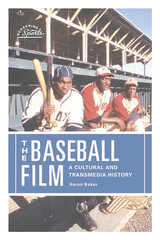 The Baseball Film: A Cultural and Transmedia History
Aaron Baker
Rutgers University Press, 2022 Baseball has long been viewed as the Great American Pastime, so it is no surprise that the sport has inspired many Hollywood films and television series. But how do these works depict the game, its players, fans, and place in American society?
This study offers an extensive look at nearly one hundred years of baseball-themed movies, documentaries, and TV shows. Film and sports scholar Aaron Baker examines works like A League of their Own (1992) and Sugar (2008), which dramatize the underrepresented contributions of female and immigrant players, alongside classic baseball movies like The Natural that are full of nostalgia for a time when native-born white men could use the game to achieve the American dream. He further explores how biopics have both mythologized and demystified such legendary figures as Ty Cobb, Babe Ruth, Lou Gehrig, Jackie Robinson and Fernando Valenzuela.
The Baseball Film charts the variety of ways that Hollywood presents the game as integral to American life, whether showing little league as a site of parent-child bonding or depicting fans’ lifelong love affairs with their home teams. Covering everything from Bull Durham (1988) to The Bad News Bears (1976), this book offers an essential look at one of the most cinematic of all sports.
Baseball In 1889: Players vs. Owners
Daniel M. Pearson
University of Wisconsin Press, 1993 Even before the 1889 baseball season began, battle lines had been drawn, revels this history of 19th-century baseball. In the National League, The Players Brotherhood, led by New York Giants shortstop John Montgomery Ward, challenged the insulting classification system devised by league owners. While American Association players had no brotherhood, they proved capable of organizing impromptu responses to abusive treatment by owners. Owners battled with their players and yet struggled to control overflow crowds on weekends and holidays as both major leagues staged the closest, most exciting pennant races to that time. Americans responded by pouring into ballparks in record-setting numbers.
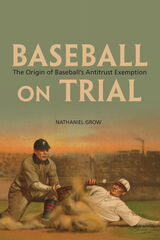 Baseball on Trial: The Origin of Baseball's Antitrust Exemption
Nathaniel Grow
University of Illinois Press, 2014 The controversial 1922 Federal Baseball Supreme Court ruling held that the "business of base ball" was not subject to the Sherman Antitrust Act because it did not constitute interstate commerce. In Baseball on Trial, legal scholar Nathaniel Grow defies conventional wisdom to explain why the unanimous Supreme Court opinion authored by Justice Oliver Wendell Holmes, which gave rise to Major League Baseball's exemption from antitrust law, was correct given the circumstances of the time.
Currently a billion dollar enterprise, professional baseball teams crisscross the country while the games are broadcast via radio, television, and internet coast to coast. The sheer scope of this activity would seem to embody the phrase "interstate commerce." Yet baseball is the only professional sport--indeed the sole industry--in the United States that currently benefits from a judicially constructed antitrust immunity. How could this be?
Drawing upon recently released documents from the National Baseball Hall of Fame, Grow analyzes how the Supreme Court reached this seemingly peculiar result by tracing the Federal Baseball litigation from its roots in 1914 to its resolution in 1922, in the process uncovering significant new details about the proceedings. Grow observes that while interstate commerce was measured at the time by the exchange of tangible goods, baseball teams in the 1910s merely provided live entertainment to their fans, while radio was a fledgling technology that had little impact on the sport. The book ultimately concludes that, despite the frequent criticism of the opinion, the Supreme Court's decision was consistent with the conditions and legal climate of the early twentieth century.
Baseball's Greatest Season, 1924
Reed Browning
University of Massachusetts Press, 2003 With the possible exception of 2004 no season in the history of baseball has matched 1924 for escalating excitement and emotional investment by fans. It began with observers expecting yet another World Series between the Yankees and the Giants. It ended months later when the Washington Nationals (Senators), making their first Series appearance, grabbed the world championship by scoring the season-ending run on an improbable play in the bottom of the twelfth inning of the seventh game.
On the eve of the return of major league baseball to Washington, D.C., Baseball's Greatest Season recovers the memory of the one and only time when the championship of the national pastime resided in the nation's capital.
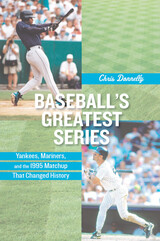 Baseball's Greatest Series: Yankees, Mariners, and the 1995 Matchup That Changed History
Donnelly, Chris
Rutgers University Press, 2010 Baseball's Greatest Series details what many believe to be the most exciting postseason series in baseball history: the 1995 Division Series between the New York Yankees and the Seattle Mariners. This division series was not simply about two teams playing five postseason games. It was about Ken Griffey Jr., Lou Piniella, Buck Showalter, Gene Michael, Jim Leyritz, Randy Johnson, Wade Boggs, Tony Fernandez, Pat Kelly, Dion James, Darryl Strawberryùand many others who changed the course of baseball history . . .
A team playing to keep baseball alive in the Pacific Northwest
A manager who was literally managing for his job
A New York sports icon who for one week reminded everybody of the dominating player he had been a decade earlier Chris Donnelly's replay of this entire season reminds readers that it was a time when grown men cried their eyes out after defeat, and others, just a few hundred feet away, poured beer and champagne over one another while 57,000 people in Seattle's Kingdome celebrated. Five games they were. Five games that reminded people, after the devastating players' strike in 1994, how great a game baseball is because comebacks are always possible, no matter how great the obstacles may seem. From Don Mattingly's only postseason home run, which caused a near riot, to Edgar Martinez's legendary eleventh inning series-clinching double, Donnelly chronicles the earlier struggles of both teams during the 1980s, their mid-1990s resurgence, all five heart-stopping games of the series, and the dramatic and long-lasting effects of Seattle's victory. Simply stated, Baseball's Greatest Series hits a home run.
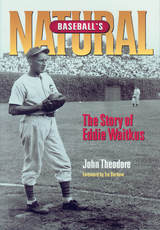 Baseball's Natural: The Story of Eddie Waitkus
John Theodore. Foreword by Ira Berkow
Southern Illinois University Press, 2002 Baseball’s Natural: The Story of Eddie Waitkus is John Theodore’s true account of the slick-fielding first baseman who played for the Cubs and Phillies in the 1940s and became an immortalized figure in baseball lore as the inspiration for Roy Hobbs in Bernard Malamud’s The Natural. The son of Lithuanian immigrants, Edward Stephen Waitkus (1919–1972) grew up in Boston and served in the Pacific during World War II. His army service in some of the war’s bloodiest combat earned him four Bronze Stars. Following the war, Waitkus became one of the most popular players of his era. As a rookie he led the Cubs in hitting in 1946 and quickly established himself as one of the best first basemen in the National League. To the disappointment of fans, the Cubs traded Waitkus to the Phillies in December of 1948. When he returned to Chicago in a Philadelphia uniform in June of the following year, he was hitting .306 and seemed destined for the All Star team. On the night of June 14 at the Edgewater Beach Hotel, Waitkus’s bright career took an infamously tragic turn. He received a cryptic note summoning him to meet a young fan, Ruth Steinhagen. When Waitkus entered her hotel room, she proclaimed, “I have a surprise for you,” and then she just as quickly shot him in the chest. Steinhagen, then only nineteen, was one of the many young women—called “Baseball Annies”–who were fanatic about the game and its players, though her obsession proved more dangerous than most. A criminal court indicted Steinhagen and confined her to a state mental hospital for nearly three years. Waitkus survived the shooting, made an inspirational return to baseball in 1950, and led the Phillies to the World Series. While Waitkus triumphed over his assault, he could not conquer his private demons. Depression stemming from the attack led to a severe problem with alcohol, a failed marriage, and a nervous breakdown. Waitkus found some happiness in his final summers working with youngsters at the Ted Williams baseball camp. Cancer claimed him in 1972, just days after his fifty-third birthday. Through interviews with Waitkus’s family, fellow servicemen, former ballplayers, and childhood friends, and aided by fifteen photographs, Theodore chronicles Waitkus’s remarkable comeback as well as the difficult years following his eleven-year major league career.
Basel in the Age of Burckhardt: A Study in Unseasonable Ideas
Lionel Gossman
University of Chicago Press, 2000 This remarkable history tells the story of the independent city-republic of Basel in the nineteenth century, and of four major thinkers who shaped its intellectual history: the historian Jacob Burckhardt, the philologist and anthropologist Johann Jacob Bachofen, the theologian Franz Overbeck, and the philosopher Friedrich Nietzsche.
"Remarkable and exceptionally readable . . . There is wit, wisdom and an immense erudition on every page."—Jonathan Steinberg, Times Literary Supplement
"Gossman's book, a product of many years of active contemplation, is a tour de force. It is at once an intellectual history, a cultural history of Basel and Europe, and an important contribution to the study of nineteenth-century historiography. Written with a grace and elegance that many aspire to, few seldom achieve, this is model scholarship."—John R. Hinde, American Historical Review
A Basic Christian Theology
A. J. Conyers
St. Augustine's Press, 2019 A. J. Conyers was an evangelical, Baptist theologian who helped found Truett Seminary at Baylor university. Conyers’s theology drank deeply from the wells of the Christian tradition. In this volume, he provides what he found to be the most basic elements of Christian theology and demonstrates a methodology that is biblically informed, traditionally grounded, and contextually aware. this revised edition makes this excellent work available again, with some modified study questions, additional unpublished material from Conyers’s archives, and helpful reflection and tributes from two of Conyers’s best students—Brian Brewer and Brad Green—who carry on his legacy
Basic Circuitry of the MIDAC and MIDSAC
J.E. De Turk, H.L. Garner, J. Kaufman, H.W. Bethel, R.E. Hock
University of Michigan Press, 1954 During the years 1951 to 1953, several digital computing systems were developed at the University of Michigan, Willow Run Research Center, under the sponsorship of the United States Air Force. One aspect of the computer program concerned the development of a flexible and highly standardized set of electronic computing circuits that served as the principal building blocks for computer designs. This report describes the results of that work.
Basic Color Terms: Their Universality and Evolution
Brent Berlin and Paul Kay
CSLI, 1999 The work reported in this monograph was begun in the winter of 1967 in a graduate seminar at Berkeley. Many of the basic data were gathered by members of the seminar and the theoretical framework presented here was initially developed in the context of the seminar discussions. Much has been discovered since1969, the date of original publication, regarding the psychophysical and neurophysical determinants of universal, cross-linguistic constraints on the shape of basic color lexicons, and something, albeit less, can now also be said with some confidence regarding the constraining effects of these language-independent processes of color perception and conceptualization on the direction of evolution of basic color term lexicons.
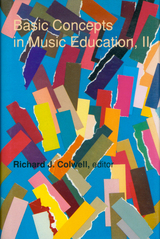 Basic Concepts in Music Education, II
Richard J. Cowell
University Press of Colorado, 1991 First published in 1958, Basic Concepts in Music Education served as the standard text for a generation of music educators. Providing the basics on aesthetic philosophy, of education, and of music education, this popular volume remained in print for twenty-five years. A continuation on the first edition, Basic Concepts in Music Education, II features revisions and updates by the living authors as well as contributions by new authors who delineate concepts of music education that are particularly important to the nineties and beyond. These topics include growth processes, learning theory, functional music, messages for teachers, the range of musical experience, technology, and evaluation. Chapters from the most noted authorities in music education promise to provide definitive guidance in Basic Concepts, II that Basic Concepts, I has provided for the past quarter century. Among the contributors are Charles Fowler, Harry S. Broudy, Foster McMury, Wayne Bowman, Marilyn Zimmerman, Bennett Reimer, Clifton Burmeister, Richard Colwell, Robert Ehle, and Allen P. Britton. Like its predecessor, Basic Concepts, II offers rich and stimulating discussions on the most pertinent issues facing music education today - discussions that are vital to professionals and enlightening to the general reader.
A Basic Course in Iraqi Arabic with MP3 Audio Files
Wallace M. Erwin. Foreword by Margaret Nydell and Karin C. Ryding
Georgetown University Press, 2004 A comprehensive introduction to Iraqi Arabic for beginners (with Iraqi-English and English-Iraqi glossaries) this is the language spoken by Muslim Baghdad residents, transcribed and not in Arabic script. It does not assume prior knowledge of Arabic. A Basic Course in Iraqi Arabic with MP3 Audio Files contains ten chapters of phonology to explain the sounds, and thirty more covering grammar and vocabulary. The phonology chapters all contain extensive drills. The grammar chapters start with a dialogue or brief narrative, then explain new vocabulary and points of grammar, and conclude with drills. The book is usefully enhanced with a bound-in CD with audio MP3 files to accompany the text and drills.
 A Basic Course in Moroccan Arabic with MP3 Files
Richard S. Harrell with Mohammed Abu-Talib and William S. Carroll. Foreword by Margaret Nydell
Georgetown University Press, 2006 A Basic Course in Moroccan Arabic is a textbook in spoken Moroccan Arabic that is written for beginners who are unfamiliar with the Arabic language, alphabet, pronunciation, vocabulary, and grammar. Written in Latinate transcription it is carefully designed to present these elements in a progressive, user-friendly, step-by-step manner. Following the initial pronunciation introductions and practice, there are 130 lessons consisting of a text where a small number of phrases and sentences illustrate grammatical points. These sections also contain exercises in new grammar and vocabulary. Each lesson is structured in a way that guides the learner naturally and comfortably into an understanding of the structure of Moroccan Arabic. From there, the course progresses into ninety-seven short, conversational dialogs that place the student in a variety of social situations. First introduced to Arabic language students in the 1960s, A Basic Course in Moroccan Arabic still has no equal for clarity and ease of use. An audio CD of MP3 files that further aid and enhance the lessons is now bound into this volume.
Basic Czech I: Third Revised and Updated Edition
Ana Adamovicova and Darina Ivanovova
Karolinum Press, 2009 Basic Czech I, II, and III form a complete textbook for a course for English-language speakers who want to learn Czech. The first volume presents the basics of the Czech language by means of continuous and systematic acquisition of vocabulary and conversation phrases grouped around useful topics and situations.
Basic Czech II: Third Revised and Updated Edition
Ana Adamovicova and Darina Ivanovova, and Milan Hrdlicka
Karolinum Press, 2014 Basic Czech I, II, and III form a complete textbook for a course for English-language speakers who want to learn Czech. Basic Czech II is structured similarly, but it moves students from beginning to intermediate work, gradually delving into more complicated issues of grammar and usage. It includes a compact disc that features audio exercises built around texts and dialogues that the student will have learned in the first volume.
Basic Czech III
Ana Adamovicová and Milan Hrdlicka
Karolinum Press, 2016 BASIC CZECH is a modern textbook of Czech as a foreign language based on English, a sequel to Basic Czech I and Basic Czech II. It consists of six units (approx. 2000 words and phrases) and it is based on communicative and comparative approach. The textbook can be used in intensive as well as two-semester and other types of classes. It is also suitable for self-study. It provides the key to all exercises. All words and phrases are included in the Czech-English word list at the end of each unit.
The grammatical and lexical topics covered in this volume exceed the level we commonly call basic. Nevertheless to preserve the formal continuity of all three volumes, we have kept the title "Basic Czech." Grammar and vocabulary covered corresponds with level B1-B2 of the Common European Framework of Reference for Languages.
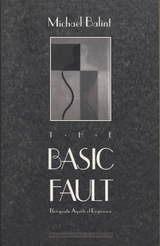 The Basic Fault: Therapeutic Aspects of Regression
Michael Balint
Northwestern University Press, 1968 When it was first published in 1968, Michael Balint's The Basic Fault laid the groundwork for a far-ranging reformation in psychoanalytic theory. This reformation is still incomplete, for it remains true today that despite the proliferation of techniques and schools, we do not know which are more correct or more successful--and all psychoanalysts continue to encounter intractable cases of mental disorder. Balint argues that ordinary "rigid" techniques and theories are doomed to failure in such cases because of their emphasis on interpretation.
The Basic Fault continues to illuminate the crucial current issues in psychoanalysis and psychotherapy in general: the nature of self, the role of developmental defects, the value of empathy, and the central importance of the relationship between therapist and patient. This paperback edition includes a foreword by Paul H. Ornstein discussing the impact of Balint's work at the time of its publication and its continued importance now.
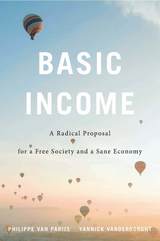 Basic Income: A Radical Proposal for a Free Society and a Sane Economy
Philippe Van Parijs and Yannick Vanderborght
Harvard University Press, 2017 “Powerful as well as highly engaging—a brilliant book.”
—Amartya Sen
A Times Higher Education Book of the Week
It may sound crazy to pay people whether or not they’re working or even looking for work. But the idea of providing an unconditional basic income to everyone, rich or poor, active or inactive, has long been advocated by such major thinkers as Thomas Paine, John Stuart Mill, and John Kenneth Galbraith. Now, with the traditional welfare state creaking under pressure, it has become one of the most widely debated social policy proposals in the world. Basic Income presents the most acute and fullest defense of this radical idea, and makes the case that it is our most realistic hope for addressing economic insecurity and social exclusion.
“They have set forth, clearly and comprehensively, what is probably the best case to be made today for this form of economic and social policy.”
—Benjamin M. Friedman, New York Review of Books
“A rigorous analysis of the many arguments for and against a universal basic income, offering a road map for future researchers.”
—Wall Street Journal
“What Van Parijs and Vanderborght bring to this topic is a deep understanding, an enduring passion and a disarming optimism.”
—Steven Pearlstein, Washington Post
Basic Income on the Agenda: Policy Objectives and Political Chances
Edited by Loek Groot and Robert-Jan van der Veen
Amsterdam University Press, 2000 Persisting unemployment, poverty and social exclusion, labour market flexibility, job insecurity and higher wage inequality, changing patterns of work and family life are among the factors that exert pressure on welfare states in Europe. This book explores the potential of an unconditional basic income, without means test or work requirement, to meet the challenges posed by the new social question, compared to policies of subsidized insertion in work. It also assesses the political chances of basic income in various European countries. These themes are highly relevant to policy-makers in the field of labour markets and social security, economists, political philosophers, and a social science audience in general.
 Basic Income: The Material Conditions of Freedom
Daniel Raventos
Pluto Press, 2007 Basic Income is a policy idea that could help us revolutionize the way we organize society. This book is the first proper guide to basic income-what it is, how we can organize it, and how it can benefit everyone,rich and poor alike. Basic Income is simply the idea that everyone has a right to a minimal income. This is paid by the state out of taxation. Set at a subsistence level, it would take the place of unemployment and other benefits. This would bring profound social changes. Anyone could opt out of employment at any time. Those with few skills would no longer be forced to take up jobs with poor prospects, and employers offering McJobs would be compelled to offer better terms. And money wasted by the state in means testing and tracing benefit fraud is saved. The campaign in favor of basic income is growing and governments are beginning to take notice. The is a clear,concise guide to the principles and practicalities of this revolutionaty idea.
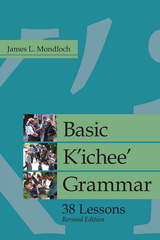 Basic K'ichee' Grammar: 38 Lessons, Revised Edition
James L. Mondloch
University Press of Colorado, 2016 The K’ichee’an languages—K’ichee’, Kaqchikel, Tz¢utujil, Sakapulteko, Achi, and Sipakapense—occupy a prominent place among the indigenous languages of the Americas because of both their historical significance and the number of speakers (more than one million total). Basic K'ichee' Grammar is an extensive and accurate survey of the principal grammatical structures of K’ichee’. Written in a clear, nontechnical style to facilitate the learning of the language, it is the only K’ichee’ grammar available in English.
A pedagogical rather than a reference grammar, the book is a thorough presentation of the basics of the K’ichee’ Maya language organized around graded grammatical lessons accompanied by drills and exercises. Author James L. Mondloch spent ten years in K’ichee’-speaking communities and provides a complete analysis of the K’ichee’ verb system based on the everyday speech of the people and using a wealth of examples and detailed commentaries on actual usage.
A guide for learning the K’ichee’ language, Basic K'ichee' Grammar is a valuable resource for anyone seeking a speaking and reading knowledge of modern K’ichee’, including linguists, anthropologists, and art historians, as well as nonacademics working in K’ichee’ communities, such as physicians, dentists, community development workers, and educators.
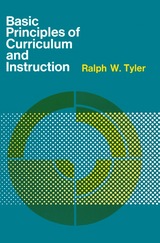 Basic Principles of Curriculum and Instruction
Ralph W. Tyler
University of Chicago Press, 1969 What educational purposes should the school seek to attain, and what educational experiences can be provided that are likely to achieve these purposes? Rather than literally answering these questions of curriculum and instruction, Tyler develops a rationale for studying them, and suggests procedures for formulating answers and evaluating programs of study. Quite simply, his book outlines one way of viewing an instructional program as a functioning instrument of education.
The four sections of the book deal with ways of formulating, organizing, and evaluating the educational objectives that have been chosen for the curriculum. Tyler emphasizes the fact that curriculum planning is a continuous cyclical process, involving constand replanning, redevelopment, and reappraisal. Substitution of such an integrated view of an instructional program for hit-or-miss judgment as the basis for curriculum development cannot but result in an increasingly effective curriculum.
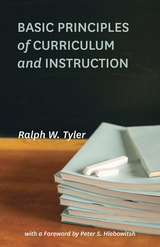 Basic Principles of Curriculum and Instruction
Ralph W. Tyler
University of Chicago Press, 2013 The most important guide for anyone working on curriculum development
Basic Principles of Curriculum and Instruction has been the standard in the field for decades, and it continues to be the leading guide to curriculum development today. Ralph W. Tyler presents here the concept that curriculum should be dynamic, a program under constant evaluation and revision. Before the publication of this book, curriculum had generally been thought of as a static, set program, and in an era preoccupied with student testing, he offered the innovative idea that teachers and administrators should spend as much time evaluating their plans as they do assessing their students.
Although not a strict how-to guide, the book shows how educators can critically approach curriculum planning, studying progress and retooling when needed. Its four sections focus on setting objectives, selecting learning experiences, organizing instruction, and evaluating progress. Readers will come away with a firm understanding of how to formulate educational objectives and how to analyze and adjust their plans so that students meet the objectives. Tyler also explains that curriculum planning is a continuous, cyclical process, an instrument of education that needs to be fine-tuned. This emphasis on thoughtful evaluation has kept Basic Principles of Curriculum and Instruction a relevant, trusted companion for decades. Even as the educational landscape changes and teachers and administrators have to adjust to new developments in testing, student engagement, regulation, and more, the core principles animating this book remain as valid and effective as ever. And with school districts across the nation working to align their curriculum with Common Core standards, Tyler's straightforward recommendations are sound and effective tools for educators working to create a curriculum that integrates national objectives with their students' needs.
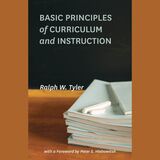 Basic Principles of Curriculum and Instruction
Ralph W. Tyler
University of Chicago Press, 2013 This is an auto-narrated audiobook version of this book.
In 1949, a small book had a big impact on education. In just over one hundred pages, Ralph W. Tyler presented the concept that curriculum should be dynamic, a program under constant evaluation and revision. Curriculum had always been thought of as a static, set program, and in an era preoccupied with student testing, he offered the innovative idea that teachers and administrators should spend as much time evaluating their plans as they do assessing their students.
Since then, Basic Principles of Curriculum and Instruction has been a standard reference for anyone working with curriculum development. Although not a strict how-to guide, the book shows how educators can critically approach curriculum planning, studying progress and retooling when needed. Its four sections focus on setting objectives, selecting learning experiences, organizing instruction, and evaluating progress. Readers will come away with a firm understanding of how to formulate educational objectives and how to analyze and adjust their plans so that students meet the objectives. Tyler also explains that curriculum planning is a continuous, cyclical process, an instrument of education that needs to be fine-tuned. This emphasis on thoughtful evaluation has kept Basic Principles of Curriculum and Instruction a relevant, trusted companion for over sixty years. And with school districts across the nation working feverishly to align their curriculum with Common Core standards, Tyler's straightforward recommendations are sound and effective tools for educators working to create a curriculum that integrates national objectives with their students' needs.
Basic Problems of Ethnopsychiatry
George Devereux
University of Chicago Press, 1980 In these sixteen essays, written between 1939 and 1965, George Devereux argues that the understanding of all human behavior requires the application of both psychological and sociocultural methods of explanation. This unique approach, which differentiates sanity and insanity from social adjustment and maladjustment, provides a rigorous foundation for a general theory of psychoanalytic ethnopsychiatry.
George Devereux, a psychoanalyst and anthropologist, discusses crime, sexual delinquency, dreams in non-Western cultures, and cannibalistic drives of parents. He frequently cites case material from his extensive field work with the Mahave Indians of Arizona and the Sedang Moi of Vietnam and from his clinical work with non-Western patients.
Basic Questions in Paleontology: Geologic Time, Organic Evolution, and Biological Systematics
Otto H. Schindewolf
University of Chicago Press, 1993 Now available in English for the first time, Basic Questions in Paleontology is a landmark work in twentieth-century evolution and paleontology. Originally published in German in 1950, Schindewolf's book was highly controversial for its thoroughgoing anti-Darwinism, but today his ideas are remarkably relevant to current research in evolutionary biology.
"[This book] would rank number one on my list of items awaiting translation from the history of twentieth-century evolutionary theory."—Stephen Jay Gould
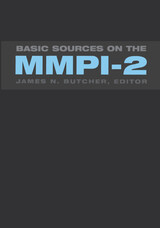 Basic Sources On The Mmpi-2
James N. Butcher
University of Minnesota Press, 2000 All the core research literature in one convenient, up-to-date volume.
Since its release in 1989, the MMPI-2 (the revised Minnesota Multiphasic Personality Inventory) has generated an extensive body of research. A core of articles fundamental to an understanding of the MMPI-2 has emerged and is now available here in one essential resource. Edited by a recognized authority, the volume contains the published empirical and theoretical articles on scale construction for the original MMPI and the structure and development of MMPI-2 scales as well as two original pieces that fill gaps in the literature.
With introductory comments preceding each section, the volume is divided into parts devoted to the development of the traditional validity and clinical scales; the MMPI-2 norms, including the development of uniform T scores; validity and supplementary scales created for the MMPI-2, as well as a set of subscales for clinical scale Si; validation research on the content scales introduced in the MMPI-2, providing information about empirical correlates that is crucial to MMPI-2 interpretation; studies on the reliability of the MMPI-2; studies on cultural and subcultural factors in MMPI-2 interpretation; and computer applications of the MMPI-2.
Designed for researchers, graduate students in psychology, and professionals who use the MMPI-2 in their work, this volume will be an indispensable reference and resource.
The Basic Symbols of the American Political Tradition
Willmoore Kendall
Catholic University of America Press, 1995 This thought-provoking book contributes important arguments to the fundamental debate over the place of equality in our political self-understanding. It will continue to be of immense interest to all serious students of American political thought.
Basic Technical Japanese
Edward E. Daub
University of Wisconsin Press, 2011 Even if you have had no Japanese-language training, you can learn how to translate technical manuals, research publications, and reference works. Basic Technical Japanese takes you step by step from an introduction to the Japanese writing system through a mastery of grammar and scientific vocabulary to reading actual texts in Japanese. You can use the book to study independently or in formal classes.
This book places special emphasis on the kanji (characters) that occur most often in technical writing. There are special chapters on the language of mathematics and chemistry, and vocabulary building and reading exercises in physics, chemistry, biology, and biochemistry. With extensive character charts and vocabulary lists, Basic Technical Japanese is entirely self-contained; no dictionaries or other reference works are needed.
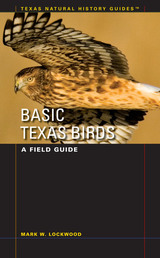 Basic Texas Birds: A Field Guide
By Mark W. Lockwood
University of Texas Press, 2007 Finding all the birds in Texas can be a lifetime pursuit. Basic Texas Birds, an easy-to-use field guide, will help you identify over 180 species of birds that are found across the state, including a selection of the rarer "Texas specialties" that draw birders to Texas from around the world. These are the birds that form the basis of a birder's life list for Texas. Basic Texas Birds is organized by bird families to aid in identifying any bird you see in the wild. It is loaded with resources, including: - 200 full-color, close-up photos of the birds
- State-of-the-art range maps—the most accurate of any currently available—that show each species' distribution within the state
- Up-to-date species accounts that provide a wealth of current and historical information, including each bird's appearance, habitat, status, and distribution, and that also identify similar species
- A glossary of terms used in bird identification
- A list of selected readings for learning more about birds found in Texas
- The Texas Ornithological Society's list of birds documented in Texas
Much more convenient for identifying common birds than a comprehensive state or national field guide, Basic Texas Birds is a must-have resource for both beginning and experienced birders.
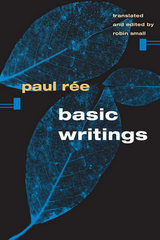 Basic Writings
Paul Rée
University of Illinois Press, 2003 This book contains the first English translations of The Origin of the Moral Sensations and Psychological Observations, the two most important works by the German philosopher Paul Rée. These essays present Rée’s moral philosophy, which influenced the ideas of his close friend Friedrich Nietzsche considerably.
Nietzsche scholars have often incorrectly attributed to him arguments and ideas that are Rée’s and have failed to detect responses to Rée’s works in Nietzsche’s writings. Rée’s thinking combined two strands: a pessimistic conception of human nature, presented in the French moralists’ aphoristic style that would become a mainstay of Nietzsche’s own writings, and a theory of morality derived from Darwin’s theory of natural selection. Rée’s moral Darwinism was a central factor prompting Nietzsche to write On the Genealogy of Morals and the groundwork for much of today’s “evolutionary ethics.”
In an illuminating critical introduction, Robin Small examines Rée’s life and work, locating his application of evolutionary concepts to morality within a broader history of Darwinism while exploring Rée’s theoretical and personal relationship with Nietzsche. In placing Nietzsche in his intellectual and social context, Small profoundly challenges the myth of Nietzsche as a solitary thinker.
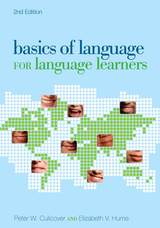 Basics of Language for Language Learners, 2nd Edition
Peter W. Culicover and Elizabeth V. Hume
Ohio State University Press, 2017 Learning a language involves so much more than just rote memorization of rules. Basics of Language for Language Learners, 2nd edition, by Peter W. Culicover and Elizabeth V. Hume, systematically explores all the aspects of language central to second language learning: the sounds of language, the different grammatical structures, the social functions of communication, and the psychology of language learning and use. Unlike books specific to one single language, Basics of Language will help students of all languages. Readers will gain insight into the structure and use of their own language and will therefore see more clearly how the language they are learning differs from their first language. Language instructors will find the approach provocative, and the book will stimulate many new and effective ideas for teaching. Both a textbook and a reference work, Basics of Language will enhance the learning experience for anyone taking a foreign language course as well as the do-it-yourself learner. A new section, “Tools and Strategies for Language Learning,” has been added to this second edition. It comprises three chapters that focus on brain training, memory and using a dictionary. In addition, the section “Thinking Like a Native Speaker” has been substantially updated to include more discussion of errors made by language learners.
Basin-Plateau Aboriginal Sociopolitical Groups
Julian Steward
University of Utah Press, 1997 This volume constitutes one of the earliest and most comprehensive ethnographic reconnaissance of the Western Shoshoni and some of their Northern Paiute, Ute, and Southern Paiute neighbors of the Great Basin. At the same time, it tries to ascertain the types of Shoshonean sociopolitical groups and to discover their ecological and social determinants.
First published in 1938 as the Smithsonian Institution Bureau of American Ethnology Bulletin 120, this study is a classic in the field of Great Basin ethnology. Steward is considered one of the foremost exponents of cultural evolution in the United States, and his work is a major contribution to the study of social organization and to North American ethnography.
 The Basis of Japanese Foreign Policy
Albert E. Hindmarsh
Harvard University Press Japan offers a case-study of intensified imperialism in the modern world. Legal, moral, and ethical considerations have not sufficed to restrain leaden faced with pressing problems, the solutions to which seem to demand aggressive action. The internal disturbances during the month of February 1936 must add to the importance of any study of the forces which underlie Japan’s expansionist policies; for if these forces are based on factors more fundamental than the militarist ambitions of cliques in the army and navy, even a swing to liberalism will not necessarily induce any vital or substantial change in the objectives of foreign policy. If the essentials of that policy are dictated by deep and widespread domestic conditions, the only apparent remedy for which is some kind of outlet in Asia and intensified industrialization a mere change in the tone of government does not promise anything approaching a reversal of policy. Dr. Hindmarsh’s study attempts to discover these fundamental motivations and realistically to portray their determining influence on the acts and attitude of the nation's leaders.
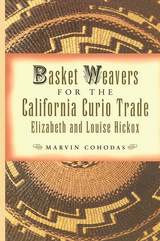 Basket Weavers for the California Curio Trade: Elizabeth and Louise Hickox
Marvin Cohodas
University of Arizona Press, 1997 The peoples of northwestern Califonia's Lower Klamath River area have long been known for their fine basketry. Two early-twentieth-century weavers of that region, Elizabeth Hickox and her daughter Louise, created especially distinctive baskets that are celebrated today for their elaboration of technique, form, and surface designs.
Marvin Cohodas now explores the various forces that influenced Elizabeth Hickox, analyzing her relationship with the curio trade, and specifically with dealer Grace Nicholson, to show how those associations affected the development and marketing of baskets. He explains the techniques and patterns that Hickox created to meet the challenge of weaving design into changig three-dimensional forms. In addition to explicating the Hickoxes' basketry, Cohodas interprets its uniqueness as a form of intersocietal art, showing how Elizabeth first designed her distinctive trinket basket to convey a particular view of the curio trade and its effect on status within her community.
Through its close examination of these superb practitioners of basketry, Basket Weavers for the California Curio Trade addresses many of today's most pressing questions in Native American art studies concerning individuality, patronage, and issues of authenticity. Graced with historic photographs and full-color plates, it reveals the challenges faced by early-twentieth-century Native weavers.
Published with the assistance of The Southwest Museum, Los Angeles.
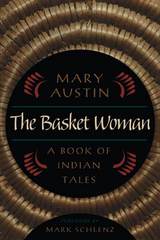 The Basket Woman: A Book Of Indian Tales
Mary Austin
University of Nevada Press, 1999 Austin's charming and evocative stories dramatize the legacy of conquest upon a land and its native peoples. Although these stories, out of print for almost a century, were first intended as delightful and instructive reading for children, on another level they are an intense examination of the dramatic implications of a legacy of conquest upon the land and its native peoples. In Austin’s tales, cocky young glaciers, contemplative pine trees, resourceful ancient Paiutes, and rabbits too clever for their own good all become companions and teachers to Alan, the young son of homesteaders in early Nevada. The kindly but mysterious Basket Woman, who tells him these tales, is a keeper of her people's traditions. She doesn't simply tell stories: she transports her young friend into a powerful and mythic past, where Alan learns the secrets of the trees and animals and the wisdom of the people who flourished in this "land of little rain" before the arrival of foreigners from the east. A new foreword by Austin scholar and environmental writer Mark Schlenz provide ample context for a multilevel appreciation of one of this remarkable writer's most important works.
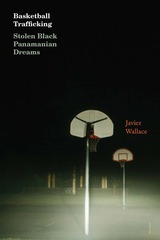 Basketball Trafficking: Stolen Black Panamanian Dreams
Javier Wallace
Duke University Press, 2025 Tito is a Black Panamanian teenager whose hoop dreams include playing in the NBA. When a private high school in Texas recruits him under the guise of an athletic scholarship, he believes he’s one step closer. Instead, he becomes entangled in a system that exploits young Black athletes through the F-1 student visa program. In Basketball Trafficking, Javier Wallace follows Tito’s journey from international tournaments and high school to his near deportation, exposing the underbelly of the basketball pipeline that stretches across borders. Wallace situates Tito’s experience within a broader framework of anti-Blackness, labor exploitation, and the unchecked power of the National Collegiate Athletic Association and US immigration system. Tito’s story is more than a sports story—it is an urgent account of the policing and manipulation of Black male athletic labor for institutional profit. Prompting readers to consider how the global athletic industrial complex extracts and discards Black labor, Wallace demands that readers see young Black athletes like Tito not just as bodies for entertainment but as human beings whose dreams, struggles, and lives matter.
Basketmaker Caves in the Prayer Rock District, Northeastern Arizona
Elizabeth Ann Morris
University of Arizona Press, 1980 The Anthropological Papers of the University of Arizona is a peer-reviewed monograph series sponsored by the School of Anthropology. Established in 1959, the series publishes archaeological and ethnographic papers that use contemporary method and theory to investigate problems of anthropological importance in the southwestern United States, Mexico, and related areas.
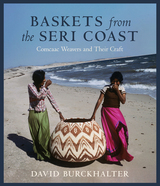 Baskets from the Seri Coast: Comcaac Weavers and Their Craft
David Burckhalter
University of Arizona Press, 2026 This stunning exploration of Seri (Comcaac) basket weaving reveals the resilience and creativity of the weavers as seen through the lens of documentary photographer David Burckhalter, who has spent five decades cultivating friendships and documenting Seri traditions, landscapes, and basketry in Sonora, Mexico.
Blending striking photography with reflections from years as a trader and observer of Seri culture, Burckhalter traces the evolution of Seri basketry from a utilitarian craft to a celebrated art form. The book examines how Seri weavers have navigated the influences of the craft economy, outside forces like anthropologists, and changing traditions, while preserving their unique oral history and spiritual connections. With detailed insights into the artistry, labor, and legends surrounding Seri baskets, this work is a tribute to the resilience and creativity of Seri women, whose weaving continues to be passed on to future generations.
Featuring more than two hundred color photographs and historic images, Baskets from the Seri Coast: Comcaac Weavers and Their Craft offers readers a visual feast that celebrates the intricate craftsmanship and cultural significance of a timeless art and the people who make it.
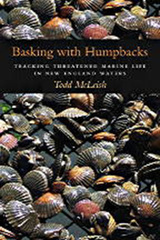 Basking with Humpbacks: Tracking Threatened Marine Life in New England Waters
Todd McLeish
University Press of New England, 2016 Basking with Humpbacks offers an exciting, close-up look at some of the most rare marine creatures living in New England waters and examines the complex threats they face. In eleven chapters, each featuring a different animal or plant, McLeish takes readers on an entertaining journey with scientists who study these species. The author follows basking sharks—the second largest fish in the sea—in their hunt for food, helps harbor porpoises escape from fishing nets, snorkels in search of wild bay scallops, and learns how the blood of horseshoe crabs is used in medical research. Along the way he visits the islands where rare seabirds nest, tracks humpback whales on their long migration to the Gulf of Maine, and watches as stranded leatherback turtles are returned to the ocean. These first-person experiences are coupled with interviews with biologists and other experts who explain in their own words the important role these creatures play in the marine ecosystem and what steps must be taken to protect them. In examining the natural history of selected plants and animals, McLeish also discusses the physics of waves and currents, the geology of the seabed, the chemistry of sea water, and other natural factors that influence the survival of New England marine life.
BASOR vol 381 num 1
The University of Chicago Press
University of Chicago Press Journals, 2019 This is volume 381 issue 1 of Bulletin of the American Schools of Oriental Research. The Bulletin of ASOR (BASOR) is a leader among peer-reviewed academic journals of the ancient Near East. For nearly a century, since 1919 when William F. Albright originally founded it as the Bulletin of the American School of Oriental Research in Jerusalem, BASOR has served as a highly respected interdisciplinary English-language forum for scholars worldwide in subject areas such as archaeology, art, anthropology, archaeometry, bioarchaeology, archaeozoology, biblical studies, history, literature, philology, geography, and epigraphy.
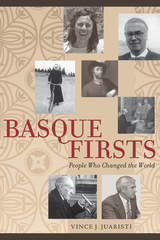 Basque Firsts: People Who Changed the World
Vince J. Juaristi
University of Nevada Press, 2016 Throughout history, Basque men and women have made contributions in navigation, education, science, fashion, politics, and many other fields. Too often these achievements have been overlooked, or have been claimed as the accomplishments of others. Basque Firsts: People Who Changed the World profiles seven remarkable Basques who were the first in their fields to do something—something extraordinary—that had a dramatic impact on others who followed them.
The profiles use primary sources to tell fresh stories and offer a wonderful variety, showing the astonishing breadth of Basque contributions. They include Juan Sebastían Elcano, the first person to circumnavigate the earth; St. Ignatius of Loyola, the first Jesuit to seed a worldwide movement in education; Santiago Ramón y Cajal, the Father of Neurology and a Nobel laureate; Cristóbal Balenciaga, the king of haute couture; Paul Laxalt, one of Ronald Reagan’s closest friends in politics; and Edurne Pasaban, the first woman to climb the world’s fourteen tallest mountains.
Basque Firsts provides a rare look at a culture’s people, revealing the significant contributions they have shared.
The Basque Hotel
Robert Laxalt
University of Nevada Press, 1993 This novel is the first volume in Laxalt's highly acclaimed Basque-family trilogy. It tells the story of Pete, the son of a Basque immigrant, and his coming of age in Depression-era Carson City. Pete’s immigrant parents run the Basque Hotel, bed and meals, whiskey and wine in Prohibition time for sheepherders and town characters. Pete is indifferent to his heritage except for disquiet about his parents’ ignorance of such American traditions as Christmas trees. Pete, too prone to dreams, undergoes his rites of passage—cruelty and kindness, disillusionment, love and terror, pathos and hilarious adventure, and finally, a cautious understanding of his world.
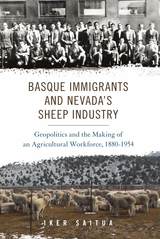 Basque Immigrants and Nevada's Sheep Industry: Geopolitics and the Making of an Agricultural Workforce, 1880-1954
Iker Saitua
University of Nevada Press, 2019 Basque Immigrants and Nevada’s Sheep Industry is a rich and complex exploration of the history of Basque immigration to the rangelands of Nevada and the interior West. It looks critically at the Basque sheepherders in the American West and more broadly at the modern history of American foreign relations with Spain after the Second World War.
Between the 1880s and the 1950s, the western open-range sheep industry was the original economic attraction for Basque immigrants. This engaging study tracks the development of the Basque presence in the American West, providing deep detail about the sheepherders’ history, native and local culture, the challenges they faced, and the changing conditions under which the Basques lived and worked. Saitua also shows how Basque immigrant sheepherders went from being a marginalized labor group to a desirable, high-priced workforce in response to the constant demand for their labor power.
As the twentieth century progressed, the geopolitical tide in America began to change. In 1924, the Restrictive Immigration Act resulted in a truncated labor supply from the Basque Country in Spain. During the Great Depression and the Second World War, the labor shortage became acute. In response, Senator Patrick McCarran from Nevada lobbied on behalf of his wool-growing constituency to open immigration doors for Basques, the most desirable laborers for tending sheep in remote places. Subsequently, Cold War international tensions offered opportunities for a reconciliation between the United States and Francisco Franco, despite Spain’s previous sympathy with the Axis powers.
This fresh portrayal shows how Basque immigrants became the backbone of the sheep industry in Nevada. It also contributes to a wider understanding of the significance of Basque immigration by exploring the role of Basque agricultural labor in the United States, the economic interests of Western ranchers, and McCarran’s diplomacy as catalysts that eventually helped bring Spain into the orbit of western democracies.
The Basque Insurgents: ETA, 1952–1980
Robert P. Clark
University of Wisconsin Press, 1984 Blamed, at first, by the Spanish government for the recent Madrid train bombings, ETA (Euzkadi ta Askatasuna), the Basque nationalist organization, has been perhaps the most violent insurgent group on the European continent. Yet little is known about it outside of Spain. This book, now back in print, offers a full analytical study of ETA.
The Basque Language: A Practical Introduction
Alan R. King
University of Nevada Press, 2012 Since its first publication in 1994, Alan R. King’s introduction to the Basque language has become the standard textbook for classroom language students and individuals learning this unique language on their own. It offers clear explanations of grammatical structure, exercises that allow students to practice grammatical and communication skills, dialogues and narrative texts that provide a glimpse into Basque social and family life. It also provides exercises in pronunciation and tips for instructors and students to help them achieve fluency in modern Basque.
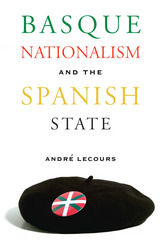 Basque Nationalism and the Spanish State
Andre Lecours
University of Nevada Press, 2016 An examination of Basque nationalism from a historical perspective. Basque nationalism has been extensively examined from the perspectives of Basque culture and internal conditions in the Basque Country, but André Lecours is among the first to demonstrate how Basque nationalism was shaped by the many forms and historical phases of the Spanish state. His discussion employs one of the most debated approaches in the social sciences—historical institutionalism—and it includes an up-to-date examination of the circumstances for, and consequences of, recent events such as ETA's announcement in 2006 of a permanent cease-fire. Lecours also analyzes other aspects of Basque nationalism, including the international relations of the Basque Autonomous Government, as well as the responses of the contemporary Spanish state and how it deploys its own brand of nationalism. Finally, the book offers a comparative discussion of Basque, Catalan, Scottish, Flemish, and Quebecois nationalist movements, suggesting that nationalism in the Basque Country, despite the historical presence of violence, is in many ways similar to nationalism in other industrialized democracies. Basque Nationalism and the Spanish State is an original and provocative discussion that is essential reading for anyone interested in the Basques or in the development of modern nationalist movements.
The Basque Poetic Tradition
Gorka Aulestia
University of Nevada Press, 2000 Renowned Basque literary scholar Gorka Aulestia continues his path-breaking study of the literary heritage of the Basque people. In this collection of fourteen essays, he considers the legacy of great Basque poets and their contributions to the tradition, influence on successive poets, and their place in the world’s poetry scene. Examining these poets and their work in the context of Basque cultural traditions and concurrent European literary movements, Aulestia sheds light on the colorful world of Basque poetry.
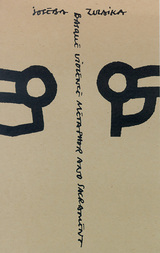 Basque Violence: Metaphor And Sacrament
Joseba Zulaika
University of Nevada Press, 2000 This book captures the complexity and humanity of one of the most agonizing of contemporary problems—that of terrorist violence. Basque Violence is in fact a pioneering attempt to give a fully contextualized, cultural account of the endemic conflict engaging Basque villagers both as protagonists and as spectators. The author focuses on his native village of Itziar in the province of Guipúzcoa, and many of the Basque activists he discusses are friends from his youth. They are now lionized by the villagers despite the fact that their actions have become increasingly problematic for the villagers themselves. Far from being the work of a “terrorism expert” seeking counter-insurgency solutions or concentrating on the usual search for the causes and consequences of violence, this study attempts instead to understand the conscious and unconscious presuppositions of the violence. The author becomes the narrator of a drama of Homeric proportions in which ordinary men are forced into acts of heroism and errors of tragic consequence.
Basque-English Dictionary
Gorka Aulestia
University of Nevada Press, 1989 This is the most comprehensive Basque-English dictionary; it incorporates all six major dialects of the revitalized language. With skill and precision, Gorka Aulestia has tackled the difficult problem of translating the non-Indo-European Basque language into English. Nearly 50,000 entries in six major dialects are included in this comprehensive dictionary. A concise introduction combines the basics of Basque verb forms, and each entry provides essential information such as part of speech and dialect markers. Special attention is given to words relating to modern society, contradicting the old adage that Basque is a rural-based language. Many of these terms do not appear in existing Basque-Spanish or Basque-French dictionaries. A formal guide to writing speech, this dictionary will be of interest to scholars, students, Basque Americans, Old World Basques learning English, and libraries around the world.
Basque-English, English-Basque Dictionary
Gorka Aulestia
University of Nevada Press, 1992 This pocket-sized Basque-English, English-Basque dictionary was designed for a broad audience—students, teachers, people of Basque descent, and travelers—and contains definitions of the most commonly used Basque and English words. This compact softcover volume is the condensed version of the two larger dictionaries, Basque-English Dictionary and English-Basque Dictionary. These two comprehensive reference works were highly praised by critics and well received by the public. Prepared by two scholars of the Basque language, this streamlined volume is an indispensable aid for students, travelers, and those who need to translate quickly between Basque and English. The unified Batua dialect is emphasized.
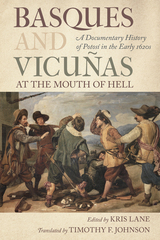 Basques and Vicuñas at the Mouth of Hell: A Documentary History of Potosí in the Early 1620s
Kris Lane
University of Nevada Press, 2024 In June 1622, the silver mining metropolis of Potosí, Bolivia, erupted in gangland violence, only halted three years later by a viceroy’s blanket amnesty. Basque immigrants were at the center of the controversy, squaring off against nearly a dozen other nations known collectively as Vicuñas. At stake were the world’s richest silver mines, a means to wealth and power in the Americas, Europe, and beyond.
As mines flooded and Indigenous workers died or fled, the city descended into a maelstrom of swordfights, gun battles, ambushes, sniper attacks, and summary executions. Though its roots were economic, the Basque-Vicuña conflict strained the sinews of Habsburg global governance even as it exposed festering local tensions, only some of which were unique to Potosí.
This rich collection of original sources, all of them archival documents housed in Bolivia, Spain, the United Kingdom, and the United States, consists of contemporary eyewitness accounts from several perspectives, allowing readers to play historian. All sources have been expertly translated and carefully annotated in a manner that will engage students and scholars alike. Basques and Vicuñas at the Mouth of Hell includes an extensive introduction, seven vital documents in translation, and appendices on everyday life in 1620s Potosí and on the historiography of this watershed episode of colonial violence.
Basques in the Philippines
Marciano R. De Borja
University of Nevada Press, 2012 The Basques played a remarkably influential role in the creation and maintenance of Spain’s colonial establishment in the Philippines. Their skills as shipbuilders and businessmen, their evangelical zeal, and their ethnic cohesion and work-oriented culture made them successful as explorers, colonial administrators, missionaries, merchants, and settlers. They continued to play prominent roles in the governance and economy of the archipelago until the end of Spanish sovereignty, and their descendants still contribute in significant ways to the culture and economy of the contemporary Philippines. This book offers important new information about a little-known aspect of Philippine history and the influence of Basque immigration in the Spanish Empire, and it fills an important void in the literature of the Basque diaspora.
Basques of the American West: New and Collected Essays on History and Ethnicity
Richard W. Etulain
University of Nevada Press, 2026 Basques of the American West: New and Collected Essays on History and Ethnicity brings together new and previously published work by Richard W. Etulain, blending historical analysis and literary criticism to explore the lives, stories, and representations of the Basques in this region. The essays examine key figures such as Robert Laxalt and Frank Bergon; survey historical studies, memoirs, and novels; and trace evolving interpretations of Basque identity in Western literature and scholarship. Etulain highlights major trends in both Basque and Western American historiography while identifying important topics that remain open for additional research.
This collection offers readers a thoughtful and engaging look at the enduring presence and influence of Basques across the cultural and historical landscape of the American West.
The Basques, the Catalans, and Spain: Alternative Routes to Nationalist Mobilisation
Daniele Conversi
University of Nevada Press, 2000 Daniele Conversi's book is a comprehensive introduction to Basque and Catalan nationalism. The two movements have much in common but have differed in the strategies adopted to further their cause. Basque nationalism, in the shape of the military wing of ETA, took the path of violence, spawning an efficient terrorist campaign. Catalan nationalism, by contrast, is generally more accommodating and peaceful. This new study examines and compares the history, motives, and methods of the Catalonian and Basque nationalist movements. Conversi's interpretation of these programs offers a new understanding not only of the recent history of Spain but of the dynamics of nationalist movements throughout the modern world.
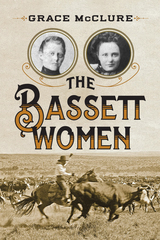 The Bassett Women
Grace McClure
Ohio University Press, 1985 In the late nineteenth century, Brown’s Park, a secluded valley astride the Utah-Colorado border, was a troubled land of deadly conflict among cattle barons, outlaws, rustlers, and small ranchers. Homesteader Elizabeth Bassett gained a tough reputation of her own, and her daughters followed suit, going on to become members of Butch Cassidy and the Wild Bunch’s inner circle. Ann—who counted Cassidy among her lovers—became known as “queen of the cattle rustlers.” Both sisters proved themselves shrewd businesswomen as they fended off hostile takeovers of the family ranch. Through the following decades, the sisters became the stuff of legend, women who embodied the West’s fearsome reputation, yet whose lived experiences were far more nuanced. Ann became a writer. Josie, whose cabin still stands at present-day Dinosaur National Monument, applied her pioneer ethics to a mechanized world and became renowned for her resourcefulness, steadfastness, and audacity. For The Bassett Women, Grace McClure tracked down and untangled the legends of Brown’s Park, one of the way stations of the fabled “Outlaw Trail,” while creating an evenhanded and indelible portrait of the Bassetts. Based on interviews, written records, newspapers, and archives, The Bassett Women is one of the few credible accounts of early settlers on Colorado’s western slope, one of the last strongholds of the Old West.
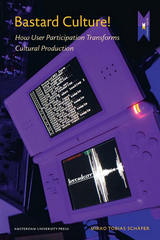 Bastard Culture!: How User Participation Transforms Cultural Production
Mirko Tobias Schäfer
Amsterdam University Press, 2011 In the wake of the recent far-reaching changes in the use and accessibility of technology in our society, the average person is far more engaged with digital culture than ever before. They are not merely subject to technological advances but actively use, create, and mold them in everyday routines—connecting with loved ones and strangers through the Internet and smart phones, navigating digital worlds for work and recreation, extracting information from vast networks, and even creating and customizing interfaces to best suit their needs. In this timely work, Mirko Tobias Schäfer delves deep into the realities of user participation, the forms it takes, and the popular discourse around new media. Drawing on extensive research into hacking culture, fan communities, and Web 2.0 applications, Schäfer offers a critical approach to the hype around user participation and exposes the blurred boundaries between industry-driven culture and the domain of the user.
The Bastard Instrument: A Cultural History of the Electric Bass
Brian F. Wright
University of Michigan Press, 2024 The Bastard Instrument chronicles the history of the electric bass and the musicians who played it, from the instrument’s invention through its widespread acceptance at the end of the 1960s. Although their contributions have often gone unsung, electric bassists helped shape the sound of a wide range of genres, including jazz, rhythm & blues, rock, country, soul, funk, and more. Their innovations are preserved in performances from artists as diverse as Lionel Hampton, Liberace, Elvis Presley, Patsy Cline, the Supremes, the Beatles, James Brown, Bob Dylan, Aretha Franklin, Jefferson Airplane, and Sly and the Family Stone, all of whom are discussed in this volume. At long last, The Bastard Instrument gives these early electric bassists credit for the significance of their accomplishments and demonstrates how they fundamentally altered the trajectory of popular music.
Bastard or Playmate?: Adapting Theatre, Mutating Media and Contemporary Performing Arts
Edited by Robrecht Vanderbeeken, Christel Stalpaert, David Depestel, and Boris Debackere
Amsterdam University Press, 2012 This fascinating volume explores the theme of mutating and adapting media in its relation to theatre and performance. Bringing together international scholars and artists, the editors offer a comprehensive overview of the changing nature of theater, focusing on interactivity, corporeality, liveness, surveillance, spectacle, performativity, and theatricality. Bastard or Playmate? shows how dismantling the medium of theater has led to a fertile ground for new art. This wide-ranging and vibrant book provides an excellent guide for readers unfamiliar with the field of intermediality, as well as researchers and experienced theater artists.
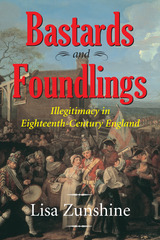 BASTARDS AND FOUNDLINGS: ILLEGITIMACY IN EIGHTEENTH-CENTURY ENGLAND
Lisa Zunshine
Ohio State University Press, 2005 In this compelling interdisciplinary study of what has been called the "century of illegitimacy," Lisa Zunshine seeks to uncover the multiplicity of cultural meanings of illegitimacy in the English Enlightenment. Bastards and Foundlings pits the official legal views on illegitimacy against the actual everyday practices that frequently circumvented the law; it reconstructs the history of social institutions called upon to regulate illegitimacy, such as the London Foundling Hospital; and it examines a wide array of novels and plays written in response to the same concerns that informed the emergence and functioning of such institutions. By recreating the context of the national preoccupation with bastardy, with a special emphasis on the gender of the fictional bastard/foundling, Zunshine offers new readings of "canonical" texts, such as Steele's The Conscious Lovers, Defoe's Moll Flanders, Fielding's Tom Jones, Moore's The Foundling, Colman's The English Merchant, Richardson's Clarissa and Sir Charles Grandison, Burney's Evelina, Smith's Emmeline, Edgewort's Belinda, and Austen's Emma, as well as of less well-known works, such as Haywood's The Fortunate Foundlings, Shebbeare's The Marriage Act, Bennett's The Beggar Girl and Her Benefactors, and Robinson's The Natural Daughter.
Bastards of the Reagan Era
Reginald Dwayne Betts
Four Way Books, 2015 Bastards of the Reagan Era is a challenge, confronting realities that frame an America often made invisible. Within these poems, we see the city as distant lover, we hear “the sound that comes from all / the hurt & want that leads a man to turn his back to the world.” We see that and we see each reason why we return to what pains us.
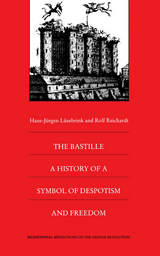 The Bastille: A History of a Symbol of Despotism and Freedom
Hans-Jürgen Lüsebrink and Rolf Reichardt
Duke University Press, 1997 This book is both an analysis of the Bastille as cultural paradigm and a case study on the history of French political culture. It examines in particular the storming and subsequent fall of the Bastille in Paris on July 14, 1789 and how it came to represent the cornerstone of the French Revolution, becoming a symbol of the repression of the Old Regime. Lüsebrink and Reichardt use this semiotic reading of the Bastille to reveal how historical symbols are generated; what these symbols’ functions are in the collective memory of societies; and how they are used by social, political, and ideological groups.
To facilitate the symbolic nature of the investigation, this analysis of the evolving signification of the Bastille moves from the French Revolution to the nineteenth century to contemporary history. The narrative also shifts from France to other cultural arenas, like the modern European colonial sphere, where the overthrow of the Bastille acquired radical new signification in the decolonization period of the 1940s and 1950s. The Bastille demonstrates the potency of the interdisciplinary historical research that has characterized the end of this century, combining quantitative and qualitative approaches, and taking its methodological tools from history, sociology, linguistics, and cultural and literary studies.
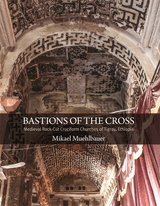 Bastions of the Cross: Medieval Rock-Cut Cruciform Churches of Tigray, Ethiopia
Mikael Muehlbauer
Harvard University Press In the late eleventh century, Ethiopian masons hewed great cruciform churches out of mountains in the eastern highlands of Tigray, Ethiopia’s northernmost province. Hitherto unparalleled in scale, these monuments were royal foundations, instruments of political centralization and re-Christianization that anticipated the great thirteenth-century churches at Lalibela. Bastions of the Cross, the first study devoted to the subject, examines the cruciform churches of Abreha wa-Atsbeha, Wuqro Cherqos, and Mika’el Amba and connects them to one of the great architectural movements of the Middle Ages: the millennial revival of the early Byzantine aisled, cruciform church. These were also the first to incorporate vaulting, and uniquely did so in the service of centralized spatial hierarchy. Through resuscitated pilgrimage networks, Ethiopian craftsmen revisited architectural types abandoned since Late Antiquity, while Islamic mercantile channels brought precious textiles from South Asia that inspired trans-material conceptions of architectural space. Bastions of the Cross reveals the eleventh century, in contrast to its popular reputation as a “dark age,” to be a forgotten watershed in the architectural history of Ethiopia and Eastern Christianity.
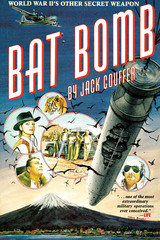 Bat Bomb: World War II's Other Secret Weapon
By Jack Couffer
University of Texas Press, 1992 It was a crazy way to win World War II in the Pacific— All the United States had to do was to attach small incendiary bombs to millions of bats and release them over Japan's major cities. As the bats went to roost, a million fires would flare up in remote crannies of the wood and paper buildings common throughout Japan. When their cities were reduced to ashes, the Japanese would surely capitulate... The plan made sense to a handful of eccentric promoters and researchers, who convinced top military brass and even President Roosevelt to back the scheme. It might have worked, except that another secret weapon—something to do with atoms—was chosen to end the war. Told here by the youngest member of the team, this is the story of the bat bomb project, or Project X-Ray, as it was officially known. In scenes worthy of a Capra or Hawks comedy, Jack Couffer recounts the unorthodox experiments carried out in the secrecy of Bandera, Texas; Carlsbad, New Mexico; and El Centro, California, in 1942-1943 by "Doc" Adams' private army. This oddball cast of characters included an eccentric inventor, a distinguished Harvard scientist, a biologist with a chip on his shoulder, a movie star, a Texas guano collector, a crusty Marine Corps colonel, a Maine lobster fisherman, an ex-mobster, and a tiger. Not to be defeated by minor logistical hurdles, the bat bomb researchers risked life and limb to explore uncharted bat caves and "recruit" thousands of bats to serve their country. Through months of personality conflicts, military snafus, and technical failures the team pressed on, certain that bats could end the war with Japan. And they might have—in their first airborne test, the bat bombers burned an entire brand-new military airfield to the ground. For everyone who relishes true tales of action and adventure, Bat Bomb is a must-read. Bat enthusiasts will also discover the beginnings of the scientific study of bats.
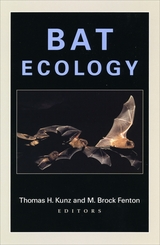 Bat Ecology
Edited by Thomas H. Kunz and M. Brock Fenton
University of Chicago Press, 2003 In recent years researchers have discovered that bats play key roles in many ecosystems as insect predators, seed dispersers, and pollinators. Bats also display astonishing ecological and evolutionary diversity and serve as important models for studies of a wide variety of topics, including food webs, biogeography, and emerging diseases. In Bat Ecology, world-renowned bat scholars present an up-to-date, comprehensive, and authoritative review of this ongoing research.
The first part of the book covers the life history and behavioral ecology of bats, from migration to sperm competition and natural selection. The next section focuses on functional ecology, including ecomorphology, feeding, and physiology. In the third section, contributors explore macroecological issues such as the evolution of ecological diversity, range size, and infectious diseases (including rabies) in bats. A final chapter discusses conservation challenges facing these fascinating flying mammals.
Bat Ecology is the most comprehensive state-of-the-field collection for scientists and researchers.
Contributors:
John D. Altringham, Robert M. R. Barclay, Tenley M. Conway, Elizabeth R. Dumont, Peggy Eby, Abigail C. Entwistle, Theodore H. Fleming, Patricia W. Freeman, Lawrence D. Harder, Gareth Jones, Linda F. Lumsden, Gary F. McCracken, Sharon L. Messenger, Bruce D. Patterson, Paul A. Racey, Jens Rydell, Charles E. Rupprecht, Nancy B. Simmons, Jean S. Smith, John R. Speakman, Richard D. Stevens, Elizabeth F. Stockwell, Sharon M. Swartz, Donald W. Thomas, Otto von Helversen, Gerald S. Wilkinson, Michael R. Willig, York Winter
Bat Ode
Jeredith Merrin
University of Chicago Press, 2001 The poems in Bat Ode speak to the way we live today and how it feels to occupy such a mongrel, fast-changing, postmodern world. Yet rather than breaking with the linguistic or poetic past, these poems seem to renew it with a fresh vision. Jeredith Merrin's sense of humor, her formal poise, her heart and wit, situate her as one of our most convincing social poets.
 Bataan Survivor: A POW’s Account of Japanese Captivity in World War II
David L. Hardee, Edited by Frank A. Blazich, Jr.
University of Missouri Press, 2016 A forgotten account, written in the immediate aftermath of World War II, which vividly portrays the valor, sacrifice, suffering, and liberation of the defenders of Bataan and Corregidor through the eyes of one survivor.
The personal memoir of Colonel David L. Hardee, first drafted at sea from April-May 1945 following his liberation from Japanese captivity, is a thorough treatment of his time in the Philippines. A career infantry officer, Hardee fought during the Battle of Bataan as executive officer of the Provisional Air Corps Regiment. Captured in April 1942 after the American surrender on Bataan, Hardee survived the Bataan Death March and proceeded to endure a series of squalid prison camps. A debilitating hernia left Hardee too ill to travel to Japan in 1944, making him one of the few lieutenant colonels to remain in the Philippines and subsequently survive the war. As a primary account written almost immediately after his liberation, Hardee’s memoir is fresh, vivid, and devoid of decades of faded memories or contemporary influences associated with memoirs written years after an experience. This once-forgotten memoir has been carefully edited, illustrated and annotated to unlock the true depths of Hardee’s experience as a soldier, prisoner, and liberated survivor of the Pacific War.
 Bataille’s Peak: Energy, Religion, and Postsustainability
Allan Stoekl
University of Minnesota Press, 2007 As the price of oil climbs toward $100 a barrel, our impending post-fossil fuel future appears to offer two alternatives: a bleak existence defined by scarcity and sacrifice or one in which humanity places its faith in technological solutions with unforeseen consequences. Are there other ways to imagine life in an era that will be characterized by resource depletion? The French intellectual Georges Bataille saw energy as the basis of all human activity—the essence of the human—and he envisioned a society that, instead of renouncing profligate spending, would embrace a more radical type of energy expenditure: la dépense, or “spending without return.” In Bataille’s Peak, Allan Stoekl demonstrates how a close reading of Bataille—in the wake of Giordano Bruno and the Marquis de Sade— can help us rethink not only energy and consumption, but also such related topics as the city, the body, eroticism, and religion. Through these cases, Stoekl identifies the differences between waste, which Bataille condemned, and expenditure, which he celebrated. The challenge of living in the twenty-first century, Stoekl argues, will be to comprehend—without recourse to austerity and self-denial—the inevitable and necessary shift from a civilization founded on waste to one based on Bataillean expenditure. Allan Stoekl is professor of French and comparative literature at Penn State University. He is the author of Agonies of the Intellectual: Commitment, Subjectivity, and the Performative in the Twentieth-Century French Tradition and translator of Bataille’s Visions of Excess: Selected Writings, 1927–1939 (Minnesota, 1985).
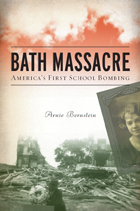 Bath Massacre: America's First School Bombing
Arnie Bernstein
University of Michigan Press, 2009 "With the meticulous attention to detail of a historian and a storyteller's eye for human drama, Bernstein shines a beam of truth on a forgotten American tragedy. Heartbreaking and riveting."
---Gregg Olsen, New York Times best-selling author of Starvation Heights
"A chilling and historic character study of the unfathomable suffering that desperation and fury, once unleashed inside a twisted mind, can wreak on a small town. Contemporary mass murderers Timothy McVeigh, Columbine's Dylan Klebold, and Virginia Tech's Seung-Hui Cho can each trace their horrific genealogy of terror to one man: Bath school bomber Andrew Kehoe."
---Mardi Link, author of When Evil Came to Good Hart On May 18, 1927, the small town of Bath, Michigan, was forever changed when Andrew Kehoe set off a cache of explosives concealed in the basement of the local school. Thirty-eight children and six adults were dead, among them Kehoe, who had literally blown himself to bits by setting off a dynamite charge in his car. The next day, on Kehoe's farm, what was left of his wife---burned beyond recognition after Kehoe set his property and buildings ablaze---was found tied to a handcart, her skull crushed. With seemingly endless stories of school violence and suicide bombers filling today's headlines, Bath Massacre serves as a reminder that terrorism and large-scale murder are nothing new.
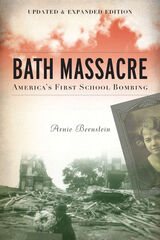 Bath Massacre, New Edition: America's First School Bombing
Arnie Bernstein
University of Michigan Press, 2022 The new edition of this Michigan Notable Book includes a new introduction and stories from interviews with two additional survivors, Myrna (Gates) Coulter and Ralph Witchell, which took place after the first edition was published in 2009.
On May 18, 1927, the small town of Bath, Michigan, was forever changed when Andrew Kehoe set off a cache of explosives concealed in the basement of the local school. Thirty-eight children and six adults were dead, among them Kehoe, who had literally blown himself to bits by setting off a dynamite charge in his car. The next day, on Kehoe's farm, what was left of his wife—burned beyond recognition after Kehoe set his property and buildings ablaze—was found tied to a handcart, her skull crushed. With seemingly endless stories of school violence and suicide bombers filling today's headlines, Bath Massacre serves as a reminder that terrorism and large-scale murder are nothing new.
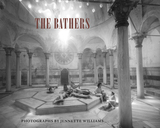 The Bathers
Jennette Williams
Duke University Press, 2009 Jennette Williams’s stunning platinum prints of women bathers in Budapest and Istanbul take us inside spaces intimate and public, austere and sensuous, filled with water, steam, tile, stone, ethereal sunlight, and earthly flesh. Over a period of eight years, Williams, who is based in New York City, traveled to Hungary and Turkey to photograph, without sentimentality or objectification, women daring enough to stand naked before her camera. Young and old, the women of The Bathers inhabit and display their bodies with comfort and ease—floating, showering, conversing, lost in reverie. To create the images in The Bathers, Williams drew on gestures and poses found in iconic paintings of nude women, including tableaux of bathers by Paul Cézanne and Auguste Renoir, renderings of Venus by Giorgione and Titian, Dominique Ingres’s Odalisque and Slave, and Pablo Picasso’s Les Demoiselles d’Avignon. By alluding to these images and others, Williams sought to reflect the religious and mythological associations of water with birth and rebirth, comfort and healing, purification and blessing. She also used copies of the paintings to communicate with her Hungarian- and Turkish-speaking subjects—homemakers, factory workers, saleswomen, secretaries, managers, teachers, and students. Working in steam-filled environments, Williams created quiet, dignified images that evoke not only canonical representations of female nudes but also early pictorial photography. At the same time, they raise contemporary questions about the gaze, the definition of documentary photography, and the representation and perception of beauty and femininity, particularly as they relate to the aging body. Above all else, her photos are sensuously evocative. They invite the viewer to feel the steam, hear the murmur of conversation, and reflect on the allure of the female form. A CDS Book
Published by Duke University Press and the Center for Documentary Photography
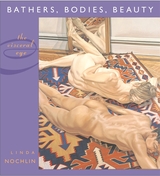 Bathers, Bodies, Beauty: The Visceral Eye
Linda Nochlin
Harvard University Press, 2006 A leading feminist art historian on the nude body, from impressionism to postmodernism.
To some viewers, Renoir’s Great Bathers is the very picture of female sensuality and beauty. To others, the sentimentalized, sexualized prettiness of the image embodies a whole tradition of masculine mastery and feminine display. Still others find in the bathers a feminine fantasy of bodily liberation. Juxtaposing these opposing points of view, Linda Nochlin deftly uncovers the dissonances surrounding artistic representation of the female form from the nineteenth century to the present.
Nochlin begins by focusing on the painterly preoccupation with bathing, whether at the beach, in lakes and rivers, in public swimming pools, or in bathtubs. Why, she asks, did the nude figure, posed in or near water, become such a dominant trope in the history of Western art? Covering artists from Manet, Cezanne, Bonnard, and Picasso to late-twentieth-century and contemporary figures such as Philip Pearlstein, Anselm Kiefer, Alice Neel, and Jenny Saville, Nochlin develops a rich interpretative collage of the layered meanings ascribed to bodies in intimate settings. She concludes with a powerful essay on aging, infirmity, and death.
A deeply personal book—Nochlin herself is depicted in more than one of the paintings she discusses, and her discussion of old age is inspired by her own looming mortality—Bathers, Bodies, Beauty draws on a lifetime of loving, hating, and wrestling with art to reveal both the visceral disappointments and supreme joys of seeing it from a feminist perspective.
 The Bath-Gymnasium Complex at Sardis
Fikret K. Yegül
Harvard University Press, 1986 The Bath-Gymnasium at Sardis is the most important known example of a complex that combines the gymnasium, a Greek institution, with the Roman bath, a unique architectural and cultural embodiment comparable in size and organization to the great Imperial thermae of Rome. The restoration by the Harvard-Cornell Expedition of the “Marble Court” or Imperial cult hall provides a rare opportunity to appreciate firsthand the scale and elegance of the major Imperial monuments.
In this fully illustrated volume Fikret Yegül describes the complex from the palaestra of the east through the richly decorated Marble Court to the vast swimming pool, lofty halls, and hot baths, including analysis of the excavation, evidence for structural systems, roofing, vaulting, and decoration, and the significance of building inscriptions. The author traces the building history from its completion in the second century through five centuries of renovation and redecoration. Mehmet Bolgil, a practicing architect who was in charge of the restoration at Sardis, contributes a clear description of the reconstruction process.
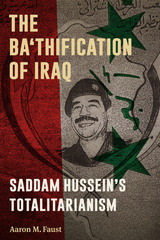 The Ba'thification of Iraq: Saddam Hussein's Totalitarianism
By Aaron M. Faust
University of Texas Press, 2015 Saddam Hussein ruled Iraq as a dictator for nearly a quarter century before the fall of his regime in 2003. Using the Ba’th party as his organ of meta-control, he built a broad base of support throughout Iraqi state and society. Why did millions participate in his government, parrot his propaganda, and otherwise support his regime when doing so often required betraying their families, communities, and beliefs? Why did the “Husseini Ba’thist” system prove so durable through uprisings, two wars, and United Nations sanctions? Drawing from a wealth of documents discovered at the Ba’th party’s central headquarters in Baghdad following the US-led invasion in 2003, The Ba’thification of Iraq analyzes how Hussein and the party inculcated loyalty in the population. Through a grand strategy of “Ba’thification,” Faust argues that Hussein mixed classic totalitarian means with distinctly Iraqi methods to transform state, social, and cultural institutions into Ba’thist entities, and the public and private choices Iraqis made into tests of their political loyalty. Focusing not only on ways in which Iraqis obeyed, but also how they resisted, and using comparative examples from Hitler’s Germany and Stalin’s Russia, The Ba’thification of Iraq explores fundamental questions about the roles that ideology and culture, institutions and administrative practices, and rewards and punishments play in any political system.
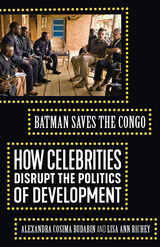 Batman Saves the Congo: How Celebrities Disrupt the Politics of Development
Alexandra Cosima Budabin
University of Minnesota Press, 2021 How celebrity strategic partnerships are disrupting humanitarian space
Can a celebrity be a “disrupter,” promoting strategic partnerships to bring new ideas and funding to revitalize the development field—or are celebrities just charismatic ambassadors for big business? Examining the role of the rich and famous in development and humanitarianism, Batman Saves the Congo argues that celebrities do both, and that understanding why and how yields insight into the realities of neoliberal development. In 2010, entertainer Ben Affleck, known for his superhero performance as Batman, launched the Eastern Congo Initiative to bring a new approach to the region’s development. This case study is central to Batman Saves the Congo. Affleck’s organization operates with special access, diversified funding, and significant support of elites within political, philanthropic, development, and humanitarian circuits. This sets it apart from other development organizations. With his convening power, Affleck has built partnerships with those inside and outside development, staking bipartisan political ground that is neither charity nor aid but “good business.” Such visible and recognizable celebrity humanitarians are occupying the public domain yet not engaging meaningfully with any public, argues Batman Saves the Congo. They are an unruly bunch of new players in development who amplify business solutions. As elite political participants, celebrities shape development practices through strategic partnerships that are both an innovative way to raise awareness and funding for neglected causes and a troubling trend of unaccountable elite leadership in North–South relations. Batman Saves the Congo helps illuminate the power of celebritized business solutions and the development contexts they create.
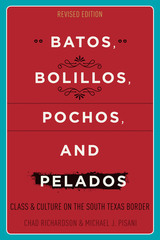 Batos, Bolillos, Pochos, and Pelados: Class and Culture on the South Texas Border
By Chad Richardson and Michael J. Pisani
University of Texas Press, 2017 A classic account of life on the Texas-Mexico border, Batos, Bolillos, Pochos, and Pelados offers the fullest portrait currently available of the people of the South Texas/Northern Mexico borderlands. First published in 1999, the book is now extensively revised and updated throughout to cover developments since 2000, including undocumented immigration, the drug wars, race relations, growing social inequality, and the socioeconomic gap between Latinos and the rest of American society—issues of vital and continuing national importance. An outgrowth of the Borderlife Research Project conducted at the University of Texas Rio Grande Valley, Batos, Bolillos, Pochos, and Pelados uses the voices of several hundred Valley residents, collected by embedded student researchers and backed by the findings of sociological surveys, to describe the lives of migrant farmworkers, colonia residents, undocumented domestic servants, maquiladora workers, and Mexican street children. Likewise, it explores social, racial, and ethnic relations in South Texas among groups such as Latinos, Mexican immigrants, wealthy Mexican visitors, Anglo residents or tourists, and Asian and African American residents of South Texas. With this firsthand material and an explanatory focus that utilizes and applies social-science theoretical concepts, the book thoroughly addresses the future composition and integration of Latinos into the society and culture of the United States.
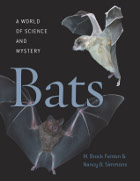 Bats: A World of Science and Mystery
M. Brock Fenton and Nancy B. Simmons
University of Chicago Press, 2015 There are more than 1,300 species of bats—or almost a quarter of the world’s mammal species. But before you shrink in fear from these furry “creatures of the night,” consider the bat’s fundamental role in our ecosystem. A single brown bat can eat several thousand insects in a night. Bats also pollinate and disperse the seeds for many of the plants we love, from bananas to mangoes and figs.
Bats: A World of Science and Mystery presents these fascinating nocturnal creatures in a new light. Lush, full-color photographs portray bats in flight, feeding, and mating in views that show them in exceptional detail. The photos also take the reader into the roosts of bats, from caves and mines to the tents some bats build out of leaves. A comprehensive guide to what scientists know about the world of bats, the book begins with a look at bats’ origins and evolution. The book goes on to address a host of questions related to flight, diet, habitat, reproduction, and social structure: Why do some bats live alone and others in large colonies? When do bats reproduce and care for their young? How has the ability to fly—unique among mammals—influenced bats’ mating behavior? A chapter on biosonar, or echolocation, takes readers through the system of high-pitched calls bats emit to navigate and catch prey. More than half of the world’s bat species are either in decline or already considered endangered, and the book concludes with suggestions for what we can do to protect these species for future generations to benefit from and enjoy.
From the tiny “bumblebee bat”—the world’s smallest mammal—to the Giant Golden-Crowned Flying Fox, whose wingspan exceeds five feet, A Battery of Bats presents a panoramic view of one of the world’s most fascinating yet least-understood species.
 Bats of the Rocky Mountain West: Natural History, Ecology, and Conservation
Rick A. Adams
University Press of Colorado, 2003 Since antiquity, bats have been misunderstood and shrouded in mystery. Given misnomers such as fledermaus ("flying mouse") and murciegalo ("blind mouse"), these nocturnal flying mammals were even classified as primates by the great Carl Linnaeus, based on his knowledge of the anatomy of large Old World fruit bats. In this beautifully illustrated volume, bat specialist Rick A. Adams delves into bats' true nature and the roles these fascinating ledurblaka ("leather flutterers") play in the natural history and ecology of the Rocky Mountain West. Bats of the Rocky Mountain West begins with a general discussion of bat biology and evolution as well as regional physiography and zoogeography. In addition, Adams describes - based on the results of extensive research - the behavior and ecology of the 31 species of bats found in Montana, Idaho, Wyoming, Utah, Colorado, New Mexico, and Arizona. Naturalists and biologists alike will benefit from the detailed species descriptions, color photographs and illustrations, distribution maps, and echolocation sonograms. Bats of the Rocky Mountain West is a unique and valuable reference for professional bat biologists, naturalists, and wildlife enthusiasts interested in the conservation and ecology of bats in the region.
 Bats of the Rocky Mountain West: Natural History, Ecology, and Conservation
Rick A. Adams
University Press of Colorado, 2025 In this fascinating biology of and guidebook to the bat species inhabiting the Rocky Mountain West, author Rick A. Adams exposes the true nature of bats and the roles these fascinating animals play in the natural history and ecology of the region.
In the twenty years since the original publication of Bats of the Rocky Mountain West, chiropterology (bat science) has exploded, significantly altering our understanding of the ecology, behavior, distribution, and conservation of one of the world's most enigmatic mammals. This notably updated second edition further brings to life the wonderful world of bats with beautiful illustrations and photography that grip the imagination and reveal the magnificent natural history of the only true flying mammal. In addition, thirty-two accounts of regional species with photographs, range maps, and echolocation sonograms report informative and thoroughly revised findings on bats now living in the Rocky Mountain West. Leave any preconceived notions behind and learn the real-life biology of bats, which eclipses the fabled tales of the crypt and macabre.
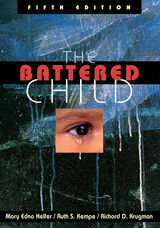 The Battered Child
Edited by Mary Edna Helfer, Ruth S. Kempe, and Richard D. Krugman
University of Chicago Press, 1999 First published in 1968, The Battered Child quickly became a landmark work. Our awareness of child abuse today is due in no small part to the remarkable impact of its first and subsequent editions.
The new edition of this classic text continues the legacy. While updating and significantly adding to previous editions, the fifth edition retains the multidisciplinary and comprehensive approach that initially set the work apart. This new edition contains chapters from professionals in such diverse fields as pediatrics, psychiatry, legal studies, and social work that reflect the past decade's extraordinary advances in research and techniques. Twenty of the book's 30 chapters are entirely new, while the remaining material has been extensively revised.
Part I provides a historical overview of child abuse and neglect as well as background material on the cultural, psychiatric, social, economic, and legal contexts of child maltreatment. Part II discusses the processes of assessing cases of physical, emotional, and sexual abuse and neglect from the unique perspectives of all the professionals involved, including teachers, pediatricians, and social workers. Part III describes intervention and treatment, focusing on legal issues, investigative procedures, and therapeutic processes, while Part IV addresses prevention and policy issues.
Previous editions of The Battered Child have earned the labels of "a classic" and a "Bible." With its up-to-date information, unequaled scope, and contributions from experts on every aspect of child abuse, the fifth edition of this cornerstone text is even more essential to the field than its predecessors.
"Comprehensive and up-to-date."—David Cottrell, British Journal of Psychiatry
"A valuable contribution to the field of abuse and neglect"—Prasanna Nair, Journal of the American Medical Association
 Battering States: The Politics of Domestic Violence in Israel
Madelaine Adelman
Vanderbilt University Press, 2017 Battering States explores the most personal part of people's lives as they intersect with a uniquely complex state system. The book examines how statecraft shapes domestic violence: how a state defines itself and determines what counts as a family; how a state establishes sovereignty and defends its borders; and how a state organizes its legal system and forges its economy. The ethnography includes stories from people, places, and perspectives not commonly incorporated in domestic violence studies, and, in doing so, reveals the transformation of intimate partner violence from a predictable form of marital trouble to a publicly recognized social problem.
The politics of domestic violence create novel entry points to understanding how, although women may be vulnerable to gender-based violence, they do not necessarily share the same kind of belonging to the state. This means that markers of identity and power, such as gender, nationality, ethnicity, religion and religiosity, and socio-economic and geographic location, matter when it comes to safety and pathways to justice.
The study centers on Israel, where a number of factors bring connections between the cultural politics of the state and domestic violence into stark relief: the presence of a contentious multinational and multiethnic population; competing and overlapping sets of religious and civil laws; a growing gap between the wealthy and the poor; and the dominant presence of a security state in people's everyday lives. The exact combination of these factors is unique to Israel, but they are typical of states with a diverse population in a time of globalization. In this way, the example of Israel offers insights wherever the political and personal impinge on one another.
Battery Management Systems and Inductive Balancing
Alex Van den Bossche
The Institution of Engineering and Technology, 2022 The application areas of batteries are currently booming. The recent generation of devices combines a high energy density with a reasonable cost and life expectancy, making them suitable not only for cars but also electric bikes, scooters, forklifts, gardening and household tools, storage batteries as well as airborne applications such as drones, helicopters, and small airplanes.
Battery State Estimation: Methods and models
Shunli Wang
The Institution of Engineering and Technology, 2022 Batteries are of vital importance for storing intermittent renewable energy for stationary and mobile applications. In order to charge the battery and maintain its capacity, the states of the battery - such as the current charge, safety and health, but also quantities that cannot be measured directly - need to be known to the battery management system. State estimation estimates the electrical state of a system by eliminating inaccuracies and errors from measurement data. Numerous methods and techniques are used for lithium-ion and other batteries. The various battery models seek to simplify the circuitry used in the battery management system.
 Batting Cleanup Bill Conlin
Kevin Kerrane
Temple University Press, 1997 For over three decades Bill Conlin has anchored one of America's best sports sections: the back pages of the Philadelphia Daily News. Conlin has spent his entire career in Philadelphia, starting with the Philadelphia Bulletin, but he is probably best known for his tremendous contribution to the Philadelphia Daily News. This sassy tabloid combines sharp reporting with lively opinion writing, provocative headlines, and its irreverent voice as a self-styled "People Paper." Its sports section, in particular, bristles with what Philadelphians call "atty-tude." "Batting Cleanup, Bill Conlin" is a collection of his best sports writing. From behind the scenes, Conlin presents athletes as all too human but his descriptions of game action convey the magnitude of the athletes' talent, and the demands of the sport itself. His writing is widely appreciated for the way it captures an intricate moment of baseball time through a series of sharp images and dynamic verbs.
In making the selections for this volume, editor Kevin Kerrane reveals how Conlin's playfulness with language and ideas has led to creative nicknames -- like "The Lowly Grim Giant" for Georgetown basketball coach John Thompson -- and tho entire stories based on outrageous premises. Who else would report a baseball game from the viewpoint of a space alien? Who else would interview God to find out what He really thinks about Randall Cunningham?
Conlin's columns deal with just about everything. Or maybe it just seems that way because he brings just about everything to bear on a topic that interests him: lessons from military history, characters from Shakespeare, personal experiences, persistent reporting, amusing one-liners, and laugh-out-loud jokes. His "King of the World" columns offer a fantasy of poetic justice in which fools and knaves are skewered, but with humor rather than heavy-handed moralizing. This humor, insight, keen intelligence, and a true love of sport has made Conlin a cult figure among sports fans. Kerrane explains such admiration this way: "It's not just because of Conlin's fierce honesty, or broad curiosity, or Irish wit, it's also because of his deep feeling for the values of sport -- which baseball, in his telling, crystallizes so beautifully.
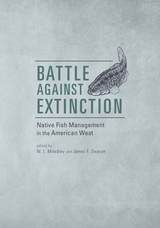 Battle Against Extinction: Native Fish Management in the American West
Edited by W. L. Minckley and James E. Deacon; Foreword by Stewart L. Udall
University of Arizona Press, 1991 In 1962 the Green River was poisoned and its native fishes killed so that the new Flaming Gorge Reservoir could be stocked with non-native game fishes for sportsmen. This incident was representative of water management in the West, where dams and other projects have been built to serve human needs without consideration for the effects of water diversion or depletion on the ecosystem. Indeed, it took a Supreme Court decision in 1976 to save Devils Hole pupfish from habitat destruction at the hands of developers. Nearly a third of the native fish fauna of North America lives in the arid West; this book traces their decline toward extinction as a result of human interference and the threat to their genetic diversity posed by decreases in their populations. What can be done to slow or end this tragedy? As the most comprehensive treatment ever attempted on the subject, Battle Against Extinction shows how conservation efforts have been or can be used to reverse these trends. In covering fishes in arid lands west of the Mississippi Valley, the contributors provide a species-by-species appraisal of their status and potential for recovery, bringing together in one volume nearly all of the scattered literature on western fishes to produce a monumental work in conservation biology. They also ponder ethical considerations related to the issue, ask why conservation efforts have not proceeded at a proper pace, and suggest how native fish protection relates to other aspects of biodiversity planetwide. Their insights will allow scientific and public agencies to evaluate future management of these animal populations and will offer additional guidance for those active in water rights and conservation biology. First published in 1991, Battle Against Extinction is now back in print and available as an open-access e-book thanks to the Desert Fishes Council.
 Battle Against Extinction: Native Fish Management in the American West
Edited by W. L. Minckley and James E. Deacon; Foreword by Stewart L. Udall
University of Arizona Press, 1991 In 1962 the Green River was poisoned and its native fishes killed so that the new Flaming Gorge Reservoir could be stocked with non-native game fishes for sportsmen. This incident was representative of water management in the West, where dams and other projects have been built to serve human needs without consideration for the effects of water diversion or depletion on the ecosystem. Indeed, it took a Supreme Court decision in 1976 to save Devils Hole pupfish from habitat destruction at the hands of developers.
Nearly a third of the native fish fauna of North America lives in the arid West; this book traces their decline toward extinction as a result of human interference and the threat to their genetic diversity posed by decreases in their populations. What can be done to slow or end this tragedy? As the most comprehensive treatment ever attempted on the subject, Battle Against Extinction shows how conservation efforts have been or can be used to reverse these trends.
In covering fishes in arid lands west of the Mississippi Valley, the contributors provide a species-by-species appraisal of their status and potential for recovery, bringing together in one volume nearly all of the scattered literature on western fishes to produce a monumental work in conservation biology. They also ponder ethical considerations related to the issue, ask why conservation efforts have not proceeded at a proper pace, and suggest how native fish protection relates to other aspects of biodiversity planetwide. Their insights will allow scientific and public agencies to evaluate future management of these animal populations and will offer additional guidance for those active in water rights and conservation biology.
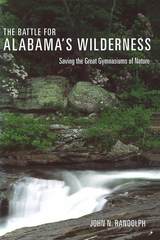 The Battle for Alabama's Wilderness: Saving the Great Gymnasiums of Nature
John N. Randolph
University of Alabama Press, 2005 Traces the development of Alabama's environmental movement from its beginnings with the establishment of The Alabama Conservancy in the late 1960s and early '70s to the preservation efforts of present-day activist groups The grassroots effort to preserve Alabama's Wilderness Areas spanned thirty years, from 1967 to 1997. The first battle, to establish the Sipsey Wilderness in the Bankhead National Forest, was the catalyst for reform of national policy regarding public land preserves in the eastern United States. It, and the later campaigns—to establish the Cheaha Wilderness, to enlarge the Sipsey, and to create the Dugger Mountain Wilderness—are classic tales of citizen activists overcoming the quagmire of federal bureaucracy and the intransigence of hostile politicians. Early political opposition to proposed designation or expansion of wilderness areas in Alabama was based on the belief that limiting development of these lands would negatively impact the state's powerful timber industry. In response to such opposition, serious environmental activism was born in Alabama. Using newspaper reports, Congressional testimony, interviews, and his own recollections, John Randolph traces the development of Alabama's environmental movement from its beginnings with the establishment of The Alabama Conservancy in the late 1960s and early '70s to the preservation efforts of present-day activist groups, such as the Alabama Environmental Council, the Cahaba River Society, and the Alabama Wilderness Alliance. The Battle for Alabama's Wilderness permits all of the players—pro and con—to speak for themselves, but the heroes—people like Mary Burks, Blanche Dean, Joab Thomas, and Pete Conroy—embody the vision, hope, and persistence required of those who succeed in their preservation efforts. Randolph's account is a testament to the power of grassroots citizen groups who are committed to a common cause and inspired by a shared ideal.
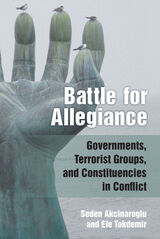 Battle for Allegiance: Governments, Terrorist Groups, and Constituencies in Conflict
Seden Akcinaroglu and Efe Tokdemir
University of Michigan Press, 2020 Domestic terrorist groups, like all violent nonstate actors, compete with governments for their monopoly on violence and their legitimacy in representing the citizenry. Battle for Allegiance shows violence is neither the only nor the most effective way in which nonstate actors and governments work to achieve their goals. As much as nonviolent strategies are a rarely considered piece of the puzzle, the role of the audience is another crucial piece often downplayed in the literature. Many studies emphasize the interactions between the government and the terrorist group at the expense of the constituency, but the constituency is the common cluster for both actors to gain legitimacy and to demand its allegiance. In fact, the competition between the two actors goes far beyond who is superior in terms of military force and tactics. The hardest battles are fought over the allegiance of the citizens.
Using a multimethod approach based on exclusive interviews and focus groups from Turkey and large N original data from around the world, Seden Akcinaroglu and Efe Tokdemir present the first systematic empirical analysis of the ways in which terrorist groups, the government, and the citizens relate to each other in a triadic web of action. They study the nonviolent actions of terrorist groups toward their constituencies, the nonviolent actions of governments toward terrorists, and the nonviolent actions of governments toward the terrorist group’s constituencies. By investigating the causes, targets, and consequences of accommodative actions, this book sheds light on an important, but generally ignored, aspect of terrorism: interactive nonviolent strategies.
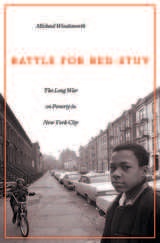 Battle for Bed-Stuy: The Long War on Poverty in New York City
Michael Woodsworth
Harvard University Press, 2016 Half a century after the launch of the War on Poverty, its complex origins remain obscure. Battle for Bed-Stuy reinterprets President Lyndon Johnson’s much-debated crusade from the perspective of its foot soldiers in New York City, showing how 1960s antipoverty programs were rooted in a rich local tradition of grassroots activism and policy experiments.
Bedford-Stuyvesant, a Brooklyn neighborhood housing 400,000 mostly black, mostly poor residents, was often labeled “America’s largest ghetto.” But in its elegant brownstones lived a coterie of home-owning professionals who campaigned to stem disorder and unify the community. Acting as brokers between politicians and the street, Bed-Stuy’s black middle class worked with city officials in the 1950s and 1960s to craft innovative responses to youth crime, physical decay, and capital flight. These partnerships laid the groundwork for the federal Community Action Program, the controversial centerpiece of the War on Poverty. Later, Bed-Stuy activists teamed with Senator Robert Kennedy to create America’s first Community Development Corporation, which pursued housing renewal and business investment.
Bed-Stuy’s antipoverty initiatives brought hope amid dark days, reinforced the social safety net, and democratized urban politics by fostering citizen participation in government. They also empowered women like Elsie Richardson and Shirley Chisholm, who translated their experience as community organizers into leadership positions. Yet, as Michael Woodsworth reveals, these new forms of black political power, though exercised in the name of poor people, often did more to benefit middle-class homeowners. Bed-Stuy today, shaped by gentrification and displacement, reflects the paradoxical legacies of midcentury reform.
 The Battle for Children: World War II, Youth Crime, and Juvenile Justice in Twentieth-Century France
Sarah Fishman
Harvard University Press, 2002 The Battle for Children links two major areas of historical inquiry: crime and delinquency with war and social change. In a study based on impressive archival research, Sarah Fishman reveals the impact of the Vichy regime on one of history’s most silent groups—children—and offers enlightening new information about the Vichy administration.
Fishman examines how French children experienced the events of war and the German occupation, demonstrating that economic deprivation, not family dislocation, sharply drove up juvenile crime rates. Wartime circumstances led authorities to view delinquent minors as victims, and provided the opportunity for reformers in psychiatry, social work, and law to fundamentally transform France’s punitive juvenile justice system into a profoundly therapeutic one. Vichy-era legislation thus formed the foundation of the modern juvenile justice system in France, which rarely incarcerates delinquent youth.
In her examination of the critical but unexpected role the war and the authoritarian Vichy regime played in the transformation of France’s juvenile courts and institutions, Fishman has enriched our knowledge of daily life in France during World War II, refined our understanding of Vichy’s place in the historical development of France, and provided valuable insights into contemporary debates on juvenile justice.
 The Battle for China's Past: Mao and the Cultural Revolution
Mobo Gao
Pluto Press, 2008 Mao and his policies have long been demonised in the West, with the Cultural Revolution considered a fundamental violation of human rights.
As China embraces capitalism, the Mao era is being surgically denigrated by the Chinese political and intellectual elite. This book tackles the extremely negative depiction of China under Mao in recent publications and argues most people in China, including the rural poor and the urban working class, actually benefited from Mao's policy of a comprehensive welfare system for the urban and basic health and education provision for the rural, which is being reversed in the current rush towards capitalism.
By a critical analysis of the mainstream account of the Mao era and the Cultural Revolution and by revealing what is offered in the unofficial e-media debates this book sets the record straight, making a convincing argument for the positive effects of Mao's policies on the well-being of the Chinese people.
The Battle for Europe: How an Elite Hijacked a Continent - and How we Can Take it Back
Thomas Fazi
Pluto Press, 2014 The Battle for Europe brings into sharp focus the historical importance of the current Eurozone crisis. Thomas Fazi argues that European Union (EU) elites have seized on the financial crash to push through damaging neoliberal policies, undermining social cohesion and vital public services.
Drawing on a wealth of sources, Fazi argues that the EU’s austerity policies are not simply a case of political and ideological short-sightedness, but part of a long-term project by elites to remove the last remnants of the welfare state and complete the neoliberal project.
As well as an urgent critique of the EU and monetary union as currently constituted, The Battle for Europe showcases a programme for progressive reform and outlines how citizens and workers of Europe can radically overhaul EU institutions.
 The Battle for Guadalcanal
Samuel B. Griffith II
University of Illinois Press, 1963 Masterful pacing, vivid character sketches, and gripping action blend with rigorous historical detail in Samuel B. Griffith's The Battle for Guadalcanal.
Launched on August 7, 1942, to protect Allied control of the strategic South Pacific islands, the Guadalcanal operation was the most costly American offensive of World War II in the history of the U.S. Navy up to that time. Griffith, who fought with Edson's Raiders on Guadalcanal, describes in gritty detail the vicious close-range fighting, the valiant defense of the Henderson Field airstrip, and the dramatic naval engagements that led, in February 1943, to an American victory.
Drawing on American and Japanese sources, Griffith delineates the strategic decisions that shaped the conflict as well as the determination and endurance of combatants on both sides. A breathtaking narrative of military action anchored by a historian's objectivity, The Battle for Guadalcanal is a story of raw courage, desperate measures, and ultimate triumph.
The Battle For Homestead, 1880-1892: Politics, Culture, and Steel
Paul Krause
University of Pittsburgh Press, 1992 Paul Krause calls upon the methods and insights of labor history, intellectual history, anthropology, and the history of technology to situate the events of the lockout and their significance in the broad context of America’s Guilded Age. Utilizing extensive archival material, much of it heretofore unknown, he reconstructs the social, intellectual, and political climate of the burgeoning post-Civil War steel industry.
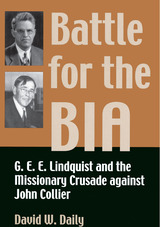 Battle for the BIA: G. E. E. Lindquist and the Missionary Crusade against John Collier
David W. Daily
University of Arizona Press, 2004 By the end of the nineteenth century, Protestant leaders and the Bureau of Indian Affairs had formed a long-standing partnership in the effort to assimilate Indians into American society. But beginning in the 1920s, John Collier emerged as part of a rising group of activists who celebrated Indian cultures and challenged assimilation policies. As commissioner of Indian affairs for twelve years, he pushed legislation to preserve tribal sovereignty, creating a crisis for Protestant reformers and their sense of custodial authority over Indians. Although historians have viewed missionary opponents of Collier as faceless adversaries, one of their leading advocates was Gustavus Elmer Emmanuel Lindquist, a representative of the Home Missions Council of the Federal Council of Churches. An itinerant field agent and lobbyist, Lindquist was in contact with reformers, philanthropists, government officials, other missionaries, and leaders in practically every Indian community across the country, and he brought every ounce of his influence to bear in a full-fledged assault on Collier’s reforms. David Daily paints a compelling picture of Lindquist’s crusade—a struggle bristling with personal animosity, political calculation, and religious zeal—as he promoted Native Christian leadership and sought to preserve Protestant influence in Indian affairs. In the first book to address this opposition to Collier’s reforms, he tells how Lindquist appropriated the arguments of the radical assimilationists whom he had long opposed to call for the dismantling of the BIA and all the forms of race-based treatment that he believed were associated with it. Daily traces the shifts in Lindquist’s thought regarding the assimilation question over the course of half a century, and in revealing the efforts of this one individual he sheds new light on the whole assimilation controversy. He explicates the role that Christian Indian leaders played in both fostering and resisting the changes that Lindquist advocated, and he shows how Protestant leaders held on to authority in Indian affairs during Collier’s tenure as commissioner. This survey of Lindquist’s career raises important issues regarding tribal rights and the place of Native peoples in American society. It offers new insights into the domestic colonialism practiced by the United States as it tells of one of the great untold battles in the history of Indian affairs.
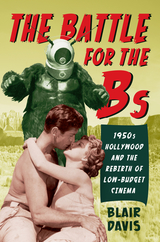 The Battle for the Bs: 1950s Hollywood and the Rebirth of Low-Budget Cinema
Davis, Blair
Rutgers University Press, 2012 The emergence of the double-bill in the 1930s created a divide between A-pictures and B-pictures as theaters typically screened packages featuring one of each. With the former considered more prestigious because of their larger budgets and more popular actors, the lower-budgeted Bs served largely as a support mechanism to A-films of the major studios—most of which also owned the theater chains in which movies were shown. When a 1948 U.S. Supreme Court antitrust ruling severed ownership of theaters from the studios, the B-movie soon became a different entity in the wake of profound changes to the corporate organization and production methods of the major Hollywood studios.
In The Battle for the Bs, Blair Davis analyzes how B-films were produced, distributed, and exhibited in the 1950s and demonstrates the possibilities that existed for low-budget filmmaking at a time when many in Hollywood had abandoned the Bs. Made by newly formed independent companies, 1950s B-movies took advantage of changing demographic patterns to fashion innovative marketing approaches. They established such genre cycles as science fiction and teen-oriented films (think Destination Moon and I Was a Teenage Werewolf) well before the major studios and also contributed to the emergence of the movement now known as underground cinema. Although frequently proving to be multimillion-dollar box-office draws by the end of the decade, the Bs existed in opposition to the cinematic mainstream in the 1950s and created a legacy that was passed on to independent filmmakers in the decades to come.
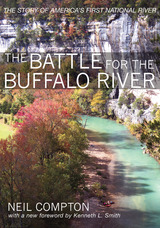 The Battle for the Buffalo River: The Story of America's First National River
Neil Compton
University of Arkansas Press, 2010 Under the auspices of the 1938 Flood Control Act, the U.S. Corps of Engineers began to pursue an aggressive dam-building campaign. A grateful public generally lauded their efforts, but when they turned their attention to Arkansas’s Buffalo River, the vocal opposition their proposed projects generated dumbfounded them. Never before had anyone challenged the Corps’s assumption that damming a river was an improvement. Led by Neil Compton, a physician in Bentonville, Arkansas, a group of area conservationists formed the Ozark Society to join the battle for the Buffalo. This book is the account of this decade-long struggle that drew in such political figures as supreme court justice William O. Douglas, Senator J. William Fulbright, and Governor Orval Faubus. The battle finally ended in 1972 with President Richard Nixon’s designation of the Buffalo as the first national river. Drawing on hundreds of personal letters, photographs, maps, newspaper articles, and reminiscences, Compton’s lively book details the trials, gains, setbacks, and ultimate triumph in one of the first major skirmishes between environmentalists and developers.
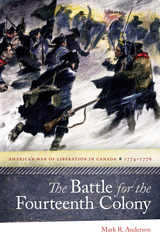 The Battle for the Fourteenth Colony: America’s War of Liberation in Canada, 1774–1776
Mark R. Anderson
University Press of New England, 2013 In this dramatic retelling of one of history’s great “what-ifs,” Mark R. Anderson examines the American colonies’ campaign to bring Quebec into the Continental confederation and free the Canadians from British “tyranny.” This significant reassessment of a little-studied campaign examines developments on both sides of the border that rapidly proceeded from peaceful diplomatic overtures to a sizable armed intervention. The military narrative encompasses Richard Montgomery’s plodding initial operations, Canadian partisan cooperation with officers like Ethan Allen, and the harrowing experiences of Benedict Arnold’s Kennebec expedition, as well as the sudden collapse of British defenses that secured the bulk of the province for the rebel cause. The book provides new insight into both Montgomery’s tragic Québec City defeat and a small but highly significant loyalist uprising in the rural northern parishes that was suppressed by Arnold and his Canadian patriot allies. Anderson closely examines the evolving relationships between occupiers and occupied, showing how rapidly changing circumstances variously fostered cooperation and encouraged resistance among different Canadian elements. The book homes in on the key political and military factors that ultimately doomed America’s first foreign war of liberation and resulted in the Continental Army’s decisive expulsion from Canada on the eve of the Declaration of Independence. The first full treatment of this fascinating chapter in Revolutionary War history in over a century, Anderson’s account is especially revealing in its presentation of contentious British rule in Quebec, and of Continental beliefs that Canadiens would greet the soldiers as liberators and allies in a common fight against the British yoke. This thoroughly researched and action-packed history will appeal to American and Canadian history buffs and military experts alike.
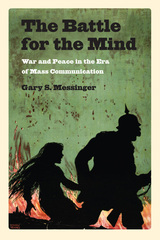 The Battle for the Mind: War and Peace in the Era of Mass Communication
Gary S. Messinger
University of Massachusetts Press, 2011 Most people typically think of armed conflict in physical terms, involving guns and bombs, ships and planes, tanks and missiles. But today, because of mass communication, war and the effort to prevent it are increasingly dependent on non-physical factors--the capacity to persuade combatants and citizens to engage in violence or avoid it, and the packaging of the information on which decision making is based. This book explores the many ways that mass communication has revolutionized international relations, whether the aim is to make war effectively or to prevent it.
Gary Messinger shows that over the last 150 years a succession of breakthroughs in the realm of media has reshaped the making of war and peace. Along with mass newspapers, magazines, books, motion pictures, radio, television, computer software, and telecommunication satellites comes an array of strategies for exploiting these media to control popular beliefs and emotions. Images of war now arrive in many forms and reach billions of people simultaneously. Political and military leaders must react to crowd impulses that sweep around the globe. Nation-states and nongovernmental groups, including terrorists, use mass communication to spread their portrayals of reality.
Drawing on a wide range of media products, from books and articles to films and television programs, as well as his own research in the field of propaganda studies, Messinger offers a fresh and comprehensive overview. He skillfully charts the path that has led us to our current situation and suggests where we might go next.
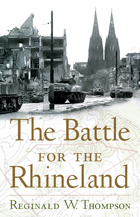 The Battle for the Rhineland
Reginald W. Thompson
Westholme Publishing, 2012 An Engrossing Study of the British and American Victory Over the German Army in the West During World War II
In this fascinating account of the critical final campaign against Nazi Germany on the western front, Reginald W. Thompson focuses on both the command decisions by the British and American generals and the performance of the enlisted men in order to explain the complex series of events that led to the German defeat in World War II. During the planning and run-up to what was intended to be a massive joint British and American push across the Rhine River and into the heart of Germany, the Allies encountered unexpected setbacks. Operation Market-Garden, the Allied aerial assault of the Low Countries, ended in disaster, while the attack through the Hu¨rtgen Forest was met by unexpected heavy resistance due to the build-up for the German surprise counterstrike planned for December 1944, what would become known as the Battle of the Bulge. The author identifies the attack on the town of Schmidt in the Hu¨rtgen Forest as the key battle that set in motion a series of events that both prolonged the war and shaped Allied strategy in their effort to cross the Rhine. Here the reader will learn the chain of decisions that allowed the Allies to pressure German forces between the Roer and Rhine rivers and move on Cologne, Dusseldorf, and other key points, including the famous bridge over the Rhine at Remagen, near Bonn. Based on both American and British official reports and the author’s independent research and originally published in 1958, The Battle for the Rhineland is a lucid, balanced, and engaging account of a critical period in Western Europe during the Second World War.
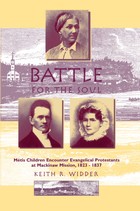 Battle for the Soul: Mètis Children Encounter Evangelical Protestants at Mackinaw Mission, 1823-1837
Keith R. Widder
Michigan State University Press, 1999 In 1823 William and Amanda Ferry opened a boarding school for Métis children on Mackinac Island, Michigan Territory, setting in motion an intense spiritual battle to win the souls and change the lives of the children, their parents, and all others living at Mackinac. Battle for the Soul demonstrates how a group of enthusiastic missionaries, empowered by an uncompromising religious motivation, served as agents of Americanization. The Ferrys' high hopes crumbled, however, as they watched their work bring about a revival of Catholicism and their students refuse to abandon the fur trade as a way of life. The story of the Mackinaw Mission is that of people who held differing world views negotiating to create a "middle-ground," a society with room for all.
Widder's study is a welcome addition to the literature on American frontier missions. Using Richard White's "middle ground" paradigm, it focuses on the cultural interaction between French, British, American, and various native groups at the Mackinac mission in Michigan during the early 19th century. The author draws on materials from the American Board of Commissioners for Foreign Missions archives, as well as other manuscript sources, to trace not only the missionaries' efforts to Christianize and Americanize the native peoples, but the religious, social, and cultural conflicts between Protestant missionaries and Catholic priests in the region. Much attention has been given to the missionaries to the Indians in other areas of the US, but little to this region.
 The Battle for the University of Alabama: The Perilous Path of Higher Education in the Reconstruction South
William Warren Rogers, Jr.
University of Alabama Press, 2025 Traces the little-known story of the bitter contest for the fate of the University of Alabama after the Civil War In The Battle for the University of Alabama, William Warren Rogers Jr. gives a fascinating account of the fierce struggle over the nature of the University of Alabama after the Civil War. Union forces reduced the campus to ruins as the war ended, and the university did not reopen until 1869. In the interregnum, powerful forces shifted the trajectory of the school. Alabama Republicans authored an egalitarian state constitution that delivered oversight of the university to the Republican Party. That set the stage for turmoil and confrontation. This book tells the story of that conflict. In the next few years, Democrats charged Republicans with turning the university into a “radical” institution. They alleged that a handful of unqualified individuals had gained faculty positions because of their political allegiance, which resulted in the university’s academic desecration. Professors were bitterly denounced in the state newspaper press and quite personally in Tuscaloosa. Administration of the university became part of the fratricidal political debate in the state. Political violence and questions concerning race, specifically the possible integration of the university, illuminated the controversies of the Reconstruction years. Many of these questions resonate even today. This authoritative account sets events at the University of Alabama against the backdrop of what occurred at other state universities in the Reconstruction South. The University of North Carolina experienced controversy similar to Alabama’s. At the University of Georgia, however, calm prevailed. This story of the incendiary events at Alabama’s flagship university charts new ground and provides a revelatory look into the extraordinary partisanship that characterized the South after the Civil War.
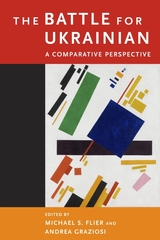 The Battle for Ukrainian: A Comparative Perspective
Michael S. Flier
Harvard University Press In 1863 the Valuev Circular restricted the use of the Ukrainian language in the Russian Empire. In the 150 years since, Ukrainian has followed a tortuous path, reflecting or anticipating tsarist, Soviet, and post-Soviet history. This volume documents that path, studying the language’s emergence in southern Rus´, its shifting fortunes in the Russian Empire and Soviet Union, and its variable status after 1991.
Ukrainian can serve as a useful prism for assessing 150 years of imperial disintegration and reformation, and worldwide state and nation building—a period in which other languages have been created, promoted, and repressed, or have come to coexist in multilingual nations. Case studies of Gaelic, Finnish, Yiddish, the Baltic group, and of language policy in Canada, India, and the former Yugoslavia illuminate similarities and differences in chronological, comparative, international, and transnational terms. The result is an interdisciplinary study that is essential for understanding language, history, and politics in Ukraine and in the post-imperial world.
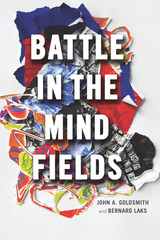 Battle in the Mind Fields
John A. Goldsmith and Bernard Laks
University of Chicago Press, 2019 “We frequently see one idea appear in one discipline as if it were new, when it migrated from another discipline, like a mole that had dug under a fence and popped up on the other side.”
Taking note of this phenomenon, John Goldsmith and Bernard Laks embark on a uniquely interdisciplinary history of the genesis of linguistics, from nineteenth-century currents of thought in the mind sciences through to the origins of structuralism and the ruptures, both political and intellectual, in the years leading up to World War II. Seeking to explain where contemporary ideas in linguistics come from and how they have been justified, Battle in the Mind Fields investigates the porous interplay of concepts between psychology, philosophy, mathematical logic, and linguistics. Goldsmith and Laks trace theories of thought, self-consciousness, and language from the machine age obsession with mind and matter to the development of analytic philosophy, behaviorism, Gestalt psychology, positivism, and structural linguistics, emphasizing throughout the synthesis and continuity that has brought about progress in our understanding of the human mind. Arguing that it is impossible to understand the history of any of these fields in isolation, Goldsmith and Laks suggest that the ruptures between them arose chiefly from social and institutional circumstances rather than a fundamental disparity of ideas.
 The Battle of Adwa: African Victory in the Age of Empire
Raymond Jonas
Harvard University Press, 2011 In March 1896 a well-disciplined and massive Ethiopian army did the unthinkable-it routed an invading Italian force and brought Italy's war of conquest in Africa to an end. In an age of relentless European expansion, Ethiopia had successfully defended its independence and cast doubt upon an unshakable certainty of the age-that sooner or later all Africans would fall under the rule of Europeans. This event opened a breach that would lead, in the aftermath of world war fifty years later, to the continent's painful struggle for freedom from colonial rule.
Raymond Jonas offers the first comprehensive account of this singular episode in modern world history. The narrative is peopled by the ambitious and vain, the creative and the coarse, across Africa, Europe, and the Americas-personalities like Menelik, a biblically inspired provincial monarch who consolidated Ethiopia's throne; Taytu, his quick-witted and aggressive wife; and the Swiss engineer Alfred Ilg, the emperor's close advisor. The Ethiopians' brilliant gamesmanship and savvy public relations campaign helped roll back the Europeanization of Africa.
Figures throughout the African diaspora immediately grasped the significance of Adwa, Menelik, and an independent Ethiopia. Writing deftly from a transnational perspective, Jonas puts Adwa in the context of manifest destiny and Jim Crow, signaling a challenge to the very concept of white dominance. By reopening seemingly settled questions of race and empire, the Battle of Adwa was thus a harbinger of the global, unsettled century about to unfold.
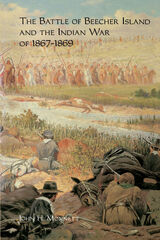 The Battle of Beecher Island and the Indian War of 1867-1869
John H. Monnett
University Press of Colorado, 1994 During the morning hours of September 17, 1868, on a sandbar in the middle of the Republican River in eastern Colorado, a large group of Cheyenne Dog Soldiers, Araphaho, and Sioux attacked about fifty civilian scouts under the command of Major George A. Forsyth. For two days the scouts held off repeated charges before the Indian warriors departed. For nine days, the scouts lived off the meat of their horses until additional forces arrived to relieve them. Five scouts were killed and eighteen wounded during the encounter that later came to be known as the Battle of Beecher Island.
Monnett's compelling study is the first to examine the Beecher Island Battle and its relationship to the overall conflict between American Indians and Euroamericans on the central plains of Colorado and Kansas during the late 1860s. Focusing on the struggle of the Cheyenne Dog Soldiers warrior society to defend the lands between the Republican River valley and the Smoky Hill River valley from Euroamerican encroachment, Monnett presents original reminiscences of American Indian and Euroamerican participants. Unlike many military studies of the Indian Wars, The Battle of Beecher Island also includes in-depth examinations of the viewpoints of homesteaders and the views of western railroad interests of the late nineteenth century.
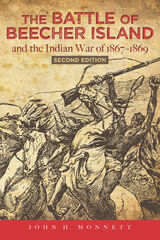 The Battle of Beecher Island and the Indian War of 1867-1869: Second Edition
John Monnett
University Press of Colorado, 2021 During the morning hours of September 17, 1868, on a sandbar in the middle of the Arikaree Fork of the Republican River in eastern Colorado, a large group of Cheyenne Dog Men, Arapaho, and Sioux attacked about fifty civilian scouts under the command of Major George A. Forsyth. For two days the scouts held off repeated charges before the Indian warriors departed. For nine days, the scouts lived off the meat of their horses until additional forces arrived to relieve them. Five scouts were killed and eighteen wounded during the encounter that later came to be known as the Battle of Beecher Island.
Monnett’s compelling study, a finalist for the Western Writers of America’s Spur Award in 1993, was the first to examine the Beecher Island battle and its relationship to the overall conflict between American Indians and Euroamericans on the central plains of Colorado and Kansas during the late 1860s. Focusing on the struggle of the Cheyenne Dog Men warrior society to defend the lands between the Republican River valley and the Smoky Hill River valley from Euroamerican encroachment, Monnett presents original reminiscences of American Indian and Euroamerican participants.
Since its original release several developments and an important original source document have come to light and offer new information. The second edition presents and examines these new discoveries and developments that moderate the original interpretive causes and more modern effects of this historical episode. Scholars and general readers alike interested in this important episode in the post–Civil War conflicts on the Great Plains and western history will find this new edition of The Battle of Beecher Island and the Indian War of 1867–1869 illuminating, surprising, and perhaps even controversial.
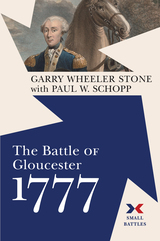 The Battle of Gloucester, 1777
Garry Wheeler Stone
Westholme Publishing, 2022 The Marquis de Lafayette, a nineteen-year-old French youth, arrived in Philadelphia at the end of July 1777. He was a rich aristocrat, but he was unpretentious, charming, and eager to learn. Introduced to George Washington, he joined the commander-in-chief at the Battle of Brandywine in September, where he proved that he was courageous. Soon after, the British occupied Philadelphia and prepared to control the Delaware River, vital as a supply route. In November, the marquis volunteered to go to New Jersey with Major General Nathanael Greene and a detachment sent to defend Fort Mercer, a Delaware River fort controlling shipping access to Philadelphia. Mercer was threatened by an approaching enemy column led by Lord Charles Cornwallis. The Continentals were unable to reach Fort Mercer in time to save it, but Lafayette had ridden ahead of Greene to reconnoiter. He discovered a 350-man picket of German riflemen (jägers) guarding Cornwallis’s camp, and with ten light dragoons, 150 riflemen from Daniel Morgan’s Rifle Corps, and perhaps 200 New Jersey militia, he attacked. In forty-five minutes, Lafayette’s little band drove the jägers back two and a half miles, almost to Cornwallis’s camp. When the news of Lafayette’s small victory reached the Continental Congress at York, Pennsylvania, the delegates were elated—this was the only good news amid the gloom over the loss of Philadelphia and control of the Delaware River. Massachusetts delegate James Lovell relayed a glowing account of the skirmish to John Adams, concluding with “Genl. Greene says the Marquis seems determined to court Danger. I wish more were so determined.”
In The Battle of Gloucester, 1777, archaeological historian Garry Wheeler Stone, with the assistance of historian Paul W. Schopp, recreates this minor but important clash during the Philadelphia campaign. Relying on both primary source documents and the latest archaeological interpretations, the authors have determined the course of this fascinating “battle,” as Benjamin Franklin later proclaimed it to be. As a result of this action, when Washington requested that Lafayette be given a division, Congress agreed. On December 4, 1777, the marquis, promoted to major-general, took command of the brigades of Generals Woodford and Scott to begin what would be a glorious career in American service.
Small Battles: Military History as Local History
Mark Edward Lender and James Kirby Martin, Series Editors
Small Battles offers a fresh and important new perspective on the story of America’s early conflicts. It was the small battles, not the clash of major armies, that truly defined the fighting during the colonial wars, the American Revolution, the War of 1812, and the hostilities on the frontiers. This is dramatic military history as seen through the prism of local history—history with a depth of detail, a feeling for place, people, and the impact of battle and its consequences that the story of major battles often cannot convey. The Small Battles series focuses on America’s military conflicts at their most intimate and revealing level.
 The Battle of Harlem Heights, 1776
David Price
Westholme Publishing, 2022 The Battle of Harlem Heights is an underappreciated milestone in American military history. The engagement on upper Manhattan Island on September 16, 1776, was the first successful battle for George Washington’s troops in the quest for independence from Great Britain and presaged the emergence of an effective fighting force among the citizen-soldiers who made up the Continental Army. The cooperative effort of regiments from New England, Maryland, and Virginia—whose men lacked any sense of national identity before the Revolution—indicated the potential for this fledgling army to cohere around a common national purpose and affiliation and become the primary instrument for securing America’s right to self-rule.
The action began when a contingent of rangers led by Col. Thomas Knowlton of Connecticut encountered British light infantry while conducting a reconnaissance mission on Washington’s orders. What began as a skirmish transformed into a full-fledged battle as both sides reinforced, and a heavy engagement continued for several hours until, with ammunition running low, the British withdrew. Washington decided not to pursue and risk confrontation with a larger force, thereby keeping his army intact. In The Battle of Harlem Heights, 1776, David Price conveys the significance of the Continental Army’s first victory and highlights the role of one of its key participants, the largely forgotten Knowlton—the “father of American military intelligence”—who gave his life during the action while urging his rangers forward. No matter how many times U.S. Army troops have recorded a battlefield success over the past two and a half centuries—whether on American soil, in a European wood, across a Middle Eastern desert, or on a Pacific island—one thing about that history remains indisputable. They did it first at Harlem Heights.
Small Battles: Military History as Local History
Mark Edward Lender and James Kirby Martin, Series Editors
Small Battles offers a fresh and important new perspective on the story of America’s early conflicts. It was the small battles, not the clash of major armies, that truly defined the fighting during the colonial wars, the American Revolution, the War of 1812, and the hostilities on the frontiers. This is dramatic military history as seen through the prism of local history—history with a depth of detail, a feeling for place, people, and the impact of battle and its consequences that the story of major battles often cannot convey. The Small Battles series focuses on America’s military conflicts at their most intimate and revealing level.
 Battle Of Kosovo
John Matthias
Ohio University Press, 1987 The Battle of Kosovo cycle of heroic ballads is generally considered the finest work of Serbian folk poetry. Commemorating the Serbian Empire’s defeat at the hands of the Turks in the late fourteenth century, these poems and fragments have been known for centuries in Eastern Europe. With the appearance of the collections of Serbian folk poems by Vuk Stefanovic Karasdzic, the brilliance of the poetry in the Kosovo and related cycles of ballads was affirmed by poets and critics as deeply influential as Goethe, Jacob Brimm, Adam Mickiewicz, and Alexander Pushkin. Although translations into English have been attempted before, few of them, as Charles Simic notes in his preface, have been persuasive until now. Simic compares the movement of the verse in these translations to the “variable foot” effect of William Carlos Williams’s later poetry, and argues that John Matthias “grasps the poetic strategies of the anonymous Serbian poet as well as Pound did those of Chinese poetry.” First published in 1987, the translation of the Battle of Kosovo is now reprinted both because of its intrinsic merits and because the recent crisis in Kosovo itself compels the entire world to understand the nature of the ancient conflicts and passions that fuel it. Although Matthias and Simic have elected to retain their original preface and introduction, Christopher Merrill, a scholar of the region and author of Only the Nails Remain, has contributed a brief afterword explaining the importance of this poetry in the context of NATO’s first military action ever against a sovereign nation.
The Battle of Lepanto
Elizabeth R. Wright
Harvard University Press, 2014 The defeat of the Ottomans by the Holy League fleet at the Battle of Lepanto (1571) was among the most celebrated international events of the sixteenth century. This volume anthologizes the work of twenty-two poets from diverse social and geographical backgrounds who composed Latin poetry, often modeled on Vergil and other Roman poets, in response to the news of the battle, the largest Mediterranean naval encounter since antiquity. Among the poems included is the two-book Austrias Carmen by the remarkable Juan Latino, a black African former slave who became a professor of Latin in Granada. The poems, including two previously unpublished, are here translated into English for the first time, along with fresh editions of the Latin texts.
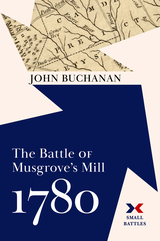 The Battle of Musgrove's Mill, 1780
John Buchanan
Westholme Publishing, 2022 On August 19, 1780, near a ford of the Enoree River in northwest South Carolina, a short and savage encounter occurred between Rebel militia and a combined force of Loyalist militia and Provincial regulars. Despite the Rebel’s being outnumbered more than two to one, it was an overwhelming victory for the American cause. The Rebels defended from the top of a ridge, inflicted heavy casualties on the Loyalist force as it advanced, then charged and drove the enemy from the field of battle. Just as Bunker Hill had done on a larger scale in Massachusetts, this clash of hundreds of soldiers in the Carolina backwoods invigorated the Rebel cause and led directly to the Battle of King's Mountain, the turning point of the war in the South. This battle is also remarkable because instead of one leader the Rebel force was directed by a joint command of three colonels.
The Battle of Musgrove’s Mill, 1780, by award-winning historian John Buchanan, begins by describing the situation in South Carolina following the British invasion of 1780 before introducing the three colonels: Isaac Shelby, James Williams, and Elijah Clarke. These men led Rebel militia from North Carolina, South Carolina, and Georgia in an effort to disrupt British operations and their Loyalist support. The colonels and other leaders led mounted Rebel militia in a sweeping and bloody guerilla war that played an essential role in opening a path to the eventual British surrender at Yorktown and Britain’s loss of America.
Small Battles: Military History as Local History
Mark Edward Lender and James Kirby Martin, Series Editors
Small Battles offers a fresh and important new perspective on the story of America’s early conflicts. It was the small battles, not the clash of major armies, that truly defined the fighting during the colonial wars, the American Revolution, the War of 1812, and the hostilities on the frontiers. This is dramatic military history as seen through the prism of local history—history with a depth of detail, a feeling for place, people, and the impact of battle and its consequences that the story of major battles often cannot convey. The Small Battles series focuses on America’s military conflicts at their most intimate and revealing level.
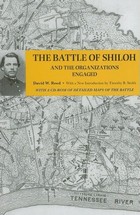 The Battle of Shiloh and the Organizations Engaged
D. W. Reed
University of Tennessee Press, 2008
Originally published in 1902 by the Government Printing Office (and revised and reprinted in 1909 and 1913), The Battle of Shiloh and the Organizations Engaged was the official park commission history of this important battle and remains a seminal work on the subject. Although the book is the cornerstone of Shiloh historiography and is extensively cited by serious historians, the original edition is not widely available today. Timothy B. Smith redresses this problem with this new reprint of the 1913 edition for which he has written an introduction that places the important work in historical context.
Written by D. W. Reed, a veteran of the battle and the first official historian of the Shiloh National Military Park, The Battle of Shiloh and the Organizations Engaged provides a succinct and authoritative overview of the battle. In addition to a narrative of the campaign, Reed describes the units engaged and the movements of every brigade. In addition, he includes numerous tables of strengths and losses for the armies as well as remarkably detailed maps and diagrams showing the action as it unfolded. These spectacular color maps are accessible in an enclosed CD in a PDF format. The net result is a compact yet detailed view of Shiloh unmatched anywhere else.
Even a century after its first publication, this book stands as one of the most dependable, concise, and important works on the Battle of Shiloh. This new edition makes this work accessible once again.
D. W. Reed was a veteran of the Battle of Shiloh and the first historian of the Shiloh National Military Park.
Timothy B. Smith is the author of This Great Battlefield of Shiloh: History, Memory, and the Establishment of a Civil War National Military Park and The Untold Story of Shiloh: The Battle and the Battlefield. He was a park ranger at the Shiloh National Military Park before accepting a teaching position at the University of Tennessee at Martin.
The Battle of the Bard: Shakespeare on US Radio in 1937
Michael P. Jensen
Arc Humanities Press, 2018 Difficult as it is to imagine today, in 1937 America’s two leading media companies fought over the right to perform Shakespeare for an American radio audience in an attempt to bring prestige to their networks. The resulting fourteen broadcasts are among the more remarkable recreations of Shakespeare of their time. This lively and engaging book shows the cultural dominance of radio in the 1930s, and tells the story of why the networks each wanted to lord Shakespeare’s prestige over the other, how they put their series together, the critical reception, and the cultural impact and legacies of the broadcasts.
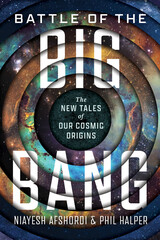 Battle of the Big Bang: The New Tales of Our Cosmic Origins
Niayesh Afshordi and Phil Halper
University of Chicago Press, 2025 “Excellent.”—Steven Poole, The Wall Street Journal • “Terrific.”—Liz Else, New Scientist (Best Popular Science Books of 2025) • “A brilliant overview of the state of modern cosmology.”—Alex O'Connor, alexoconnor.com • “This will expand readers’ minds.”—Publishers Weekly
“An intellectual feast.”—Carlo Rovelli • “A must-read.”—Sabine Hossenfelder • “Wonderfully broad and open-minded.”—Roger Penrose • “Remarkable.”—Brian Keating
A thrilling exploration of competing cosmological origin stories, comparing new scientific ideas that upend our very notions of space, time, and reality.
By most popular accounts, the universe started with a bang some 13.8 billion years ago. But what happened before the Big Bang? And how do we know it happened at all? Here prominent cosmologist Niayesh Afshordi and science communicator Phil Halper offer a tour of the peculiar possibilities: bouncing and cyclic universes, time loops, creations from nothing, multiverses, black hole births, string theories, and holograms. Along the way, they offer both a call for new physics and a riveting story of scientific debate.
Incorporating insights from Afshordi’s cutting-edge research and Halper’s original interviews with scientists like Stephen Hawking, Roger Penrose, and Alan Guth, Battle of the Big Bang compares these models for the origin of our origins, showing each theory’s strengths and weaknesses and explaining new attempts to test these notions. Battle of the Big Bang is a tale of rivalries and intrigue, of clashes of ideas that have raged from Greek antiquity to the present day over whether the universe is eternal or had a beginning, whether it is unique or one of many. But most of all, Afshordi and Halper show that this search is filled with wonder, discovery, and community—all essential for remembering a forgotten cosmic past.
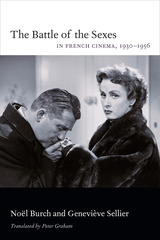 The Battle of the Sexes in French Cinema, 1930–1956
Noël Burch and Geneviève Sellier
Duke University Press, 2013 In The Battle of the Sexes in French Cinema, 1930–1956, Noël Burch and Geneviève Sellier adopt a sociocultural approach to films made in France before, during, and after World War II, paying particular attention to the Occupation years (1940–44). The authors contend that the films produced from the 1930s until 1956—when the state began to subsidize the movie industry, facilitating the emergence of an "auteur cinema"—are important, both as historical texts and as sources of entertainment. Citing more than 300 films and providing many in-depth interpretations, Burch and Sellier argue that films made in France between 1930 and 1956 created a national imaginary that equated masculinity with French identity. They track the changing representations of masculinity, explaining how the strong patriarch who saved fallen or troubled women from themselves in prewar films gave way to the impotent, unworthy, or incapable father figure of the Occupation. After the Liberation, the patriarch reemerged as protector and provider alongside assertive women who figured as threats not only to themselves but to society as a whole.
 The Battle of Upper Sandusky, 1782
Eric Sterner
Westholme Publishing, 2023 In May 1782, Colonel William Crawford led over 450 volunteers across Ohio to attack British-allied Native Americans who had been raiding the frontiers of Pennsylvania and Virginia for years. An experienced yet reluctant commander, Crawford and his men clashed with a similarly sized force of British Rangers and Wyandot, Delaware, and Shawnee Indians on the Sandusky River in early June. After three days, the Americans were routed in one of the worst defeats American arms suffered on the frontier during the American Revolution. During the retreat, Native American warriors captured dozens of men, including Colonel Crawford. Many were horrifically tortured to death in revenge for the Gnadenhutten massacre earlier that spring, when American volunteers bludgeoned nearly one hundred unarmed and unresisting Delaware Indians to death.
The Battle of Upper Sandusky, 1782 places military operations at the forefront of events in the waning months of the American Revolution on the frontier. Importantly, it gives long-deserved credit to Native American leaders, particularly Dunquat of the Wyandot and Hopocan of the Delaware, for their roles and commands on the battlefield. For over two centuries, their victory was attributed to the presence of British Rangers and a few officers, but Dunquat and Hopocan made the critical decisions before and after the battle while Native American warriors constituted the bulk of their army.
The book also reconsiders the effectiveness of American operations. Crawford was an unenthusiastic commander who had to be talked into leading the campaign to help prevent a repeat of the Gnadenhutten massacre. Despite his long service on the frontier and experience in the Continental Army, Crawford failed to unite his ad hoc command, suffered from constant indecision, and could not put his own stamp on the campaign. The unprofessional nature of his army also contributed to its defeat as it lacked organization, experience, leadership, training, and standardization.
The presence of Simon Girty, demonized by Americans on the frontier as a turncoat, and the gruesomeness of Crawford’s execution focused stories about the campaign on those two individuals, rather than the military operations themselves or the Indians who won the victory. Myths were accepted as fact. Afterward, interest in the campaign and the combatants faded. The Battle of Upper Sandusky, 1782 gives Crawford’s campaign its proper place as one of the largest battles between frontier forces and Native Americans during the Revolutionary War.
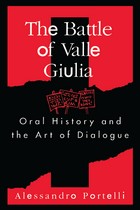 Battle of Valle Giulia: Oral History and the Art of Dialogue
Alessandro Portelli
University of Wisconsin Press, 1997 History, we are often taught, is driven by vast social, political, and economic forces. But each political event, each war, each clash in the streets or at the picket lines, is experienced by individuals. It is this profound bond between public history and personal struggle, Alessandro Portelli contends, that gives oral history its significance and its power.
In The Battle of Valle Giulia—the title comes from an Italian student protest of the 1960s—Portelli reflects on how to connect personal memories with history, how to fittingly collect and represent the complexity of memory. Crossing cultures, classes, and generations, he records the private and singular experiences of Italian steelworkers and Kentucky coal miners, veterans and refugees of World War II, soldiers who fought in Vietnam, Italian resistance fighters and Nazis, and members of student movements from Berkeley to Rome. By listening to those whom others presume are "without historical memory"—such as youthful protesters, or the rural Tuscan women who saw every father, son, and brother killed by Nazi soldiers—Portelli clarifies the process by which narratives come into being as oral history, and he illustrates the differences and distances between story-telling and history-telling.
Portelli's articulate discussion of dialogue, representation, narrative and genre link historical analysis with literary and linguistic theory and with the concerns of contemporary anthropology.
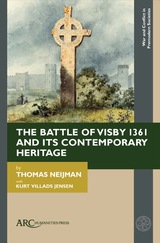 The Battle of Visby 1361 and Its Contemporary Heritage
Thomas Neijman
Arc Humanities Press, 2025 In summer of 1361, the Danish king conquered the island of Gotland, the centre of Baltic communication and trade. The invaders clashed with local forces outside the walls of Visby. The battle is well known from the excavated mass graves with human skeletons and large quantities of armour, which reveal the savage reality of the medieval battlefield. How was victory possible? Did Danish hyper-professional armies with mercenaries slaughter ill-equipped Gotlandic peasants, while German merchants were passive spectators from the walls of the main city, as historians have claimed? This book challenges traditional interpretations by investigating the human remains and equipment from their societal position, and puts the conquest of Gotland into a broader historical context of the medieval battle for dominium over the Baltic. It also discusses contemporary interpretations of the battle in museums, literature, media, and legends.
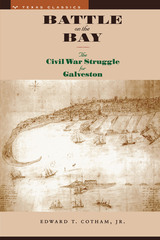 Battle on the Bay: The Civil War Struggle for Galveston
By Edward T. Cotham, Jr.
University of Texas Press, 1998 The Civil War history of Galveston is one of the last untold stories from America's bloodiest war, despite the fact that Galveston was a focal point of hostilities throughout the conflict. As other Southern ports fell to the Union, Galveston emerged as one of the Confederacy's only lifelines to the outside world. When the war ended in 1865, Galveston was the only major port still in Confederate hands. In this beautifully written narrative history, Ed Cotham draws upon years of archival and on-site research, as well as rare historical photographs, drawings, and maps, to chronicle the Civil War years in Galveston. His story encompasses all the military engagements that took place in the city and on Galveston Bay, including the dramatic Battle of Galveston, in which Confederate forces retook the city on New Year's Day, 1863. Cotham sets the events in Galveston within the overall conduct of the war, revealing how the city's loss was a great strategic impediment to the North. Through his pages pass major figures of the era, as well as ordinary soldiers, sailors, and citizens of Galveston, whose courage in the face of privation and danger adds an inspiring dimension to the story.
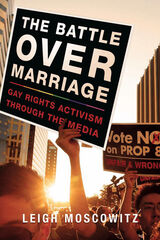 The Battle over Marriage: Gay Rights Activism through the Media
Leigh Moscowitz
University of Illinois Press, 2013 Over the past decade, the controversial issue of gay marriage has emerged as a primary battle in the culture wars and a definitive social issue of our time. The subject moved to the forefront of mainstream public debate in 2004, when San Francisco Mayor Gavin Newsom began authorizing same-sex marriage licenses, and it has remained in the forefront through three presidential campaigns and numerous state ballot initiatives. In this thorough analysis, Leigh Moscowitz examines how prominent news outlets presented this issue from 2003 to 2012, a time when intense news coverage focused unprecedented attention on gay and lesbian life. During this time, LGBT rights leaders sought to harness the power of media to advocate for marriage equality and to reform their community's public image. Building on in-depth interviews with activists and a comprehensive, longitudinal study of news stories, Moscowitz investigates these leaders' aims and how their frames, tactics, and messages evolved over time. In the end, media coverage of the gay marriage debate both aided and undermined the cause. Media exposure gave activists a platform to discuss gay and lesbian families. But it also triggered an upsurge in opposing responses and pressured activists to depict gay life in a way calculated to appeal to heterosexual audiences. Ultimately, The Battle over Marriage reveals both the promises and the limitations of commercial media as a route to social change.
 The Battle over Peleliu: Islander, Japanese, and American Memories of War
Stephen C. Murray
University of Alabama Press, 2016 An engrossing account of the military, cultural, and commercial impact of Japan and the USA on the island nation of Palau
The expansionist Japanese empire annexed the inhabited archipelago of Palau in 1914. The airbase built on Peleliu Island became a target for attack by the United States in World War II. The Battle over Peleliu: Islander, Japanese, and American Memories of War offers an ethnographic study of how Palau and Peleliu were transformed by warring great powers and further explores how their conflict is remembered differently by the three peoples who shared that experience.
Author Stephen C. Murray uses oral histories from Peleliu’s elders to reconstruct the island’s prewar way of life, offering a fascinating explanation of the role of land and place in island culture. To Palauans, history is conceived geographically, not chronologically. Land and landmarks are both the substance of history and the mnemonic triggers that recall the past. Murray then offers a detailed account of the 1944 US invasion against entrenched Japanese forces on Peleliu, a seventy-four-day campaign that razed villages, farms, ancestral cemeteries, beaches, and forests, and with them, many of the key nodes of memory and identity.
Murray also explores how Islanders’ memories of the battle as shattering their way of life differ radically from the ways Japanese and Americans remember the engagement in their histories, memoirs, fiction, monuments, and tours of Peleliu. Determination to retrieve the remains of 11,000 Japanese soldiers from the caves of Peleliu has driven high-profile civic groups from across the Japanese political spectrum to the island. Contemporary Japan continues to debate pacifist, right-wing apologist, and other interpretations of its aggression in Asia and the Pacific. These disputes are exported to Peleliu, and subtly frame how Japanese commemoration portrays the battle in stone and ritual. Americans, victors in the battle, return to the archipelago in far fewer numbers. For them, the conflict remains controversial but is most often submerged into the narrative of “the good war.”
The Battle over Peleliu is a study of public memory, and the ways three peoples swept up in conflict struggle to create a common understanding of the tragedy they share.
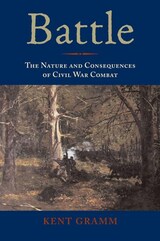 Battle: The Nature and Consequences of Civil War Combat
Edited by Kent Gramm
University of Alabama Press, 2008 A collection of essays that reveals the reality of war behind the pageantry of the American Civil War
“In our youth, our hearts were touched with fire,” wrote Oliver Wendell Holmes of his generation’s Civil War days. Through the ages, war stories have gleamed with romantic glory, and American memories of the cataclysmic Civil War inspire pageantry and poetry even today.
The essays in Battle form a corrective to such celebratory histories by examining the lethal realities of Civil War combat—Enlightenment science applied to the creation of weapons that maimed and killed, which far outpaced advances in diet, sanitation, and medical treatment. The book reveals that behind the drums and trumpets, sashes and swords, the armies of the Union and Confederacy alike were haunted by fear, pain, and death.
The collection includes an introduction and afterword by editor Kent Gramm, who also contributes an essay titled “Numbers” that reveals the war in statistics. Paul Fussell contributes a powerful essay titled “The Culture of War.” D. Scott Hartwig examines the face of battle at Gettysburg. Bruce A. Evans discusses medical technology in “Wounds, Death, and Medical Care in the Civil War.” Eric T. Dean challenges the meanings and consequences of combat in “The Awful Shock and Rage of Battle.” The collection is rounded out by Alan T. Nolan’s masterful review of the national consequences of battle and the resultant myth of the Confederacy’s Lost Cause.
The Battle to Stay in America: Immigration's Hidden Front Line
Michael Kagan
University of Nevada Press, 2025 2020 Foreword INDIE awards winner
The Battle to Stay in America is the story of a community coming to grips with the federal government’s crackdown on immigrants, and learning how to defend itself. Informative and personal, this is a story about mothers and fathers, lawyers and activists, local police and federal agencies, and a struggle for the identity of a nation. This is the quintessential story of the war on immigrants, as fought and felt on the front lines in the heart of America.
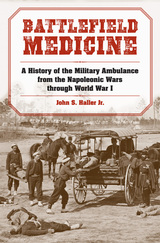 Battlefield Medicine: A History of the Military Ambulance from the Napoleonic Wars through World War I
John S. Haller, Jr.
Southern Illinois University Press, 1992 In this first history of the military ambulance, historian John S. Haller Jr. documents the development of medical technologies for treating and transporting wounded soldiers on the battlefield. Noting that the word ambulance has been used to refer to both a mobile medical support system and a mode of transport, Haller takes readers back to the origins of the modern ambulance, covering their evolution in depth from the late eighteenth century through World War I.
The rising nationalism, economic and imperial competition, and military alliances and arms races of the nineteenth and early twentieth centuries figure prominently in this history of the military ambulance, which focuses mainly on British and American technological advancements. Beginning with changes introduced by Dominique-Jean Larrey during the Napoleonic Wars, the book traces the organizational and technological challenges faced by opposing armies in the Crimean War, the American Civil War, the Franco-Prussian War, and the Philippines Insurrection, then climaxes with the trench warfare that defined World War I. The operative word is "challenges" of medical care and evacuation because while some things learned in a conflict are carried into the next, too often, the spasms of war force its participants to repeat the errors of the past before acquiring much needed insight.
More than a history of medical evacuation systems and vehicles, this exhaustively researched and richly illustrated volume tells a fascinating story, giving readers a unique perspective of the changing nature of warfare in the nineteenth and early twentieth centuries.
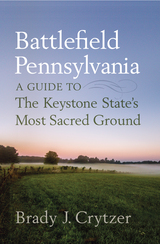 Battlefield Pennsylvania: A Guide to the Keystone State's Most Sacred Ground
Brady J. Crytzer
Westholme Publishing, 2018 A History of Pennsylvania through Places of Conflict, from George Washington’s Fort Necessity to the Flight 93 Memorial
Pennsylvania is a battlefield. Fort Necessity. Brandywine. Gettysburg. The Homestead Strike. Flight 93. In many ways battlefields are like scars on the landscape. They remind us that history is real, and their effects stay with us forever. In Battlefield Pennsylvania: A Guide to the Keystone State’s Most Sacred Ground, award-winning historian Brady J. Crytzer takes the reader on a fascinating tour of over three hundred years of Pennsylvania history through twenty-nine of the state’s most significant battlegrounds, based on his popular Pennsylvania Cable Network television program. The author shows that debates and neighborly disputes have been present throughout the history of William Penn’s “Peaceable Kingdom,” but that battles are not the natural resolution of these conflicts; they are a failure of the system. Understanding how these systems break down and descend into violence and chaos is one of the most important purposes of this book. When the forces of Britain and France met on the battleground of North America, they each waged war in the name of a vision—a defense of the future, not merely the present. The same can be said for the Indian warriors and settlers of the backcountry, and the striking workers of the industrial age. When the young men of the American Civil War era donned the Butternut and Blue, they were not just fighting over a hill or a railroad junction, but for an American future. Illustrated with maps and period and contemporary images, Battlefield Pennsylvania presents each event through background information, a description of the battle itself, the legacy of the battle, and what a visitor can see today. Rather than viewing preserved battlefields as a hollow tribute to days gone by, the author demonstrates that these sites are a great inheritance provided by past generations, and just as they entrusted them to us, we will entrust them to future generations as well.
Battlefields of Negotiation: Control, Agency, and Ownership in World of Warcraft
René Glas
Amsterdam University Press, 2013 The massively multiplayer online role-playing game World of Warcraft has become one of the most popular computer games of the past decade, introducing millions around the world to community-based play. Within the boundaries set by its design, the game encourages players to appropriate and shape the game to their own wishes, resulting in highly diverse forms of play and participation. This illuminating study frames World of Warcraft as a complex socio-cultural phenomenon defined by and evolving as a result of the negotiations between groups of players as well as the game’s owners, throwing new light on complex consumer-producer relationships in the increasingly participatory but still tightly controlled media of online games.
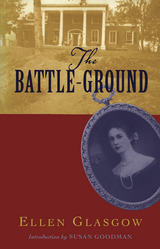 The Battle-Ground
Ellen Glasgow
University of Alabama Press, 2000 Captures the war's human toll and explores its social consequences
The Battle-Ground, Ellen Glasgow's fourth novel, was her first bestseller, with more than 21,000 copies sold in just two weeks. The novel committed her to a project almost unparalleled in American literary history: a novelistic meditation on the South from the decade before the Confederacy to the middle of the 20th century. The Battle-Ground speaks of a South before and during the Civil War in its struggles to become part of a nation still in the making. The overthrow of the aristocratic tradition, the transfer of hereditary power to a rural underclass, the continued disenfranchisement of African Americans, and the evolving status of women--these topics, which came to bind the more than a dozen volumes of Glasgow's self-styled "social history," initially coalesced in The Battle-Ground. The Battle-Ground conspicuously departs from the tradition of Southern romances popularized by Thomas Nelson Page, and contemporary reviewers praised the book for its historical accuracy. Glasgow, an ardent Anglophile, bragged that military officers in Great Britain studied its descriptions of battle. With her, realism had not only crossed the Atlantic, it had "crossed the Potomac." But Glasgow never sensationalizes the Civil War, whose bloodiest scenes she flanks with domestic officers, the sharing of rations, the warmth of camp, and reminders of home. Her vision of the war centers less on its corruption or barbarity than on its occasions for small decencies and their power of humanization. Glasgow cannot separate the war from its greater social implications--it is a place, as her title suggests, that tests the soul of a nation as well as individual men and women. The importance of The Battle-Ground in Southern literary history cannot be overemphasized, for Glasgow's reimagining of the Civil War had a profound impact on the next generation of Southern writers, including Allen Tate, Stark Young, and Margaret Mitchell.
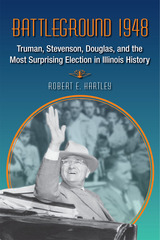 Battleground 1948: Truman, Stevenson, Douglas, and the Most Surprising Election in Illinois History
Robert E. Hartley
Southern Illinois University Press, 2013 The election year of 1948 remains to this day one of the most astonishing in U.S. political history. During this first general election after World War II, Americans looked to their governments for change. As the battle for the nation’s highest office came to a head in Illinois, the state was embroiled in its own partisan showdowns—elections that would prove critical in the course of state and national history. In Battleground 1948, Robert E. Hartley offers the first comprehensive chronicle of this historic election year and its consequences, which still resonate today. Focusing on the races that ushered Adlai Stevenson, Paul Douglas, and Harry Truman into office—the last by the slimmest of margins—Battleground 1948 details the pivotal events that played out in the state of Illinois, from the newspaper wars in Chicago to tragedy in the mine at Centralia. In addition to in-depth revelations on the saga of the American election machine in 1948, Hartley probes the dark underbelly of Illinois politics in the 1930s and 1940s to set the stage, spotlight key party players, and expose the behind-the-scenes influences of media, money, corruption, and crime. In doing so, he draws powerful parallels between the politics of the past and those of the present. Above all, Battleground 1948 tells the story of grassroots change writ large on the American political landscape—change that helped a nation move past an era of conflict and depression, and forever transformed Illinois and the U.S. government.
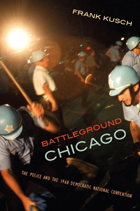 Battleground Chicago: The Police and the 1968 Democratic National Convention
Frank Kusch
University of Chicago Press, 2008 The 1968 Democratic Convention, best known for police brutality against demonstrators, has been relegated to a dark place in American historical memory. Battleground Chicago ventures beyond the stereotypical image of rioting protestors and violent cops to reevaluate exactly how—and why—the police attacked antiwar activists at the convention.
Working from interviews with eighty former Chicago police officers who were on the scene, Frank Kusch uncovers the other side of the story of ’68, deepening our understanding of a turbulent decade.
“Frank Kusch’s compelling account of the clash between Mayor Richard Daley’s men in blue and anti-war rebels reveals why the 1960s was such a painful era for many Americans. . . . to his great credit, [Kusch] allows ‘the pigs’ to speak up for themselves.”—Michael Kazin
“Kusch’s history of white Chicago policemen and the 1968 Democratic National Convention is a solid addition to a growing literature on the cultural sensibility and political perspective of the conservative white working class in the last third of the twentieth century.”—David Farber, Journal of American History
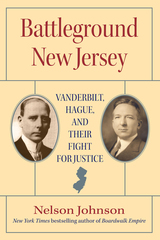 Battleground New Jersey: Vanderbilt, Hague, and Their Fight for Justice
Johnson, Nelson
Rutgers University Press, 2014 New Jersey’s legal system was plagued with injustices from the time the system was established through the mid-twentieth century. In Battleground New Jersey, historian and author of Boardwalk Empire, Nelson Johnson chronicles reforms to the system through the dramatic stories of Arthur T. Vanderbilt—the first chief justice of the state’s modern-era Supreme Court—and Frank Hague—legendary mayor of Jersey City. Two of the most powerful politicians in twentieth-century America, Vanderbilt and Hague clashed on matters of public policy and over the need to reform New Jersey’s antiquated and corrupt court system. Their battles made headlines and eventually led to legal reform, transforming New Jersey’s court system into one of the most highly regarded in America. Vanderbilt’s power came through mastering the law, serving as dean of New York University Law School, preaching court reform as president of the American Bar Association, and organizing suburban voters before other politicians recognized their importance. Hague, a remarkably successful sixth-grade dropout, amassed his power by exploiting people’s foibles, crushing his rivals, accumulating a fortune through extortion, subverting the law, and taking care of business in his own backyard. They were different ethnically, culturally, and temperamentally, but they shared the goals of power.
Relying upon previously unexamined personal files of Vanderbilt, Johnson’s engaging chronicle reveals the hatred the lawyer had for the mayor and the lengths Vanderbilt went to in an effort to destroy Hague. Battleground New Jersey illustrates the difficulty in adapting government to a changing world, and the vital role of independent courts in American society.
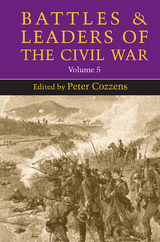 Battles and Leaders of the Civil War, Volume 5
Edited by Peter Cozzens
University of Illinois Press, 2001 Indispensable must-reads for all Civil War buffs and historians, bringing together little-known and never before gathered first-hand accounts, articles, maps, and illustrations
The first four volumes of Battles and Leaders of the Civil War, published in the late nineteenth century, became the best-selling and most frequently cited works ever published on the Civil War. Volume 5, assembled by the acclaimed military historian Peter Cozzens, carries on the tradition of its namesake, offering a dazzling new collection of fresh material written by military and civilian leaders, North and South, on a broad array of war-related topics. Featured articles include General Grant on the second battle of Bull Run, General Beauregard on the Shiloh campaign, General Sherman on the conference at City Point, Joshua Chamberlain on the Fredericksburg campaign, and many more. Also presented are dozens of maps and more than one hundred illustrations.
Battles and Leaders of the Civil War, Volume 6
Edited by Peter Cozzens
University of Illinois Press, 2001 Sifting carefully through reports from newspapers, magazines, personal memoirs, and letters, Peter Cozzens' Volume 6 brings readers more of the best first-person accounts of marches, encampments, skirmishes, and full-blown battles, as seen by participants on both sides of the conflict. Alongside the experiences of lower-ranking officers and enlisted men are accounts from key personalities including General John Gibbon, General John C. Lee, and seven prominent generals from both sides offering views on "why the Confederacy failed." This volume includes one hundred and twenty illustrations, including sixteen previously uncollected maps of battlefields, troop movements, and fortifications.
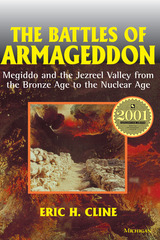 The Battles of Armageddon: Megiddo and the Jezreel Valley from the Bronze Age to the Nuclear Age
Eric H. Cline
University of Michigan Press, 2002 WINNER
> Best Popular Book on Archaeology
--Biblical Archaeology Society
Apocalypse. Judgment Day. The End Time. Armageddon. Students of the Bible know it as the place where the cataclysmic battle between the forces of good and the forces of evil will unfold. Many believe that this battle will take place in the very near future. But few know that Armageddon is a real place--one that has seen more fighting and bloodshed than any other spot on earth.
The name Armageddon is a corruption of the Hebrew phrase Har Megiddo, and it means "Mount of Megiddo." More than thirty bloody conflicts have been fought at the ancient site of Megiddo and adjacent areas of the Jezreel Valley during the past four thousand years. Egyptians, Israelites, Greeks, Muslims, Crusaders, Mongols, British, Germans, Arabs, and Israelis have all fought and died here. The names of the warring leaders reverberate throughout history: Thutmose III, Deborah, Gideon, Saul and Jonathan, Jezebel, Saladin, Napoleon, and Allenby, to name but the most famous. Throughout history Megiddo and the Jezreel Valley have been ground zero for battles that determined the very course of civilization. No wonder that the author of Revelation believed Armageddon, the penultimate battle between good and evil, would also take place here!
The Battles of Armageddon introduces readers to a rich cast of ancient and modern warriors, while bringing together for the first time the wide range of conflicts that have been fought at Megiddo and the Jezreel Valley from the Bronze Age to the Nuclear Age.
Eric H. Cline has participated in more than seventeen seasons of excavation and survey in Israel, Egypt, Jordan, Greece, and the United States. He is currently a Senior Staff Archaeologist at the ongoing excavations of Megiddo.
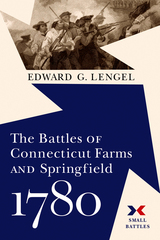 The Battles of Connecticut Farms and Springfield, 1780
Edward G. Lengel
Westholme Publishing, 2020 Featured in Ken Burns The American Revolution on PBS®
By the spring of 1780, American fortunes were at a low point. Charleston, South Carolina, fell to British forces on May 12. At Morristown, New Jersey, George Washington’s army struggled to recover from the worst winter of the entire war. The national economy failing, his troops short of supplies and on the verge of mutiny, Washington prepared for an all-out assault on British-occupied New York City with the support of approaching French naval and land forces under General Rochambeau. The planned attack was a gamble born of desperation. Washington felt he had to risk it, or face certain defeat. In New York City, German General Wilhelm von Knyphausen sensed opportunity. Commanding there in the absence of British General Henry Clinton, who was on his way back from Charleston, Knyphausen hoped that a quick strike into New Jersey could deliver a staggering blow to Washington’s weakened army. The June 7–8 Battle of Connecticut Farms, however, found American militia and Continentals—mostly soldiers of General William Maxwell’s New Jersey Brigade—to be shockingly stalwart. In a series of sharp engagements, fought hard on both sides, the Americans convinced Knyphausen to turn back. Clinton, fresh from his victory in the South, tried again on June 23 to end the war. His advance into New Jersey, intended to draw Washington into the open and perhaps capture Morristown, culminated in the Battle of Springfield. Once again, though, Washington’s hardened soldiers, led by men like Colonel Israel Angell, Colonel Elias Dayton, and Major “Light Horse Harry” Lee, fought Clinton’s forces to a standstill.
The Battles for Connecticut Farms and Springfield, 1780, by distinguished historian Edward G. Lengel, chronicles these two important battles that marked a turning of the tide in the Revolutionary War. Drawing on newly available primary sources, the author presents a fresh and engaging interpretation of these events, which exposed King George III’s declining military fortunes in North America even as they revealed the resilience of George Washington’s army.
The Small Battles Series: Military History as Local History
Mark Edward Lender and James Kirby Martin, Series Editors
Small Battles offers a fresh and important new perspective on the story of America’s early conflicts. It was the small battles, not the clash of major armies, that truly defined the fighting during the colonial wars, the American Revolution, the War of 1812, and the hostilities on the frontiers. This is dramatic military history as seen through the prism of local history—history with a depth of detail, a feeling for place, people, and the impact of battle and its consequences that the story of major battles often cannot convey. The Small Battles Series focuses on America’s military conflicts at their most intimate and revealing level.
 The Battles of Fort Watson and Fort Motte, 1781
Steven D. Smith
Westholme Publishing, 2024 On May 9, 1781, American general Nathanael Greene and his Continental army were outside of British-held Camden, South Carolina. Greene was despondent and contemplating resigning his commission, believing he could not force the British out of the fortified village. His compatriot Francis Marion, standing before Fort Motte forty miles to the south, was also in the same mood, informing Greene that he was frustrated by the militia, and he was going to resign after the fort’s capture. The next day, Lord Francis Rawdon, commander of the Camden garrison and all British field forces in South Carolina, abandoned that backcountry village. Marion would capture Fort Motte two days later. In The Battles of Fort Watson and Fort Motte, 1781, the latest in the Small Battles Series, historian and archaeologist Steven D. Smith relates the history of four critical weeks from April 12 until May 12, 1781, in which the tide of the Southern Campaign of the Revolutionary War turned in favor of the Americans. The book focuses on General Francis Marion’s and Colonel Henry Lee’s capture of two key British forts, Fort Watson and Fort Motte, coordinating with Nathanael Greene in retaking the South Carolina backcountry. These posts defended the supply line between Charleston and the British-occupied villages of Camden and Ninety Six. Although there would be much more fighting to do, once the two forts were lost, the British had to abandon the backcountry or starve. The British would never again be on the strategic offensive and were confined to the Charleston environs until they abandoned the city in December 1782. The story of the capture of the forts is enhanced and enlightened by the findings of archaeological investigation at each site—and even mythology, such as Mrs. Motte providing the fire arrows used to burn her fortified house—which are seamlessly integrated into the account, providing a unique perspective on these important events during the Southern Campaign.
 The Battles of Germantown: Effective Public History in America
David W. Young
Temple University Press, 2019 2020 Philip S. Klein Book Prize Winner, Pennsylvania Historical Association
Known as America’s most historic neighborhood, the Germantown section of Philadelphia (established in 1683) has distinguished itself by using public history initiatives to forge community. Progressive programs about ethnic history, postwar urban planning, and civil rights have helped make historic preservation and public history meaningful. The Battles of Germantown considers what these efforts can tell us about public history’s practice and purpose in the United States. Author David Young, a neighborhood resident who worked at Germantown historic sites for decades, uses his practitioner’s perspective to give examples of what he calls “effective public history.” The Battles of Germantown shows how the region celebrated “Negro Achievement Week” in 1928 and, for example, how social history research proved that the neighborhood’s Johnson House was a station on the Underground Railroad. These encounters have useful implications for addressing questions of race, history, and memory, as well as issues of urban planning and economic revitalization. Germantown’s historic sites use public history and provide leadership to motivate residents in an area challenged by job loss, population change, and institutional inertia. The Battles of Germantown illustrates how understanding and engaging with the past can benefit communities today.
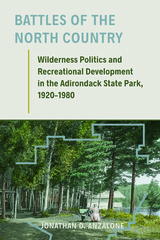 Battles of the North Country: Wilderness Politics and Recreational Development in the Adirondack State Park, 1920-1980
Jonathan D. Anzalone
University of Massachusetts Press, 2018 The Adirondack region is trapped in a cycle of conflict. Nature lovers advocate for the preservation of wilderness, while sports enthusiasts demand infrastructure for recreation. Local residents seek economic opportunities, while environmentalists fight industrial or real estate growth. These clashes have played out over the course of the twentieth century and continue into the twenty-first.
Through a series of case studies, historian Jonathan D. Anzalone highlights the role of public and private interests in the region and shows how partnerships frayed and realigned in the course of several key developments: the rise of camping in the 1920s and 1930s; the 1932 Lake Placid Olympics; the construction of a highway to the top of Whiteface Mountain; the postwar rise of downhill skiing; the completion of I-87 and the resulting demand for second homes; and the 1980 Lake Placid Olympics. Battles of the North Country reveals how class, economic self-interest, state power, and a wide range of environmental concerns have shaped modern politics in the Adirondacks and beyond.
 Battling Bella: The Protest Politics of Bella Abzug
Leandra Ruth Zarnow
Harvard University Press, 2019 Bella Abzug’s promotion of women’s and gay rights, universal childcare, green energy, and more provoked not only fierce opposition from Republicans but a split within her own party. The story of this notorious, galvanizing force in the Democrats’ “New Politics” insurgency is a biography for our times.
Before Alexandria Ocasio-Cortez, Elizabeth Warren, or Hillary Clinton, there was New York’s Bella Abzug. With a fiery rhetorical style forged in the 1960s antiwar movement, Abzug vigorously promoted gender parity, economic justice, and the need to “bring Congress back to the people.”
The 1970 congressional election season saw Abzug, in her trademark broad-brimmed hats, campaigning on the slogan “This Woman’s Place Is in the House—the House of Representatives.” Having won her seat, she advanced the feminist agenda in ways big and small, from gaining full access for congresswomen to the House swimming pool to cofounding the National Women’s Political Caucus to putting the title “Ms.” into the political lexicon. Beyond women’s rights, “Sister Bella” promoted gay rights, privacy rights, and human rights, and pushed legislation relating to urban, environmental, and foreign affairs.
Her stint in Congress lasted just six years—it ended when she decided to seek the Democrats’ 1976 New York Senate nomination, a race she lost to Daniel Patrick Moynihan by less than 1 percent. Their primary contest, while gendered, was also an ideological struggle for the heart of the Democratic Party. Abzug’s protest politics had helped for a time to shift the center of politics to the left, but her progressive positions also fueled a backlash from conservatives who thought change was going too far.
This deeply researched political biography highlights how, as 1960s radicalism moved protest into electoral politics, Abzug drew fire from establishment politicians across the political spectrum—but also inspired a generation of women.
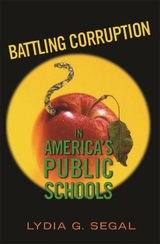 Battling Corruption in America’s Public Schools
Lydia G. Segal
Harvard University Press “In the early 1990s, after getting a law degree from Harvard, Segal worked for the Manhattan district attorney. She led dozens of investigations in the aftermath of accusations that school jobs in New York City were being sold for sex and cash…Segal thinks the cause of rampant corruption is not bad people but a lousy system that overcentralizes decision-making.”—Forbes
“Anyone who is interested in school reform—this means anyone who pays taxes, is a parent or guardian of a child attending school, and/or who works toward a goal of establishing an education system that puts children first—must read this book.”—ParentAdvocates.org
“Segal proposes a number of sensible reforms: creating an independent Inspector General’s office in all big-city school districts, privatizing custodial and repair services, decentralizing various purchasing decisions.”—Wall Street Journal
Drawing on ten years of undercover work and research in four major school districts, Lydia Segal reveals how systemic waste and fraud siphon millions of dollars from urban classrooms. Segal shows how money is lost in systems that focus on process rather than on results, and how regulations established to curb waste and fraud provide perverse incentives for new forms of both. Calling for renewed powers for principals and a streamlining of oversight, Segal offers a bold, far-reaching plan to reclaim our schools.
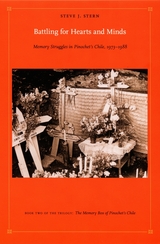 Battling for Hearts and Minds: Memory Struggles in Pinochet’s Chile, 1973–1988
Steve J. Stern
Duke University Press, 2006 Battling for Hearts and Minds is the story of the dramatic struggle to define collective memory in Chile during the violent, repressive dictatorship of General Augusto Pinochet, from the 1973 military coup in which he seized power through his defeat in a 1988 plebiscite. Steve J. Stern provides a riveting narration of Chile’s political history during this period. At the same time, he analyzes Chileans’ conflicting interpretations of events as they unfolded. Drawing on testimonios, archives, Truth Commission documents, radio addresses, memoirs, and written and oral histories, Stern identifies four distinct perspectives on life and events under the dictatorship. He describes how some Chileans viewed the regime as salvation from ruin by Leftists (the narrative favored by Pinochet’s junta), some as a wound repeatedly reopened by the state, others as an experience of persecution and awakening, and still others as a closed book, a past to be buried and forgotten. In the 1970s, Chilean dissidents were lonely “voices in the wilderness” insisting that state terror and its victims be recognized and remembered. By the 1980s, the dissent had spread, catalyzing a mass movement of individuals who revived public dialogue by taking to the streets, creating alternative media, and demanding democracy and human rights. Despite long odds and discouraging defeats, people of conscience—victims of the dictatorship, priests, youth, women, workers, and others—overcame fear and succeeded in creating truthful public memories of state atrocities. Recounting both their efforts and those of the regime’s supporters to win the battle for Chileans’ hearts and minds, Stern shows how profoundly the struggle to create memories, to tell history, matters. Battling for Hearts and Minds is the second volume in the trilogy The Memory Box of Pinochet’s Chile. The third book will examine Chileans’ efforts to achieve democracy while reckoning with Pinochet’s legacy.
 Battling over the Balkans: Historiographical Questions and Controversies
John R. Lampe
Central European University Press, 2020 The tumultuous history of the Balkans has been subject to a plethora of conflicting interpretations, both local and external. In an attempt to help overcome the stereotypes that still pervade Balkan history, Battling over the Balkans concentrates on a set of five principal controversies from the precommunist period with which the region’s history and historiography must contend: the pre-1914 Ottoman and Eastern Christian Orthodox legacies; the post-1918 struggles for state-building; the range of European economic and cultural influences across the interwar period, as opposed to diplomatic or political intervention; the role of violence and paramilitary forces in challenging the interwar political regimes in the region; and the fate of ethnic minorities into and after World War II, particularly Jews, Muslims and Roma. In an attempt to give a voice to eminent local authors, the chapters provide samples of new regional scholarship exploring these contested issues—most of them translated into English for the first time—and are prefaced with historiographical overviews addressing the state of the debate on these specific controversies. These translations help bridge the language barriers that often separate scholarly traditions within Southeast Europe, as well as scholars in Southeast Europe and English-speaking academia. This volume will enable readers to identify common patterns and influences that characterize the writing of history in the region, and will stimulate new transnational and comparative approaches to the history of the Balkans.
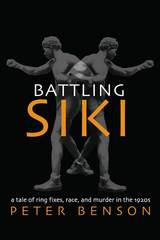 Battling Siki: A Tale of Ring Fixes, Race, and Murder in the 1920s
Peter Benson
University of Arkansas Press, 2008 Battling Siki (1887–1925) was once one of the four or five most recognizable black men in the world, and was written about in detail by such figures as Ring Lardner and his son John, Damon Runyon, and Westbrook Pegler. One can find his legacy in the name of a popular rock group, one of Che Guevara’s lieutenants, a character on Xena, Warrior Princess, and the Battling Siki Hotel in the fighter’s homeland, Senegal. Peter Benson’s biography of the first African to win a world championshipin boxing delves into the complex world of sports, race, colonialism, and the cult of personality in the early twentieth century. Born Amadu Fall, Siki was taken from Senegal to France by an actress and assumed the name Louis M’barick Fall. After an inauspicious beginning as a boxer, he served in World War I with distinction then returned to boxing and compiled a most impressive record (forty-three wins in forty-six bouts). Then, on September 24, 1922, at Paris’s Buffalo Velodrome, before forty thousand stunned spectators (including a young Ernest Hemingway, who wrote about the fight), Battling Siki, employing his trademark “windmill” punch, fought and defeated the reigning world and European light heavyweight champion, Georges Carpentier. The colorful Siki spent a fortune partying and carousing, was arrested for firing a pistol in the air, and was frequently seen on the streets of Paris, dressed in flashy clothes, walking his pet lion cubs on a leash. But he also provoked a scandal by exposing the corruption of the fight game in France, spoke out boldly against racisim, and was arrected for deliberately defying the code of racial segregation in the American South. Siki’s flamboyant image was largely created by newsmen. In fact, the real Siki, while he did certainly like to party, was also an intelligent and socially conscious person, who detested the media’s image of him as a simple-minded drunken savage. Offers rushed in for him to fight in the United States, maybe even against Jack Dempsey. But in a move many have called one of the strangest a fighter ever made, he fought Irishman Mike McTigue in Dublin on St. Patrick’s Day—and lost. After losing his European title he came to the United States and fought without much success. He continued to drink and get into street brawls. On the evening of December 15, 1925, at the age of twenty-eight, he was shot and killed in Hell’s Kitchen in what some claimed was a gangland execution. Peter Benson’s biography beautifully captures Battling Siki’s amazing boxing career and sheds new light on the scandal surrounding his marriages and public behavior, his alleged participation in ring fixes, and the mystery surrounding his death.
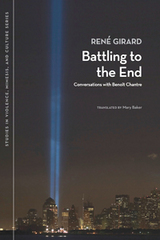 Battling to the End: Conversations with Benoit Chantre
René Girard
Michigan State University Press, 2010 Carl von Clausewitz (1780–1831), the Prussian military theoretician who wrote On War, is known above all for his famous dictum: “War is the continuation of politics by other means.” In René Girard’s view, however, the strategist’s treatise offers up a more disturbing truth to the reader willing to extrapolate from its most daring observations: with modern warfare comes the insanity of tit-for-tat escalation, which political institutions have lost their ability to contain. Having witnessed the Napoleonic Wars firsthand, Girard argues, Clausewitz intuited that unbridled “reciprocal action” could eventually lead foes to total mutual annihilation. Haunted by the Franco-German conflict that was to ravage Europe, in Girard’s account Clausewitz is a prescient witness to the terrifying acceleration of history. Battling to the End issues a warning about the apocalyptic threats hanging over our planet and delivers an authoritative lesson on the mimetic laws of violence.
 Baudelaire and the Poetics of Modernity
Patricia A. Ward
Vanderbilt University Press, 2000 Charles Baudelaire, possibly the most influential author of nineteenth-century France, created a poetics of modernity and a thematics of the city; he transcended genre by moving between poetry and prose. He is also the most accessible of modern French poets to an American readership. These essays examine Baudelaire's poetics and the complex relationship between the poet and his twentieth-century literary heirs, including Rene Char, Yves Bonnefoy, and Michel Deguy. The contributors, who include Deguy and Bonnefoy, are all distinguished writers or critics noted for their own poetry or for their scholarship on Baudelaire and in French studies. Their essays go to the heart of what makes Baudelaire so important: his modernity and his influence from the very beginning on other poets, including those outside of France. The essays are written in English, with citations from Baudelaire and other sources in both French and English.
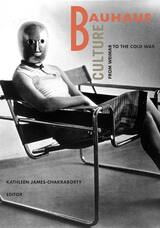 Bauhaus Culture: From Weimar To The Cold War
Kathleen James-Chakraborty
University of Minnesota Press, 2006 Offering the first comprehensive training in the visual arts grounded in abstraction, the Bauhaus was the site of a dazzling range of influential experiments in painting, architecture, photography, industrial design, and even artistic education itself. Three-quarters of a century later, the “look” of the new remains indebted to the Bauhaus and its equation of technology with modernism. Central to discussions of the relationships between art, industrialization, and politics in the twentieth century, much of the school’s later impact was derived in part from its status as one of the foremost cultural symbols of Germany’s first democracy and its public reputation as a “cathedral of socialism.”
In this book, editor Kathleen James-Chakraborty and seven other scholars analyze the accomplishments and dispel the myths of the Bauhaus, placing it firmly in a historical context from before the formation of the Weimar Republic through Nazi ascendancy and World War II into the cold war. Together, they investigate its professors’ and students’ interactions with mass culture; establish the complexity of its relationship with Wilhelmine, Nazi, and postwar German politics; and challenge the claim that its architects greatly influenced American architecture in the 1930s.
Their most explosive conclusions address the degree to which some aspects of Bauhaus design continued to flourish during the Third Reich before becoming one of the cold war’s most enduring emblems of artistic freedom. In doing so, Bauhaus Culture calls into question the degree to which this influential school should continue to symbolize an uncomplicated relationship between art, modern technology, and progressive politics.
Contributors: Greg Castillo, Juliet Koss, Rose-Carol Washton Long, John V. Maciuika, Wallis Miller, Winifried Nerdinger, Frederic J. Schwartz.
Kathleen James-Chakraborty is associate professor of architecture at the University of California, Berkeley, and author of German Architecture for a Mass Audience and Erich Mendelsohn and the Architecture of German Modernism.
 The Bauhaus Idea and Bauhaus Politics
Éva Forgács
Central European University Press, 1995 Forgacs examines the development of the Bauhaus school of architecture and applied design by focusing on the idea of the Bauhaus, rather than on its artefacts. What gave this idea its extraordinary powers of survival? Founded in 1919, with the architect Walter Gropius as its first director, the Bauhaus carried within it the seeds of conflict from the start. The duration of the Bauhaus coincides very nearly with that of the Weimar Republic; the Bauhaus idea - the notion that the artist should be involved in the technological innovations of mechanization and mass production - is a concept that was bound to arouse the most passionate feelings. It is these two strands - personal and political - that Forgacs so cleverly interweaves. The text has been extensively revised since its original publication in Hungarian, and an entirely new chapter has been added on the Bauhaus's Russian analogue, VkhUTEMAS, the Moscow academy of industrial art.
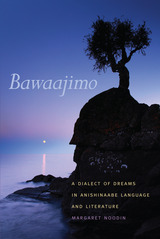 Bawaajimo: A Dialect of Dreams in Anishinaabe Language and Literature
Margaret Noodin
Michigan State University Press, 2014 Bawaajimo: A Dialect of Dreams in Anishinaabe Language and Literature combines literary criticism, sociolinguistics, native studies, and poetics to introduce an Anishinaabe way of reading. Although nationally specific, the book speaks to a broad audience by demonstrating an indigenous literary methodology. Investigating the language itself, its place of origin, its sound and structure, and its current usage provides new critical connections between North American fiction, Native American literatures, and Anishinaabe narrative. The four Anishinaabe authors discussed in the book, Louise Erdrich, Jim Northrup, Basil Johnston, and Gerald Vizenor, share an ethnic heritage but are connected more clearly by a culture of tales, songs, and beliefs. Each of them has heard, studied, and written in Anishinaabemowin, making their heritage language a part of the backdrop and sometimes the medium, of their work. All of them reference the power and influence of the Great Lakes region and the Anishinaabeakiing, and they connect the landscape to the original language. As they reconstruct and deconstruct the aadizookaan, the traditional tales of Nanabozho and other mythic figures, they grapple with the legacy of cultural genocide and write toward a future that places ancient beliefs in the center of the cultural horizon.
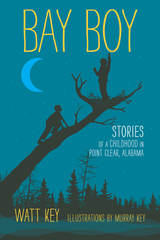 Bay Boy: Stories of a Childhood in Point Clear, Alabama
Watt Key, Illustrations by Murray Key
University of Alabama Press, 2019 A charming, humorous, and colorful coming-of-age memoir
Bay Boy is a collection of essays by award-winning young adult author Watt Key, chronicling his boyhood in Point Clear, Alabama. During his childhood, Point Clear was not the tony enclave of today with its spas, art galleries, and multimillion dollar waterfront properties. Rather, it was a sleepy resort community, practically deserted in the winter, with a considerable population of working-class residents.
As Key notes in his introduction, “Life in Point Clear is really about being outside. . . . I have never found a place so perfectly suited to exercise a young boy’s imagination.” Key and his brother filled their days collecting driftwood to make forts, scooting around the bay in a sturdy Stauter boat, and making art and writing stories when it rained.
In a tone that is simple and direct, punctuated by truly hilarious moments. Key writes about Gulf Coast traditions including Mardi Gras, shrimping, fishing, dove hunting, jubilees, camping out, and bracing for hurricanes. These stories are full of colorful characters— Nasty Bill Dickson, a curmudgeonly tow-truck driver; I’llNeeda, a middle-aged homeless woman encamped in a shack across the road; and the Ghost of Zundel’s Wharf, “the restless soul of a long-dead construction worker.” The stories are illustrated by charming and evocative artwork by the author’s brother Murray Key.
The Bay of Bengal: The Next BRICS Asset Class
Sourajit Aiyer
Sussex Academic Press, 2022 The Bay of Bengal; compares economic/corporate performance data of the Bay of Bengal (BoB) grouping with other regions of developing countries (ASEAN, Pacific Alliance, etc.) to show that the Bengal group is expected to reach a combined GDP of $6 trillion by 2021, just as the BRICS did in 2006 (five years after BRIC was coined). The BoB grouping has relatively the best linear/synchronised growth, a high proportion of companies generating consistent profits/return on equity, a more diversified profit pool, and a fair mix of economic-growth drivers. The author's aim is to justify the economic substance of this grouping so that it complements the political economy's initiatives that will follow.
The Bay of Bengal: The Next BRICS Asset Class
Sourajit Aiyer
Sussex Academic Press, 2022 The Bay of Bengal; compares economic/corporate performance data of the Bay of Bengal (BoB) grouping with other regions of developing countries (ASEAN, Pacific Alliance, etc.) to show that the Bengal group is expected to reach a combined GDP of $6 trillion by 2021, just as the BRICS did in 2006 (five years after BRIC was coined). The BoB grouping has relatively the best linear/synchronised growth, a high proportion of companies generating consistent profits/return on equity, a more diversified profit pool, and a fair mix of economic-growth drivers. The author's aim is to justify the economic substance of this grouping so that it complements the political economy's initiatives that will follow.
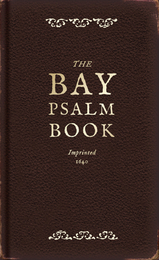 The Bay Psalm Book: A Facsimile
With an Introduction by Diarmaid MacCulloch
Bodleian Library Publishing, 2014 The Bay Psalm Book was the first book to be printed in North America, twenty years after the arrival of the Pilgrims in Massachusetts. Today, only eleven copies are still in existence and fetch as much as fourteen million dollars at auction, making it also the most expensive book in the world.
Originally published in 1640 as The Whole Booke of Psalmes Faithfully Translated into English Metre, the unassuming psalter undertook the translation of Hebrew psalms into English verse for a growing population of New England Puritans unhappy with contemporary translations and in need of a version that would better represent their beliefs. The book became popularly known as The Bay Psalm Book, named after the Massachusetts Bay Colony in which its translators—among them the ministers John Cotton and Richard Mather—lived.
This beautiful facsimile edition of The Bay Psalm Book reproduces one of the best remaining copies of the psalter, including the translators’ preface and the original printer’s errors and binding marks. An introduction by Diarmaid MacCulloch details the book’s place in American religious and cultural history and explains how the psalter came to have such a profound effect on the course of the Protestant faith in America.
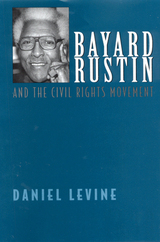 Bayard Rustin and the Civil Rights Movement
Levine, Daniel
Rutgers University Press, 1999 Best known as the man who organized the Great March on Washington in 1963, Bayard Rustin was a vital force in the civil rights movement from the 1940s through the 1980s. Rustins's activism embraced the wide range of crucial issues of his time: communism, international pacifism, and race relations.
Rustin's long activist career began with his association with A. Phillip Randolph of the Brotherhood of Sleeping Car Porters. Then, as a member of A. J. Muste's Fellowship of Reconciliation, he participated in the "Journey of Reconciliation" (an early version of the "Freedom Rides" of 1961). He was a close associate of Martin Luther King in Montgomery and Atlanta and rose to prominence as organizer of the 1963 March on Washington. Rustin played a key role in applying nonviolent direct action to American race relations while rejecting the separatism of movements like Black Power in the 1960s, even at the risk of his being marginalized by the younger generation of civil rights activists. In his later years he tried to hold the civil rights coalition together and to fight for the economic changes he thought were necessary to decrease racism.
Daniel Levine has written the first scholarly biography that examines Rustin's public as well as private persona in light of his struggles as a gay black man and as an activist who followed his own principles and convictions. The result is a rich portrait of a complex, indomitable advocate for justice in American society.
Bayou Salado: The Story of South Park, Revised Edition
Virginia McConnell Simmons
University Press of Colorado, 2002 First published in 1966, Bayou Salado is an engaging look at the history of a high cool valley in the Rocky Mountains. Now known as South Park, Bayou Salado once attracted Ute and Arapaho hunters as well as European and American explorers and trappers. Virginia McConnell Simmons's colorful accounts of some of the valley's more notable residents - such as Father Dyer, the skiing Methodist minister-mailman, and Silver Heels, the dancer who lost her legendary beauty while tending to the ill during a small pox epidemic - bring the valley's storied past to life.
 Bazaars & Fair Ladies: The History of the American Fundraising Fair
Beverly Gordon
University of Tennessee Press, 1998 Although women's charitable bazaars have contributed millions of dollars to important causes and institutions, they have long been thought of—by both historians and the public—as trivial events. Beverly Gordon corrects this view in Bazaars and Fair Ladies, the first history of women's fundraising fairs in the United States. Tracing their development from the early 1800s to the present day, Gordon show how women's fairs have reflected and influenced American culture, including styles of display and presentation, forms of public entertainment, attitudes about consumption and commodities, and perceptions of other cultures and of the past.
Gordon surveys the fundraising fair phenomenon through its various names and incarnations, including ladies' sales, ladies' fairs, fancy fairs, fetes, festivals, carnivals, boutiques, and church or charity bazaars, and the many causes these events have benefitted, such as abolition, suffrage, and war relief. Drawing on a wide variety of historical documents—newspaper and magazine accounts, souvenir programs, photos, scrapbooks—as well as on fictional representations, interviews with fairgivers, and participant observation, Gordon provides detailed descriptions of fairs characteristic of specific periods, recreating what it felt like to walk into a Civil War sanitary fair or into Boston's "Atlantic City Boardwalk" fair of 1922. Throughout, she analyzes the ways in which the fundraising fair functioned as a vehicle for aesthetic and social meaning, creating rich environments that celebrated communal bonds.
Gordon stresses the role women's bazaars played within the larger fair culture, demonstrating that many of the trends evident in American agricultural and trade fairs and international exhibitions had their origins in women's fundraisers. Highlighting changes in fair themes, aesthetic environments, consumer fashions, and critical responses from the public, Gordon also looks at similarities and differences among participants from varied ethnic and geographic communities. Gracefully written and abundantly illustrated, Gordon's study of this vital American cultural institution sheds light on 175 years of women's creativity, fellowship, and community-building.
The Author: Beverly Gordon is a professor in the Environment, Textiles, and Design Department and serves the folklore and women's studies programs at the University of Wisconsin–Madison. She is the author of several books, including Shaker Textile Arts and American Indian Art: The Collecting Experience.
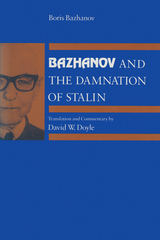 Bazhanov and the Damnation of Stalin
Boris Bazhanov
Ohio University Press, 1990 On January 1, 1928, Bazhanov escaped from the Soviet Union and became for many years the most important member of a new breed—the Soviet defector. At the age of 28, he had become an invaluable aid to Stalin and the Politburo, and had he stayed in Stalin’s service, Bazhanov might well have enjoyed the same meteoric careers as the man who replaced him when he left, Georgy Malenkov. However, Bazhanov came to despise the unethical and brutal regime he served. One he decided to become anti–communist, he sought to bring down the regime. Planning his departure carefully, he brought with him documentation which revealed some of the innermost secrets of the Kremlin. Despite being pursued by the OGPU (an earlier incarnation of the KGB), he arrived eventually in Paris, and Bazhanov set to work writing his message to the West. While Bazhanov did successfully escape to the West, Stalin had Bazhanov watched and several attempts were made to assassinate him. Bazhanov may have been fearful for his life much of the time, but he was a man of courage and conviction, and he damned Stalin as often and as publicly as he could. In this riveting and illuminating book, Bazhanov provides an eyewitness account of the inner workings and personalities of the Soviet Central Committee and the Politburo in the 1920s. Bazhanov clearly details how Stalin invaded the communications of his opponents, rigged votes, built up his own constituency, and maneuvered to achieve his coup d’etat despite formidable odds. he also provides a better understanding of the curiously vapid way in which he other revolutionary leaders, most notably Trotsky, failed to appreciate the threat and let Stalin override them. He reveals how those Soviets with a sense of fairness, justice, and ethics were extinguished by Stalin and his minions, and how the self–centered, protective bureaucratic machine was first built. Bazhanov’s view, at the right hand of Stalin, is unique and chilling. Bazhanov’s post–defection prediction of Stalin’s continuing and fatal danger to Trotsky shows how well Bazhanov understood the dictator. His formation, in 1940, of an armed force recruited from Soviet Army prisoners to help Mannerheim defend Finland from Stalin’s forces and his 1941 decision to decline the position of Hitler’s Gauleiter of German–occupied Russia are fascinating. But perhaps the most interesting facet to Bazhanov’s tale is the fact that almost no Soviets—even today—know the real story of the Communist party’s criminal acquiescence in Stalin’s rise to, and abuse of, power.
 Bazin on Global Cinema, 1948-1958
By André Bazin; translated and edited by Bert Cardullo
University of Texas Press, 2014 André Bazin is renowned for almost single-handedly establishing the study of film as an accepted intellectual pursuit, as well as for being the spiritual father of the French New Wave. In 1951 he cofounded and became editor-in-chief of Cahiers du cinéma, the most influential critical periodical in the history of cinema. Four of the film critics whom he mentored at the magazine later became the most acclaimed directors of the postwar French cinema—François Truffaut, Jean-Luc Godard, Jacques Rivette, and Claude Chabrol. Bazin is also considered the principal instigator of the influential auteur theory—the idea that, since film is an art form, the director of a movie must be perceived as the chief creator of its unique cinematic style. Bazin wrote some 2,600 articles and reviews, only about 150 of which are accessible in anthologies or edited collections. Bazin on Global Cinema, 1948–1958 offers English-language readers much of his writing on Asian cinema; previously untranslated essays on James Dean, the star system, political engagement and the cinema, and film criticism itself; and several reviews of film books, as well as reviews of notable American, British, and European movies, such as Johnny Guitar, High Noon, Umberto D., Hamlet, Kanal, and Le jour se lève (Daybreak). The book also features a contextual introduction to Bazin’s life and work, the first comprehensive bibliography of works by and about Bazin, credits of all the films he discusses in this book, and an extensive index.
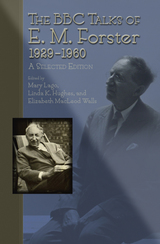 The BBC Talks of E.M. Forster, 1929-1960: A Selected Edition
Edited by Mary Lago, Linda K. Hughes & Elizabeth MacLeod Walls
University of Missouri Press, 2008 Spanning three decades and a host of subjects, E. M. Forster’s radio broadcasts for the BBC were a major contribution to British cultural history, yet today they are rarely acknowledged by scholars of his life and work. But in their day they reached a larger audience than his fiction and established him as a household figure not only in Britain but also in the farthest reaches of its Empire. As a frequent contributor to the BBC, Forster generally adhered to literary topics but did not shy away from social commentary. This book offers a new appreciation of his vitality and public importance through seventy annotated broadcasts that present him not only as a literary critic but also as a political activist, an advocate for India, and a wary yet cooperative ally of a colonialist government during World War II.
Gathering material either not in print or, if recast as essays, widely scattered, The BBC Talks of E. M. Forster reveals aspects of Forster’s intellect that have been given short shrift in previous studies. Nearly half the scripts date from 1941 to 1945 and provide an eyewitness account of war from a distinguished perspective. Forster comments on how the arts gallantly survived the blitz—even taking his listeners to the theater as bombing threats loom—and in other cases protests government interference in private life or the limits on free expression caused by the wartime paper shortage. In these scripts, Forster casts a cosmopolitan eye on contemporary literature from James Joyce to John Steinbeck and provides early exposure for young writers and composers. He also enlarges the scope of European art by pairing Jane Austen or C. S. Lewis with Indian writers and offers pointed comments on contemporary literati such as Aldous Huxley and T. S. Eliot. Annotations to each piece identify Forster’s references and trace his revisions from script to broadcast, while the book’s introduction places his emergence as a distinctive radio voice within the historical, creative, and institutional contexts of broadcasting in his day. This significant body of writing, too long overlooked, traces Forster’s evolution from novelist to adroit cultural critic and shows how a man who was never comfortable with machines played an important role in shaping a new medium. The BBC Talks of E. M. Forster situates Forster as one of the most poignant voices of the twentieth century as it offers new insight into a nation transfigured by war.
BBL vol 231 num 2
The University of Chicago Press
University of Chicago Press Journals, 2016
BBL vol 231 num 3
The University of Chicago Press
University of Chicago Press Journals, 2016
BBL vol 232 num 1
The University of Chicago Press
University of Chicago Press Journals, 2017
BBL vol 232 num 2
The University of Chicago Press
University of Chicago Press Journals, 2017
BBL vol 232 num 3
The University of Chicago Press
University of Chicago Press Journals, 2017
|
|
